Similar presentations:
2020 ESC Guidelines for the diagnosis and management of atrial fibrillation
1.
2020 ESC Guidelines for the diagnosisand management of atrial fibrillation
developed in collaboration with the
European Association for
Cardio-Thoracic Surgery (EACTS)
2.
2020 ESC Guidelines for the diagnosis andmanagement of atrial fibrillation developed in
collaboration with the European Association
for Cardio-Thoracic Surgery (EACTS)
Task Force Members:
1Representing
the European Association for Cardio-Thoracic Surgery (EACTS)
www.escardio.org/guidelines
2020 ESC Guidelines for the diagnosis and management of atrial fibrillation
(European Heart Journal 2020-doi/10.1093/eurheartj/ehaa612)
©ESC
Gerhard Hindricks (Chairperson) (Germany), Tatjana Potpara (Chairperson) (Serbia), Nikolaos Dagres
(Germany), Elena Arbelo (Spain), Jeroen J. Bax (Netherlands), Carina Blomström-Lundqvist (Sweden),
Giuseppe Boriani (Italy), Manuel Castella1 (Spain), Gheorghe-Andrei Dan (Romania), Polychronis E. Dilaveris
(Greece), Laurent Fauchier (France), Gerasimos Filippatos (Greece), Jonathan M. Kalman (Australia), Mark La
Meir1 (Belgium), Deirdre A. Lane (United Kingdom), Jean-Pierre Lebeau (France), Maddalena Lettino (Italy),
Gregory Y. H. Lip (United Kingdom), Fausto J. Pinto (Portugal), G. Neil Thomas (United Kingdom), Marco
Valgimigli (Switzerland), Isabelle C. Van Gelder (Netherlands), Bart P. Van Putte1 (Netherlands), Caroline L.
Watkins (United Kingdom).
2
3.
2020 ESC Guidelines for the diagnosis andmanagement of atrial fibrillation developed in
collaboration with the European Association
for Cardio-Thoracic Surgery (EACTS)
©ESC
ESC entities having participated in the development of this document:
Associations: Association for Acute CardioVascular Care (ACVC), Association of Cardiovascular Nursing &
Allied Professions (ACNAP), European Association of Cardiovascular Imaging (EACVI), European Association of
Preventive Cardiology (EAPC), European Association of Percutaneous Cardiovascular Interventions (EAPCI),
European Heart Rhythm Association (EHRA), Heart Failure Association (HFA).
Councils: Council on Stroke, Council on Valvular Heart Disease.
Working Groups: Cardiac Cellular Electrophysiology, Cardiovascular Pharmacotherapy, Cardiovascular
Surgery, e-Cardiology, Thrombosis.
www.escardio.org/guidelines
2020 ESC Guidelines for the diagnosis and management of atrial fibrillation
(European Heart Journal 2020-doi/10.1093/eurheartj/ehaa612)
3
4.
ESC Classes of recommendationsWording to use
Class I
Evidence and/or general agreement that a given
treatment or procedure is beneficial, useful,
effective.
Class II
Conflicting evidence and/or a divergence of opinion about the
usefulness/efficacy of the given treatment or procedure.
Is recommended
or is indicated
Class IIa
Weight of evidence/opinion is in favour
of usefulness/efficacy.
Should be considered
Class IIb
Usefulness/efficacy is less well
established by evidence/opinion.
May be considered
Class III
Evidence or general agreement that the given
treatment or procedure is not useful/effective,
and in some cases may be harmful.
www.escardio.org/guidelines
Is not recommended
2020 ESC Guidelines for the diagnosis and management of atrial fibrillation
(European Heart Journal 2020-doi/10.1093/eurheartj/ehaa612)
©ESC
Definition
5.
ESC Levels of evidenceData derived from multiple randomized clinical trials or meta-analyses.
Level of
evidence B
Data derived from a single randomized clinicaltrial or large nonrandomized studies.
Level of
evidence C
Consensus of opinion of the experts and/or small studies, retrospective
studies, registries.
©ESC
Level of
evidence A
www.escardio.org/guidelines
2020 ESC Guidelines for the diagnosis and management of atrial fibrillation
(European Heart Journal 2020-doi/10.1093/eurheartj/ehaa612)
6.
What is new in the 2020 Guidelines? New recommendations (1)Recommendations
Class
Recommendations for diagnosis of AF
ECG documentation is required to establish the diagnosis of AF.
A standard 12-lead ECG recording or a single-lead ECG tracing of ≥30 seconds
showing heart rhythm with no discernible repeating P waves and irregular RR
intervals (when atrioventricular conduction is not impaired) is diagnostic of clinical AF.
I
Recommendations for structured characterization of AF
IIa
©ESC
Structured characterization of AF, which includes clinical assessment of stroke risk,
symptom status, burden of AF, and evaluation of substrate, should be considered in all
AF patients, to streamline the assessment of AF patients at different healthcare levels,
inform treatment decision-making, and facilitate optimal management of AF patients.
www.escardio.org/guidelines
2020 ESC Guidelines for the diagnosis and management of atrial fibrillation
(European Heart Journal 2020-doi/10.1093/eurheartj/ehaa612)
7.
What is new in the 2020 Guidelines? New recommendations (2)Recommendations
Class
Recommendations for screening to detect AF
I
©ESC
When screening for AF it is recommended that:
The individuals undergoing screening are informed about the significance and
treatment implications of detecting AF.
A structured referral platform is organized for screen-positive cases for further
physician-led clinical evaluation to confirm the diagnosis of AF and provide
optimal management of patients with confirmed AF.
Definite diagnosis of AF in screen-positive cases is established only after the
physician reviews the single-lead ECG recording of ≥30 seconds or 12-lead ECG
and confirms that it shows AF.
www.escardio.org/guidelines
2020 ESC Guidelines for the diagnosis and management of atrial fibrillation
(European Heart Journal 2020-doi/10.1093/eurheartj/ehaa612)
8.
What is new in the 2020 Guidelines? New recommendations (3)Recommendations
Class
Recommendations about integrated AF management
It is recommended to routinely collect PROs to measure treatment success and
improve patient care.
I
Recommendations for the prevention of thromboembolic events in AF
Stroke and bleeding risk reassessment at periodic intervals is recommended to
inform treatment decisions (e.g. initiation of OAC in patients no longer at low risk of
stroke) and address potentially modifiable bleeding risk factors.
www.escardio.org/guidelines
IIa
I
2020 ESC Guidelines for the diagnosis and management of atrial fibrillation
(European Heart Journal 2020-doi/10.1093/eurheartj/ehaa612)
©ESC
For a formal risk-score−based assessment of bleeding risk, the HAS-BLED score
should be considered to help address modifiable bleeding risk factors, and to
identify patients at high risk of bleeding (HAS-BLED score ≥3) for early and more
frequent clinical review and follow-up.
9.
What is new in the 2020 Guidelines? New recommendations (4)Recommendations
Class
Recommendations for the prevention of thromboembolic events in AF (continued)
IIa
Estimated bleeding risk, in the absence of absolute contraindications to OAC, should
not in itself guide treatment decisions to use OAC for stroke prevention.
III
Clinical pattern of AF (i.e. first detected, paroxysmal, persistent, long-standing
persistent, permanent) should not condition the indication to thromboprophylaxis.
III
©ESC
In patients with AF initially at low risk of stroke, first reassessment of stroke risk
should be made 4−6 months after the index evaluation.
www.escardio.org/guidelines
2020 ESC Guidelines for the diagnosis and management of atrial fibrillation
(European Heart Journal 2020-doi/10.1093/eurheartj/ehaa612)
10.
What is new in the 2020 Guidelines? New recommendations (5)Recommendations
Class
Recommendations for cardioversion
I
For patients with sick-sinus syndrome, atrioventricular conduction disturbances or
prolonged QTc (>500 ms), pharmacological cardioversion should not be attempted
unless risks for proarrhythmia and bradycardia have been considered.
III
©ESC
Pharmacological cardioversion of AF is indicated only in a haemodynamically stable
patient, after consideration of the thromboembolic risk.
www.escardio.org/guidelines
2020 ESC Guidelines for the diagnosis and management of atrial fibrillation
(European Heart Journal 2020-doi/10.1093/eurheartj/ehaa612)
11.
What is new in the 2020 Guidelines? New recommendations (6)Recommendations
Class
Recommendations for rhythm control/catheter ablation of AF
General recommendations
Repeated PVI procedures should be considered in patients with AF recurrence
provided the patient’s symptoms were improved after the initial PVI.
AF catheter ablation after antiarrhythmic drug therapy failure
AF catheter ablation for PVI should be considered for rhythm control after one
failed or intolerant to beta-blocker treatment to improve symptoms of AF
recurrences in patients with paroxysmal and persistent AF.
www.escardio.org/guidelines
I
IIa
IIa
2020 ESC Guidelines for the diagnosis and management of atrial fibrillation
(European Heart Journal 2020-doi/10.1093/eurheartj/ehaa612)
©ESC
For the decision on AF catheter ablation, it is recommended to take into
consideration the procedural risks and the major risk factors for AF recurrence
following the procedure and discuss them with the patient.
12.
What is new in the 2020 Guidelines? New recommendations (7)Recommendations
Class
Recommendations for rhythm control/catheter ablation of AF (continued)
First-line therapy
AF catheter ablation for PVI should/may be considered as first-line rhythm control
therapy to improve symptoms in selected patients with symptomatic:
• Paroxysmal AF episodes, or
IIa
• Persistent AF without major risk factors for AF recurrence as an alternative to AAD
class I or III, considering patient choice, benefit, and risk.
IIb
Techniques and technologies
www.escardio.org/guidelines
IIb
2020 ESC Guidelines for the diagnosis and management of atrial fibrillation
(European Heart Journal 2020-doi/10.1093/eurheartj/ehaa612)
©ESC
Use of additional ablation lesions beyond PVI (low voltage areas, lines, fragmented
activity, ectopic foci, rotors, and others) may be considered but is not well established.
13.
What is new in the 2020 Guidelines? New recommendations (8)Recommendations
Class
Recommendations for rhythm control/catheter ablation of AF (continued)
Lifestyle modification and other strategies to improve outcomes of ablation
Strict control of risk factors and avoidance of triggers are recommended as part of
rhythm control strategy.
I
It is recommended that the importance of adherence and persistence to NOAC
treatment both before and after cardioversion is strongly emphasized to patients.
I
In patients with AF duration of >24 hours undergoing cardioversion, therapeutic
anticoagulation should be continued for at least 4 weeks even after successful
cardioversion to sinus rhythm (beyond 4 weeks, the decision about long-term OAC
treatment is determined by the presence of stroke risk factors).
IIa
www.escardio.org/guidelines
2020 ESC Guidelines for the diagnosis and management of atrial fibrillation
(European Heart Journal 2020-doi/10.1093/eurheartj/ehaa612)
©ESC
Recommendations for stroke risk management peri cardioversion
14.
What is new in the 2020 Guidelines? New recommendations (9)Recommendations
Class
Recommendations for stroke risk management peri cardioversion (continued)
In patients with a definite duration of AF ≤24 hours and a very low stroke risk
(CHA2DS2-VASc of 0 in men or 1 in women) post-cardioversion anticoagulation for 4
weeks may be omitted.
IIb
Recommendations for stroke risk management peri catheter ablation
• Alternatively, the use of TOE to exclude LA thrombus before ablation.
For patients undergoing AF catheter ablation who have been therapeutically
anticoagulated with warfarin, dabigatran, rivaroxaban, apixaban, or edoxaban,
performance of the ablation procedure without OAC interruption is recommended.
www.escardio.org/guidelines
I
IIa
I
2020 ESC Guidelines for the diagnosis and management of atrial fibrillation
(European Heart Journal 2020-doi/10.1093/eurheartj/ehaa612)
©ESC
In AF patients with stroke risk factors not taking OAC before ablation, it is recommended
that preprocedural management of stroke risk includes initiation of anticoagulation and:
• Preferably, therapeutic OAC for at least 3 weeks before ablation, or
15.
What is new in the 2020 Guidelines? New recommendations (10)Recommendations
Class
Recommendations for long-term AADs
In AF patients treated with sotalol, close monitoring of QT interval, serum
potassium levels, CrCl, and other proarrhythmia risk factors is recommended.
I
IIa
Sotalol may be considered for long-term rhythm control in patients with normal LV
function or with ischaemic heart disease if close monitoring of QT interval, serum
potassium levels, CrCl, and other proarrhythmia risk factors is provided.
IIb
©ESC
In AF patients treated with flecainide for long-term rhythm control, concomitant
use of an atrioventricular nodal-blocking drug (if tolerated) should be considered.
www.escardio.org/guidelines
2020 ESC Guidelines for the diagnosis and management of atrial fibrillation
(European Heart Journal 2020-doi/10.1093/eurheartj/ehaa612)
16.
What is new in the 2020 Guidelines? New recommendations (11)Recommendations
Class
Recommendations for lifestyle interventions and management of risk factors and
concomitant diseases in AF
I
Modification of unhealthy lifestyle and targeted therapy of intercurrent conditions
is recommended to reduce AF burden and symptom severity.
I
Opportunistic screening for AF is recommended in hypertensive patients.
I
Opportunistic screening for AF should be considered in patients with OSA.
IIa
©ESC
Identification and management of risk factors and concomitant diseases is
recommended as an integral part of treatment in AF patients.
www.escardio.org/guidelines
2020 ESC Guidelines for the diagnosis and management of atrial fibrillation
(European Heart Journal 2020-doi/10.1093/eurheartj/ehaa612)
17.
What is new in the 2020 Guidelines? New recommendations (12)Recommendations
Class
Recommendations for patients with AF and an ACS, PCI, or CCS
Recommendations for AF patients with ACS
In AF patients with ACS undergoing an uncomplicated PCI, early cessation (≤1 week) of
aspirin and continuation of dual therapy with an OAC and a P2Y12 inhibitor (preferably
clopidogrel) for up to 12 months is recommended if the risk of stent thrombosis is low or
if concerns about bleeding risk prevail over concerns about risk of stent thrombosis,
irrespective of the type of stent used.
I
Recommendations in AF patients with a CCS undergoing PCI
www.escardio.org/guidelines
I
2020 ESC Guidelines for the diagnosis and management of atrial fibrillation
(European Heart Journal 2020-doi/10.1093/eurheartj/ehaa612)
©ESC
After uncomplicated PCI, early cessation (≤1 week) of aspirin and continuation of dual
therapy with OAC for up to 6 months and clopidogrel is recommended if the risk of stent
thrombosis is low or if concerns about bleeding risk prevail over concerns about risk of
stent thrombosis, irrespective of the type of stent used.
18.
What is new in the 2020 Guidelines? New recommendations (13)Recommendations
Class
Recommendations for the management of active bleeding on OAC
Four-factor prothrombin complex concentrates should be considered in AF patients
on VKA who develop a severe bleeding complication.
IIa
Recommendations for the management of AF during pregnancy
Acute management
IIa
Ibutilide or flecainide i.v. may be considered for termination of AF in stable patients
with structurally normal hearts.
IIb
©ESC
In pregnant women with HCM, cardioversion should be considered for persistent AF.
www.escardio.org/guidelines
2020 ESC Guidelines for the diagnosis and management of atrial fibrillation
(European Heart Journal 2020-doi/10.1093/eurheartj/ehaa612)
19.
What is new in the 2020 Guidelines? New recommendations (14)Recommendations
Recommendations for the management of AF during pregnancy
Long-term management (oral administration of drugs)
Flecainide, propafenone, or sotalol should be considered to prevent AF if
atrioventricular nodal-blocking drugs fail.
Digoxin or verapamil should be considered for rate control if beta-blockers fail.
Class
IIa
IIa
Recommendations for postoperative AF
www.escardio.org/guidelines
IIa
III
2020 ESC Guidelines for the diagnosis and management of atrial fibrillation
(European Heart Journal 2020-doi/10.1093/eurheartj/ehaa612)
©ESC
Long-term OAC therapy to prevent thromboembolic events should be considered in
patients at risk for stroke with postoperative AF after non-cardiac surgery,
considering the anticipated net clinical benefit of OAC and informed patient
preferences.
Beta-blockers should not be used routinely for the prevention of postoperative AF
in patients undergoing non-cardiac surgery.
20.
What is new in the 2020 Guidelines? New recommendations (15)Recommendations
Class
Recommendations pertaining to sex-related differences in AF
Women with symptomatic paroxysmal or persistent AF should be offered timely
access to rhythm control therapies, including AF catheter ablation, when
appropriate for medical reasons.
IIa
Recommendations for quality measures in AF
IIa
©ESC
The introduction of tools to measure quality of care and identify opportunities for
improved treatment quality and AF patient outcome should be considered by
practitioners and institutions.
www.escardio.org/guidelines
2020 ESC Guidelines for the diagnosis and management of atrial fibrillation
(European Heart Journal 2020-doi/10.1093/eurheartj/ehaa612)
21.
Changes in the recommendations (1)Recommendations about integrated AF management
To optimize shared decision-making
about specific AF treatment option(s) in
consideration, it is recommended that:
• Physicians inform the patient about
advantages/limitations and
benefit/risks associated with
considered treatment option(s); and
• Discuss the potential burden of the
treatment with the patient and
include the patient’s perception of
treatment burden into the treatment
decision.
www.escardio.org/guidelines
Class
2016
Class
Placing patients in a central role in
decision-making should be considered
in order to tailor management to
patient preferences and improve
adherence to long-term therapy
I
IIa
©ESC
2020
2020 ESC Guidelines for the diagnosis and management of atrial fibrillation
(European Heart Journal 2020-doi/10.1093/eurheartj/ehaa612)
22.
Changes in the recommendations (2)Recommendations for the prevention of thromboembolic events in AF
For bleeding risk assessment, a
formal structured risk-score−based
bleeding risk assessment is
recommended to help identify nonmodifiable and address modifiable
bleeding risk factors in all AF patients,
and to identify patients potentially at
high risk of bleeding who should be
scheduled for early and more
frequent clinical review and follow-up.
www.escardio.org/guidelines
Class
I
2016
Bleeding risk scores should be
considered in AF patients on oral
anticoagulation to identify
modifiable risk factors for major
bleeding.
Class
IIa
©ESC
2020
2020 ESC Guidelines for the diagnosis and management of atrial fibrillation
(European Heart Journal 2020-doi/10.1093/eurheartj/ehaa612)
23.
Changes in the recommendations (3)Recommendations for the prevention of thromboembolic events in AF (continued)
2020
In patients on VKAs with low time in
INR therapeutic range (e.g. TTR
<70%), recommended options are:
• Switching to a NOAC but ensuring
good adherence and persistence
with therapy; or
I
2016
AF patients already on treatment
with a VKAs may be considered for
NOAC treatment if TTR is not well
controlled despite good adherence,
or if patient preference without
contraindications to NOAC (e.g.
prosthetic valve).
Class
IIb
IIa
©ESC
• Efforts to improve TTR (e.g.
education/counselling and more
frequent INR checks).
Class
www.escardio.org/guidelines
2020 ESC Guidelines for the diagnosis and management of atrial fibrillation
(European Heart Journal 2020-doi/10.1093/eurheartj/ehaa612)
24.
Changes in the recommendations (4)Recommendations for rhythm control/catheter ablation of AF
AF catheter ablation after drug therapy failure
AF catheter ablation for PVI is
recommended for rhythm control
after one failed or intolerant class I or
III AAD, to improve symptoms of AF
recurrences in patients with:
• Paroxysmal AF, or
• Persistent AF without major risk
factors for AF recurrence, or
• Persistent AF with major risk factors
for AF recurrence.
www.escardio.org/guidelines
Class
I
2016
Catheter or surgical ablation should
be considered in patients with
symptomatic persistent or longstanding persistent AF refractory to
AAD therapy to improve symptoms,
considering patient choice, benefit
and risk, supported by an AF Heart
Team.
Class
IIa
©ESC
2020
2020 ESC Guidelines for the diagnosis and management of atrial fibrillation
(European Heart Journal 2020-doi/10.1093/eurheartj/ehaa612)
25.
Changes in the recommendations (5)Recommendations for rhythm control/catheter ablation of AF (continued)
First-line therapy
Class
AF catheter ablation:
• Is recommended to reverse LV
dysfunction in AF patients when
tachycardia-induced cardiomyopathy
is highly probable, independent of
their symptom status.
I
• Should be considered in selected AF
patients with HFrEF to improve
survival and reduce HF hospitalization.
IIa
www.escardio.org/guidelines
2016
AF ablation should be considered in
symptomatic patients with AF and
HFrEF to improve symptoms and
cardiac function when
tachycardiomyopathy is suspected.
Class
IIa
©ESC
2020
2020 ESC Guidelines for the diagnosis and management of atrial fibrillation
(European Heart Journal 2020-doi/10.1093/eurheartj/ehaa612)
26.
Changes in the recommendations (6)Recommendations for rhythm control/catheter ablation of AF (continued)
Techniques and technologies
Complete electrical isolation of the
pulmonary veins is recommended
during all AF catheter-ablation
procedures.
If patient has a history of CTIdependent atrial flutter or if typical
atrial flutter is induced at the time of
AF ablation, delivery of a CTI lesion
may be considered.
www.escardio.org/guidelines
Class
I
IIb
2016
Class
Catheter ablation should target
isolation of the pulmonary veins
using radiofrequency ablation or
cryothermy balloon catheters.
IIa
Ablation of common atrial flutter
should be considered to prevent
recurrent flutter as part of an AF
ablation procedure if documented or
occurring during the AF ablation.
IIa
2020 ESC Guidelines for the diagnosis and management of atrial fibrillation
(European Heart Journal 2020-doi/10.1093/eurheartj/ehaa612)
©ESC
2020
27.
Changes in the recommendations (7)Recommendations for rhythm control/catheter ablation of AF (continued)
Lifestyle modification and other strategies to improve outcomes of ablation
2020
Weight loss is recommended in obese
patients with AF, particularly those
who are being evaluated to undergo
AF ablation.
Class
2016
Class
I
In obese patients with AF, weight loss
together with management of other
risk factors should be considered to
reduce AF burden and symptoms.
IIa
Recommendations for stroke risk management peri cardioversion
www.escardio.org/guidelines
I
Anticoagulation with heparin or a
NOAC should be initiated as soon as
possible before every cardioversion of
AF or atrial flutter.
IIa
2020 ESC Guidelines for the diagnosis and management of atrial fibrillation
(European Heart Journal 2020-doi/10.1093/eurheartj/ehaa612)
©ESC
In patients with AF undergoing
cardioversion, NOACs are
recommended with at least similar
efficacy and safety as warfarin.
28.
Changes in the recommendations (8)Recommendations for stroke risk management peri catheter ablation
After AF catheter ablation, it is
recommended that:
• Systemic anticoagulation with
warfarin or a NOAC is continued for
at least 2 months post ablation, and
• Long-term continuation of systemic
anticoagulation beyond 2 months
post ablation is based on the
patient’s stroke risk profile and not
on the apparent success or failure
of the ablation procedure.
www.escardio.org/guidelines
Class
2016
Class
All patients should receive oral
anticoagulation for at least 8 weeks
after catheter ablation.
I
IIa
©ESC
2020
2020 ESC Guidelines for the diagnosis and management of atrial fibrillation
(European Heart Journal 2020-doi/10.1093/eurheartj/ehaa612)
29.
Changes in the recommendations (9)Recommendations for long-term antiarrhythmic drugs
2020
2016
Class
I
Amiodarone is more effective in
preventing AF recurrences than
other AAD, but extracardiac toxic
effects are common and increase
with time. For this reason, other AAD
should be considered first.
IIa
©ESC
Amiodarone is recommended for
long-term rhythm control in all AF
patients, including those with HFrEF.
However, owing to its extracardiac
toxicity, other AADs should be
considered first whenever possible.
Class
www.escardio.org/guidelines
2020 ESC Guidelines for the diagnosis and management of atrial fibrillation
(European Heart Journal 2020-doi/10.1093/eurheartj/ehaa612)
30.
Changes in the recommendations (10)Recommendations for lifestyle interventions and management of risk factors and
concomitant diseases in patients with AF
Attention to good BP control is
recommended in AF patients with
hypertension to reduce AF
recurrences and risk of stroke and
bleeding.
Physical activity should be considered
to help prevent AF incidence or
recurrence, with the exception of
excessive endurance exercise, which
may promote AF.
www.escardio.org/guidelines
Class
I
IIa
2016
Blood pressure control in
anticoagulated patients with
hypertension should be considered
to reduce the risk of bleeding
Moderate regular physical activity is
recommended to prevent AF, while
athletes should be counselled that
long-lasting intense sports
participation can promote AF
Class
IIa
I
2020 ESC Guidelines for the diagnosis and management of atrial fibrillation
(European Heart Journal 2020-doi/10.1093/eurheartj/ehaa612)
©ESC
2020
31.
Changes in the recommendations (11)Recommendations for lifestyle interventions and management of risk factors and
concomitant diseases in patients with AF (continued)
2020
IIb
2016
OSA treatment should be optimized
to reduce AF recurrences and
improve AF treatment results.
Class
IIa
©ESC
Optimal management of OSA may be
considered, to reduce AF incidence,
AF progression, AF recurrences, and
symptoms.
Class
www.escardio.org/guidelines
2020 ESC Guidelines for the diagnosis and management of atrial fibrillation
(European Heart Journal 2020-doi/10.1093/eurheartj/ehaa612)
32.
Changes in the recommendations (12)Recommendations for stroke prevention in AF patients after ICH
In AF patients at high risk of ischaemic
stroke, (re-)initiation of OAC, with
preference for NOACs over VKAs in
NOAC-eligible patients, should be
considered in consultation with a
neurologist/stroke specialist after:
• A trauma-related ICH
• Acute spontaneous ICH (which
includes subdural, subarachnoid, or
intracerebral haemorrhage), after
careful consideration of risks and
benefits.
www.escardio.org/guidelines
Class
2016
Class
After ICH, oral anticoagulation in
patients with AF may be reinitiated
after 4–8 weeks provided the cause of
bleeding or the relevant risk factor has
been treated or controlled.
IIa
IIb
©ESC
2020
2020 ESC Guidelines for the diagnosis and management of atrial fibrillation
(European Heart Journal 2020-doi/10.1093/eurheartj/ehaa612)
33.
Changes in the recommendations (13)Recommendations for postoperative AF
2020
IIb
2016
Long-term anticoagulation should be
considered in patients with AF after
cardiac surgery at risk for stroke,
considering individual stroke and
bleeding risk.
Class
IIa
©ESC
Long-term OAC therapy to prevent
thromboembolic events may be
considered in patients at risk for
stroke with postoperative AF after
cardiac surgery, considering the
anticipated net clinical benefit of OAC
therapy and informed patient
preferences.
Class
www.escardio.org/guidelines
2020 ESC Guidelines for the diagnosis and management of atrial fibrillation
(European Heart Journal 2020-doi/10.1093/eurheartj/ehaa612)
34.
Table 3 Definition of atrial fibrillation (1)Definition
AF
A supraventricular tachyarrhythmia with uncoordinated atrial electrical
activation and consequently ineffective atrial contraction.
Electrocardiographic characteristics of AF include:
• Irregularly irregular R-R intervals (when atrioventricular conduction is not
impaired),
• Absence of distinct repeating P waves, and
• Irregular atrial activations.
Clinical AF
Symptomatic or asymptomatic AF that is documented by surface ECG.
The minimum duration of an ECG tracing of AF required to establish the
diagnosis of clinical AF is at least 30 seconds, or entire 12-lead ECG.
www.escardio.org/guidelines
2020 ESC Guidelines for the diagnosis and management of atrial fibrillation
(European Heart Journal 2020-doi/10.1093/eurheartj/ehaa612)
©ESC
Currently used terms
35.
Table 3 Definition of atrial fibrillation (2)Currently used terms (continued)
Atrial high rate
episode
(AHRE),
subclinical AF
Refers to individuals without symptoms attributable to AF, in whom clinical
AF is NOT previously detected (that is, there is no surface ECG tracing of AF).
AHRE − events fulfilling programmed or specified criteria for AHRE that are
detected by CIEDs with an atrial lead allowing automated continuous
monitoring of atrial rhythm and tracings storage. CIED-recorded AHRE need
to be visually inspected because some AHRE may be electrical
artefacts/false positives.
©ESC
Subclinical AF includes AHRE confirmed to be AF, AFL, or an AT, or AF episodes
detected by insertable cardiac monitor or wearable monitor and confirmed by
visually reviewed intracardiac electrograms or ECG-recorded rhythm.
www.escardio.org/guidelines
2020 ESC Guidelines for the diagnosis and management of atrial fibrillation
(European Heart Journal 2020-doi/10.1093/eurheartj/ehaa612)
36.
Recommendations for diagnosis of AFRecommendations
Level
I
B
©ESC
ECG documentation is required to establish the diagnosis of AF.
• A standard 12-lead ECG recording or a single-lead ECG tracing of
≥30 seconds showing heart rhythm with no discernible repeating P waves
and irregular RR intervals (when atrioventricular conduction is not impaired)
is diagnostic of clinical AF.
Class
www.escardio.org/guidelines
2020 ESC Guidelines for the diagnosis and management of atrial fibrillation
(European Heart Journal 2020-doi/10.1093/eurheartj/ehaa612)
37.
©ESCwww.escardio.org/guidelines
CIEDs with an atrial lead can monitor atrial rhythm and store
the tracings. ICM have no intra-cardiac leads but
continuously monitor cardiac electrical activity by recording
and analysing a single-lead bipolar surface ECG based on
specific algorithm.
Left-bottom image: pacemaker with a right atrial lead, and a
ventricular lead in the right ventricular apex. In addition
to pacing at either site, these leads can sense activity in the
respective cardiac chamber. The device can also detect
pre-programmed events, such as AHRE.
Right-bottom image: subcutaneous ICM: these devices have
no intra-cardiac leads and essentially record a single, bipolar,
surface ECG with inbuilt algorithms for detection of AHRE or
AF.
2020 ESC Guidelines for the diagnosis and management of atrial fibrillation
(European Heart Journal 2020-doi/10.1093/eurheartj/ehaa612)
©ESC
Figure 1 Diagnosis of
AHRE/subclinical atrial
fibrillation
38.
©ESCFigure 2 (1) Epidemiology of AF: prevalence
www.escardio.org/guidelines
2020 ESC Guidelines for the diagnosis and management of atrial fibrillation
(European Heart Journal 2020-doi/10.1093/eurheartj/ehaa612)
39.
Figure 2 (2)Epidemiology of AF:
lifetime risk and
projected rise in the
incidence and
prevalence
alcohol consumption, body mass index, BP,
diabetes mellitus (type 1 or 2), and history of myocardial
infarction or heart failure. bRisk profile: optimal − all risk
factors are negative or within the normal range; borderline −
no elevated risk factors but >1 borderline risk factor;
elevated − >1 elevated risk factor.
www.escardio.org/guidelines
2020 ESC Guidelines for the diagnosis and management of atrial fibrillation
(European Heart Journal 2020-doi/10.1093/eurheartj/ehaa612)
©ESC
aSmoking,
40.
©ESCFigure 3 Summary of risk factors for incident AF
www.escardio.org/guidelines
2020 ESC Guidelines for the diagnosis and management of atrial fibrillation
(European Heart Journal 2020-doi/10.1093/eurheartj/ehaa612)
41.
©ESCFigure 4 Clinical
presentation of AF and
AF-related outcomes
©ESC
www.escardio.org/guidelines
2020 ESC Guidelines for the diagnosis and management of atrial fibrillation
(European Heart Journal 2020-doi/10.1093/eurheartj/ehaa612)
42.
Table 4 Classification of AF (1)Definition
First
diagnosed
AF not diagnosed before, irrespective of its duration or the presence/severity of
AF-related symptoms.
Paroxysmal
AF that terminates spontaneously or with intervention within 7 days of onset.
Persistent
AF that is continuously sustained beyond 7 days, including episodes that are terminated
by cardioversion (drugs or direct current cardioversion) after 7 days or more.
Long-standing
persistent
Continuous AF of >12 months’ duration when decided to adopt a rhythm control strategy.
Permanent
AF that is accepted by the patient and physician, and no further attempts to restore/maintain
sinus rhythm will be undertaken. Permanent AF represents a therapeutic attitude of the
patient and physician rather than an inherent pathophysiological attribute of AF, and the
term should not be used in the context of a rhythm control strategy with antiarrhythmic drug
therapy or AF ablation. Should a rhythm control strategy be adopted, the arrhythmia would
be re-classified as ‘long-standing persistent AF’.
www.escardio.org/guidelines
2020 ESC Guidelines for the diagnosis and management of atrial fibrillation
(European Heart Journal 2020-doi/10.1093/eurheartj/ehaa612)
©ESC
AF pattern
43.
Table 4 Classification of AF (2)Terminology that should be abandoned
AF pattern
Definition
A historical descriptor. Increasing knowledge about the pathophysiology of AF shows that
in every patient a cause is present. Hence, this term is potentially confusing and should be
abandoned.
Valvular/nonvalvular AF
Differentiates patients with moderate/severe mitral stenosis and those with mechanical
prosthetic heart valve(s) from other patients with AF, but may be confusing and should
not be used.
Chronic AF
Has variable definitions and should not be used to describe populations of AF patients.
©ESC
Lone AF
www.escardio.org/guidelines
2020 ESC Guidelines for the diagnosis and management of atrial fibrillation
(European Heart Journal 2020-doi/10.1093/eurheartj/ehaa612)
44.
©ESCwww.escardio.org/guidelines
2020 ESC Guidelines for the diagnosis and management of atrial fibrillation
(European Heart Journal 2020-doi/10.1093/eurheartj/ehaa612)
©ESC
©ESC
Figure 5 4S-AF scheme as an example of structured
characterization of AF
45.
Recommendations for structured characterization of AFRecommendations
Level
IIa
C
©ESC
Structured characterization of AF, which includes clinical assessment of
stroke risk, symptom status, burden of AF, and evaluation of substrate,
should be considered in all AF patients, to streamline the assessment of AF
patients at different healthcare levels, inform treatment decision-making,
and facilitate optimal management of AF patients.
Class
www.escardio.org/guidelines
2020 ESC Guidelines for the diagnosis and management of atrial fibrillation
(European Heart Journal 2020-doi/10.1093/eurheartj/ehaa612)
46.
©ESCwww.escardio.org/guidelines
Pulse palpation, automated BP monitors, single-lead ECG devices, PPG devices, other sensors (using
seismocardiography, accelerometers, and gyroscopes, etc.) used in applications for smartphones,
wrist bands, and watches. Intermittent smartwatch detection through PPG or ECG recordings.
Smartwatches and other ‘wearables’ can passively measure pulse rate from the wrist using an optical
sensor for PPG and alerting the consumer of a pulse irregularity (based on a specific algorithm for AF
detection analysing pulse irregularity and variability
2020 ESC Guidelines for the diagnosis and management of atrial fibrillation
(European Heart Journal 2020-doi/10.1093/eurheartj/ehaa612)
©ESC
Figure 6 Systems used for AF screening
47.
Table 5 Sensitivity and specificity of various AF screening toolsconsidering the 12-lead ECG as the gold standard
Specificity
Pulse taking
87−97%
70−81%
Automated BP
monitors
93−100%
86−92%
Single lead ECG
94−98%
76−95%
Smartphone apps
91.5−98.5%
91.4−100%
Watches
97−99%
83−94%
©ESC
Sensitivity
www.escardio.org/guidelines
2020 ESC Guidelines for the diagnosis and management of atrial fibrillation
(European Heart Journal 2020-doi/10.1093/eurheartj/ehaa612)
48.
Figure 7 Potential benefits from and risks of screening for AFAF SCREENING
•Abnormal results may cause anxiety
•ECG misinterpretation results may
lead to overdiagnosis and
overtreatment
•ECG may detect other abnormalities
(true or false positives) that may
lead to invasive tests and
treatments that have the potential
for serious harm (e.g., angiography /
revascularisation with bleeding,
contrast-induced nephropathy and
allergic reactions to the contrast)
www.escardio.org/guidelines
BENEFITS
Prevention of:
• Stroke/SE using OAC in patients at risk
• Subsequent onset of symptoms
Prevention/reversal of:
• Electrical/mechanical atrial remodelling
• AF-related haemodynamic derangements
• Atrial and ventricular tachycardia-induced cardiopmyopathy
Prevention/reduction of:
• AF-related morbidity; hospitalization; mortality
Reduction of:
• The outcomes associated with conditions / diseases associated with AF that
are discovered and treated as a consequence of the examinations prompted by
AF detection
2020 ESC Guidelines for the diagnosis and management of atrial fibrillation
(European Heart Journal 2020-doi/10.1093/eurheartj/ehaa612)
©ESC
RISKS
49.
RecommendationsClass
Level
Opportunistic screening for AF by pulse taking or ECG rhythm strip is
recommended in patients ≥65 years of age.
I
B
It is recommended to interrogate pacemakers and implantable cardioverter
defibrillators on a regular basis for AHRE.a
I
B
aSee
sections for diagnostic criteria for AF and AHRE, and for the management of patients with AHRE.
www.escardio.org/guidelines
2020 ESC Guidelines for the diagnosis and management of atrial fibrillation
(European Heart Journal 2020-doi/10.1093/eurheartj/ehaa612)
©ESC
Recommendations for screening to detect AF (1)
50.
Recommendations for screening to detect AF (2)Recommendations
When screening for AF it is recommended that:
• The individuals undergoing screening are informed about the significance
and treatment implications of detecting AF.
• A structured referral platform is organized for screen-positive cases for
further physician-led clinical evaluation to confirm the diagnosis of AF and
provide optimal management of patients with confirmed AF.
• Definite diagnosis of AF in screen-positive cases is established only after
physician reviews the single-lead ECG recording of ≥30 seconds or 12-lead
ECG and confirms that it shows AF.
Level
I
B
IIa
B
©ESC
Systematic ECG screening should be considered to detect AF in individuals
aged ≥75 years, or those at high risk of stroke.
Class
www.escardio.org/guidelines
2020 ESC Guidelines for the diagnosis and management of atrial fibrillation
(European Heart Journal 2020-doi/10.1093/eurheartj/ehaa612)
51.
Figure 8 Diagnostic work-up and follow-up in AF patientsMedical history:
• AF-related symptoms
• AF pattern
• Concomitant conditions
• CHA2DS2-VASc score
12-lead ECG
Thyroid and kidney function,
electrolytes and full blood
count
Transthoracic
echocardiography
www.escardio.org/guidelines
Selected AF patients
Structured follow-up
Ambulatory ECG monitoring:
• Adequacy of rate control
• Relate symptoms to AF recurrences
• To ensure continued optimal
management
Transoesophageal echocardiography:
• Valvular heart disease
• LAA thrombus
cTnT-hs, CRP, BNP/NT-ProBNP
Cognitive function assessment
• A cardiologist / AF specialist
coordinates the follow-up in
collaboration with specially
trained nurses and primary
care physicians
Coronary CTA or ischaemia imaging:
• Patients with suspected CAD
Brain CT and MRI:
• Patients with suspected stroke
LGE-CMR of the LA:
• To help decision-making in AF
treatment
2020 ESC Guidelines for the diagnosis and management of atrial fibrillation
(European Heart Journal 2020-doi/10.1093/eurheartj/ehaa612)
©ESC
All AF patients
52.
Table 6 EHRA symptom scaleSymptoms
Description
1
None
AF does not cause any symptoms
2a
Mild
Normal daily activity not affected by symptoms related to AF
2b
Moderate
Normal daily activity not affected by symptoms related to AF, but
patient troubled by symptoms
3
Severe
Normal daily activity affected by symptoms related to AF
4
Disabling
Normal daily activity discontinued
©ESC
Score
www.escardio.org/guidelines
2020 ESC Guidelines for the diagnosis and management of atrial fibrillation
(European Heart Journal 2020-doi/10.1093/eurheartj/ehaa612)
53.
Figure 9Imaging in AF
©ESC
2020 ESC Guidelines for the diagnosis and management of atrial fibrillation
(European Heart Journal 2020-doi/10.1093/eurheartj/ehaa612)
54.
Recommendations for diagnostic evaluation of patients with AFRecommendations
Level
I
C
©ESC
In patients with AF, it is recommended to:
• Evaluate AF-related symptoms (including fatigue, tiredness, exertional
shortness of breath, palpitations, and chest pain) and quantify the patient
symptom status using the modified EHRA symptom scale before and after
initiation of treatment.
• Evaluate AF-related symptoms before and after cardioversion of persistent
AF to aid rhythm control treatment decisions.
Class
www.escardio.org/guidelines
2020 ESC Guidelines for the diagnosis and management of atrial fibrillation
(European Heart Journal 2020-doi/10.1093/eurheartj/ehaa612)
55.
©ESCwww.escardio.org/guidelines
2020 ESC Guidelines for the diagnosis and management of atrial fibrillation
(European Heart Journal 2020-doi/10.1093/eurheartj/ehaa612)
©ESC
Figure 10 Components of integrated AF management
56.
©ESCwww.escardio.org/guidelines
2020 ESC Guidelines for the diagnosis and management of atrial fibrillation
(European Heart Journal 2020-doi/10.1093/eurheartj/ehaa612)
©ESC
Figure 11
Integrated AF
management team
(an example)
57.
RecommendationsClass
Level
To optimize shared decision-making about specific AF treatment option(s) in
consideration, it is recommended that physicians:
• Inform the patient about the advantages/limitations and benefit/risks
associated with the treatment option(s) being considered; and
• Discuss the potential burden of the treatment with the patient and include
the patient’s perception of treatment burden into the treatment decision.
I
C
It is recommended to routinely collect PROs to measure treatment success
and improve patient care.
I
C
Integrated management with a structured multidisciplinary approach
including healthcare professionals, patients, and their family/carers, should
be used in all AF patients to improve clinical outcomes.
IIa
B
www.escardio.org/guidelines
2020 ESC Guidelines for the diagnosis and management of atrial fibrillation
(European Heart Journal 2020-doi/10.1093/eurheartj/ehaa612)
©ESC
Recommendations about integrated AF management
58.
Table 7 Stroke risk factors in patients with AFPositive
studies/All
studies
Other clinical
risk factors
Imaging biomarkers
Blood/urine
biomarkers
Stroke/TIA/systemic
embolism
15/16
Impaired renal function/CKD
Echocardiography
Hypertension
11/20
OSA
Ageing (per decade)
9/13
Hypertrophic cardiomyopathy
Structural heart
disease
9/13
Amyloidosis in degenerative
cerebral and heart diseases
LA dilatation
Spontaneous contrast
or thrombus in LA
Low LAA velocities
Complex aortic plaque
Diabetes mellitus
9/14
Hyperlipidaemia
Vascular disease
6/17
Smoking
Cerebral imaging
Cardiac troponin T and I
Natriuretic peptides
Cystatin C
Proteinuria
CrCl/eGFR
CRP
IL-6
GDF-15
von Willebrand factor
D-dimer
CHF/LV dysfunction
7/18
Metabolic syndrome
Small-vessel disease
Sex category (female)
8/22
Malignancy
www.escardio.org/guidelines
©ESC
Most commonly
studied clinical risk
factors (a systematic
review)
2020 ESC Guidelines for the diagnosis and management of atrial fibrillation
(European Heart Journal 2020-doi/10.1093/eurheartj/ehaa612)
59.
Table 8 CHA2DS2-VASc score (1)Risk factors and definitions
Points
awarded
Comment
C
Congestive heart failure
Clinical HF, or objective
evidence of moderate to
severe LV dysfunction, or HCM
1
Recent decompensated HF irrespective of LVEF (thus incorporating
HFrEF or HFpEF), or the presence (even if asymptomatic) of moderatesevere LV systolic impairment on cardiac imaging; HCM confers a high
stroke risk and OAC is beneficial for stroke reduction.
H
Hypertension
or on antihypertensive therapy
1
History of hypertension may result in vascular changes that predispose
to stroke, and a well-controlled BP today may not be well-controlled
over time. Uncontrolled BP − the optimal BP target associated with the
lowest risk of ischaemic stroke, death, and other cardiovascular
outcomes is 120−129/<80 mmHg.
A
Age 75 years or older
2
Age is a powerful driver of stroke risk, and most population cohorts
show that the risk rises from age 65 years upwards. Age-related risk is
a continuum, but for reasons of simplicity and practicality, 1 point is
given for age 65−74 years and 2 points for age ≥75 years.
www.escardio.org/guidelines
2020 ESC Guidelines for the diagnosis and management of atrial fibrillation
(European Heart Journal 2020-doi/10.1093/eurheartj/ehaa612)
©ESC
CHA2DS2-VASc score
60.
Table 8 CHA2DS2-VASc score (2)Risk factors and definitions
Points
awarded
Comment
D
Diabetes mellitus
Treatment with oral
hypoglycaemic drugs and/or
insulin or fasting blood glucose
>125 mg/dL (7 mmol/L)
1
Diabetes mellitus is a well-established risk factor for stroke, and more
recently stroke risk has been related to duration of diabetes mellitus
(the longer the duration of diabetes mellitus, the higher the risk of
thromboembolism) and presence of diabetic target organ damage,
e.g. retinopathy. Both type 1 and type 2 diabetes mellitus confer
broadly similar thromboembolic risk in AF, although the risk may be
slightly higher in patients aged <65 years with type 2 diabetes mellitus
compared to patients with type 1 diabetes mellitus.
S
Stroke
Previous stroke, TIA, or
thromboembolism
2
Previous stroke, systemic embolism, or TIA confers a particularly high
risk of ischaemic stroke, hence weighted 2 points. Although excluded
from RCTs, AF patients with ICH (including haemorrhagic stroke) are at
very high risk of subsequent ischaemic stroke, and recent
observational studies suggest that such patients would benefit from
oral anticoagulation.
www.escardio.org/guidelines
2020 ESC Guidelines for the diagnosis and management of atrial fibrillation
(European Heart Journal 2020-doi/10.1093/eurheartj/ehaa612)
©ESC
CHA2DS2-VASc score
61.
Table 8 CHA2DS2-VASc score (3)CHA2DS2-VASc score
Risk factors and definitions
Points
awarded
Comment
V
Vascular disease
Angiographically significant
CAD, previous myocardial
infarction, PAD, or aortic
plaque
1
Vascular disease (PAD or myocardial infarction) confers a 17−22%
excess risk, particularly in Asian patients. Angiographically significant
CAD is also an independent risk factor for ischaemic stroke among AF
patients (adjusted incidence rate ratio 1.29, 95% CI 1.08−1.53).
Complex aortic plaque on the descending aorta, as an indicator of
significant vascular disease, is also a strong predictor of ischaemic
stroke.
A
Age 65−74 years
1
See above. Recent data from Asia suggest that the risk of stroke may
rise from age 50−55 years upwards and that a modified CHA2DS2-VASc
score may be used in Asian patients.
Sc
Sex category (female)
1
A stroke risk modifier rather than a risk factor.
www.escardio.org/guidelines
9
©ESC
Maximum score
2020 ESC Guidelines for the diagnosis and management of atrial fibrillation
(European Heart Journal 2020-doi/10.1093/eurheartj/ehaa612)
62.
Non-modifiablePotentially modifiable
Modifiable
Biomarkers
Age >65 years
Previous major bleeding
Severe renal impairment (on
dialysis or renal transplant)
Severe hepatic dysfunction
(cirrhosis)
Malignancy
Genetic factors (e.g., CYP 2C9
polymorphisms)
Previous stroke, small-vessel
disease, etc.
Diabetes mellitus
Cognitive impairment/dementia
Extreme frailty
excessive risk of
fallsa
Anaemia
Reduced platelet
count or function
Renal impairment
with CrCl <60 mL/min
VKA management
strategyb
Hypertension/elevate SBP
Concomitant
antiplatelet/NSAID
Excessive alcohol intake
Non-adherence to OAC
Hazardous hobbies /
occupations
Bridging therapy with
heparin
INR control (target 2.0–
3.0), target TTR >70%c
Appropriate choice of OAC
and correct dosingd
GDF-15
Cystatin C
/ CKD-EPI
cTnT-hs
Von Willebrand
factor (+ other
coagulation
markers)
aWalking
aids; appropriate footwear; home review to remove trip hazards; neurological assessment where appropriate. bIncreased INR monitoring, dedicated OAC
clinicals, self-monitoring/self-management, educational/behavioural interventions. cFor patients receiving VKA treatment. dDose adaptation based on patient’s age, body
weight, and serum creatinine level.
www.escardio.org/guidelines
2020 ESC Guidelines for the diagnosis and management of atrial fibrillation
(European Heart Journal 2020-doi/10.1093/eurheartj/ehaa612)
©ESC
Table 9 factors for bleeding with OAC and antiplatelet therapy
63.
Table 10 Clinical risk factors in the HAS-BLED score (1)Points
awarded
H
Uncontrolled hypertension
Systolic BP >160 mmHg
1
A
Abnormal renal and/or hepatic function
Dialysis, transplant, serum creatinine >200 µmol/L, cirrhosis,
bilirubin > 2 upper limit of normal, AST/ALT/ALP >3 upper limit
of normal
1 point
for each
S
Stroke
Previous ischaemic or haemorrhagica stroke
1
B
Bleeding history or predisposition
1
Previous major haemorrhage or anaemia or severe thrombocytopenia
aHaemorrhagic
©ESC
Risk factors and definitions
stroke would also score 1 point under the ‘B’ criterion.
www.escardio.org/guidelines
2020 ESC Guidelines for the diagnosis and management of atrial fibrillation
(European Heart Journal 2020-doi/10.1093/eurheartj/ehaa612)
64.
Table 10 Clinical risk factors in the HAS-BLED score (2)Risk factors and definitions
Points
awarded
L
Labile INRb
TTR <60% in patient receiving VKA
1
E
Elderly
Aged >65 years or extreme frailty
1
D
Drugs or excessive alcohol drinking
Concomitant use of antiplatelet or non-steroidal anti-inflammatory
drugs; and/or excessivec alcohol per week
1 point
for each
Maximum score
bOnly
9
relevant if patient receiving a VKA.
excess or abuse refers to a high intake (e.g. >14 units per week), where the clinician assesses there would be an impact on health or bleeding risk.
©ESC
cAlcohol
www.escardio.org/guidelines
2020 ESC Guidelines for the diagnosis and management of atrial fibrillation
(European Heart Journal 2020-doi/10.1093/eurheartj/ehaa612)
65.
Table 11 Dose selection criteria for NOACsDabigatran
Rivaroxaban
Apixaban
Edoxaban
Standard dose
150 mg b.i.d.
20 mg o.d.
5 mg b.i.d.
60 mg o.d.
Lower dose
110 mg b.i.d.
15 mg o.d.
2.5 mg b.i.d.
30 mg o.d.
CrCl 15−49 mL/min
At least 2 of 3
criteria:
• Age ≥80 years,
• Body weight
≤60 kg, or
• Serum creatinine
≥1.5 mg/dL
(133 μmol/L)
If any of the following:
• CrCl 15−50 mL/min,
• Body weight ≤60 kg,
• Concomitant use of
dronedarone,
ciclosporin,
erythromycin, or
ketoconazole
Reduced dose
Dabigatran
110 mg b.i.d. in
patients with:
• Age ≥80 years
• Concomitant
use of
verapamil, or
• Increased
bleeding risk
©ESC
Dosereduction
criteria
www.escardio.org/guidelines
2020 ESC Guidelines for the diagnosis and management of atrial fibrillation
(European Heart Journal 2020-doi/10.1093/eurheartj/ehaa612)
66.
Device/patientAspirin
OAC
Clopidogrel
Comments
Watchman
/low bleeding risk
75−325 mg/day
indefinitely
Start warfarin after
procedure (target INR 2−3)
until 45 days or continue
until adequate LAA sealing
is confirmeda by TOE.
NOAC is a possible
alternative
Start 75 mg/day when
OAC stopped, continue
until 6 months after the
procedure
Some centres do not
withhold OAC at the time
of procedure (no data to
support/deny this
approach)
Watchman
/high bleeding
risk
75−325 mg/day
indefinitely
None
75 mg/day for 1−6
months while ensuring
adequate LAA sealinga
Clopidogrel often given for
shorter time in very
high-risk situations
ACP/Amulet
75−325 mg/day
indefinitely
None
75 mg/day for 1−6
months while ensuring
adequate LAA sealinga
Clopidogrel may replace
long-term aspirin if better
tolerated
Note: Load aspirin or clopidogrel before procedure if untreated. Heparin with activated clotting time >250 seconds before or immediately after trans-septal punctures for all
patients, followed by low-molecular-weight heparin when warfarin needed.
aLess than 5 mm leak.
www.escardio.org/guidelines
2020 ESC Guidelines for the diagnosis and management of atrial fibrillation
(European Heart Journal 2020-doi/10.1093/eurheartj/ehaa612)
©ESC
Table 12 Antithrombotic therapy after left atrial appendage
occlusion
67.
aIf©ESC
www.escardio.org/guidelines
2020 ESC Guidelines for the diagnosis and management of atrial fibrillation
(European Heart Journal 2020-doi/10.1093/eurheartj/ehaa612)
©ESC
a VKA being considered, calculate SAMeTT2R2 score: if score 0–2, may consider VKA
treatment (e.g. warfarin) or NOAC; if score >2,
should arrange regular review/frequent INR
checks/ counselling for VKA users to help good
anticoagulation control, or reconsider the use
of NOAC instead; TTR ideally >70%.
68.
Recommendations for the prevention of thromboembolicevents in AF (1)
Class
Level
For stroke prevention in AF patients who are eligible for OAC, NOACs are
recommended in preference to VKAs (excluding patients with mechanical
heart valves or moderate-to-severe mitral stenosis).
I
A
For stroke risk assessment, a risk-factor−based approach is recommended,
using the CHA2DS2-VASc clinical stroke risk score to initially identify patients
at ‘low stroke risk’ (CHA2DS2-VASc score = 0 in men, or 1 in women) who
should not be offered antithrombotic therapy.
I
A
OAC is recommended for stroke prevention in AF patients with CHA2DS2VASc score ≥2 in men or ≥3 in women.
I
A
©ESC
Recommendations
www.escardio.org/guidelines
2020 ESC Guidelines for the diagnosis and management of atrial fibrillation
(European Heart Journal 2020-doi/10.1093/eurheartj/ehaa612)
69.
RecommendationsOAC should be considered for stroke prevention in AF patients with a CHA2DS2-VASc
score of 1 in men or 2 in women. Treatment should be individualized based on net
clinical benefit and consideration of patient values and preferences.
For bleeding risk assessment, a formal structured risk-score−based bleeding risk
assessment is recommended to help identify non-modifiable and address
modifiable bleeding risk factors in all AF patients, and to identify patients
potentially at high risk of bleeding who should be scheduled for early and more
frequent clinical review and follow-up.
For a formal risk-score−based assessment of bleeding risk, the HAS-BLED score
should be considered to help address modifiable bleeding risk factors, and to
identify patients at high risk of bleeding (HAS-BLED score ≥3) for early and more
frequent clinical review and follow-up.
www.escardio.org/guidelines
Class
Level
IIa
B
I
B
IIa
B
2020 ESC Guidelines for the diagnosis and management of atrial fibrillation
(European Heart Journal 2020-doi/10.1093/eurheartj/ehaa612)
©ESC
Recommendations for the prevention of thromboembolic
events in AF (2)
70.
Recommendations for the prevention of thromboembolicevents in AF (3)
Recommendations
Class
Level
Stroke and bleeding risk reassessment at periodic intervals is recommended
to inform treatment decisions (e.g. initiation of OAC in patients no longer at
low risk of stroke) and address potentially modifiable bleeding risk factors.a
I
B
In patients with AF initially at low risk of stroke, first reassessment of stroke
risk should be made at 4−6 months after the index evaluation.
IIa
B
I
B
If a VKA is used, a target INR of 2.0−3.0 is recommended, with individual
TTR ≥70%.
aIncluding
©ESC
uncontrolled BP; labile INRs (in a patient taking VKA); alcohol excess; concomitant use of NSAIDs or aspirin in an anticoagulated patient; bleeding tendency or
predisposition (e.g. treat gastric ulcer, optimize renal or liver function etc.).
www.escardio.org/guidelines
2020 ESC Guidelines for the diagnosis and management of atrial fibrillation
(European Heart Journal 2020-doi/10.1093/eurheartj/ehaa612)
71.
RecommendationsClass
Level
In patients on VKAs with low time in INR therapeutic range (e.g. TTR <70%),
recommended options are:
• Switching to a NOAC but ensuring good adherence and persistence with
therapy; or
I
B
• Efforts to improve TTR (e.g. education/counselling and more frequent INR
checks).
IIa
B
Antiplatelet therapy alone (monotherapy or aspirin in combination with
clopidogrel) is not recommended for stroke prevention in AF.
III
A
Estimated bleeding risk, in the absence of absolute contraindications to OAC,
should not in itself guide treatment decisions to use OAC for stroke prevention.
III
A
Clinical pattern of AF (i.e. first detected, paroxysmal, persistent, long-standing persistent,
permanent) should not condition the indication to thromboprophylaxis.
III
B
www.escardio.org/guidelines
2020 ESC Guidelines for the diagnosis and management of atrial fibrillation
(European Heart Journal 2020-doi/10.1093/eurheartj/ehaa612)
©ESC
Recommendations for the prevention of thromboembolic
events in AF (4)
72.
Recommendations for the prevention of thromboembolicevents in AF (5)
Class
Level
LAA occlusion may be considered for stroke prevention in patients with AF
and contraindications for long-term anticoagulant treatment (e.g. intracranial
bleeding without a reversible cause).
IIb
B
Surgical occlusion or exclusion of the LAA may be considered for stroke
prevention in patients with AF undergoing cardiac surgery.
IIb
C
©ESC
Recommendations for occlusion or exclusion of the LAA
www.escardio.org/guidelines
2020 ESC Guidelines for the diagnosis and management of atrial fibrillation
(European Heart Journal 2020-doi/10.1093/eurheartj/ehaa612)
73.
©ESCFigure 13 Outline of rate control therapy
www.escardio.org/guidelines
2020 ESC Guidelines for the diagnosis and management of atrial fibrillation
(European Heart Journal 2020-doi/10.1093/eurheartj/ehaa612)
74.
Table 13 Drugs for rate control in AFa (1)Intravenous administration
Usual oral maintenance dose
Contraindicated
Metoprolol tartrate
2.5−5 mg i.v. bolus; up to 4 doses
25−100 mg b.i.d.
Metoprolol XL
(succinate)
N/A
50−400 mg o.d.
Bisoprolol
N/A
1.25−20 mg o.d.
In case of asthma use
beta-1-blockers
Contraindicated in acute
HF and history of severe
bronchospasm
Atenololc
N/A
25−100 mg o.d.
Esmolol
500 µg/kg i.v. bolus over 1 min,
followed by 50−300 µg/kg/min
N/A
Landiolol
100 µg/kg i.v. bolus over 1 min,
followed by 10−40 µg/kg/min; in
patients with cardiac dysfunction:
1-10 µg/kg/min
N/A
Nebivolol
N/A
2.5−10 mg o.d.
Carvedilol
N/A
3.125−50 mg b.i.d.
aAll
rate control drugs are contraindicated in Wolff−Parkinson−White syndrome, also i.v. amiodarone. bOther beta-blockers are available but not recommended as
specific rate control therapy in AF and therefore not mentioned here (e.g. propranolol and labetalol). cNo data on atenolol; should not be used in HFrEF.
www.escardio.org/guidelines
2020 ESC Guidelines for the diagnosis and management of atrial fibrillation
(European Heart Journal 2020-doi/10.1093/eurheartj/ehaa612)
©ESC
Beta-blockersb
75.
Table 13 Drugs for rate control in AFa (2)Intravenous administration
Usual oral maintenance dose
Contraindicated
Contraindicated in HFrEF
Adapt doses in hepatic and
renal impairment
Non-dihydropyridine calcium channel antagonists
Verapamil
2.5−10 mg i.v. bolus
over 5 min
40 mg b.i.d. to 480 mg
(extended release) o.d.
Diltiazem
0.25 mg/kg i.v. bolus over 5 min, then
5−15 mg/h
60 mg t.i.d. to 360 mg
(extended release) o.d.
Digoxin
0.5 mg i.v. bolus (0.75−1.5 mg over
24 hours in divided doses)
0.0625−0.25 mg o.d.
High plasma levels
associated with increased
mortality
Check renal function
before starting and adapt
dose in CKD patients
Digitoxin
0.4−0.6 mg
0.05−0.1 mg o.d.
High plasma levels
associated with increased
mortality
aAll
rate control drugs are contraindicated in Wolff−Parkinson−White syndrome, also i.v. amiodarone.
www.escardio.org/guidelines
2020 ESC Guidelines for the diagnosis and management of atrial fibrillation
(European Heart Journal 2020-doi/10.1093/eurheartj/ehaa612)
©ESC
Digitalis glycosides
76.
Table 13 Drugs for rate control in AFa (3)Intravenous administration
Usual oral maintenance dose
Contraindicated
300 mg i.v. diluted in 250 mL
5% dextrose over 30−60 min
(preferably via central venous
cannula), followed by 900−1200 mg
i.v. over 24 hours diluted in 500−1000
mL via a central venous cannula
200 mg o.d. after loading
3 200 mg daily over 4 weeks,
then 200 mg dailyd(reduce
other rate controlling drugs
according to heart rate)
In case of thyroid disease,
only if no other options
Other
Amiodarone
aAll
rate control drugs are contraindicated in Wolff−Parkinson−White syndrome, also i.v. amiodarone.
regimen may vary; i.v. dosage should be considered when calculating total load.
©ESC
dLoading
www.escardio.org/guidelines
2020 ESC Guidelines for the diagnosis and management of atrial fibrillation
(European Heart Journal 2020-doi/10.1093/eurheartj/ehaa612)
77.
reassessment should befocused on evaluation of resting
heart rate, AF/AFL-related
symptoms & quality of life. In case
suboptimal rate control (resting
heart rate >110 bpm), worsening of
symptoms or quality of life
consider 2nd line &, if necessary,
3rd line treatment options. bCareful
institution of beta-blocker and
NDCC, 24-hour Holter to check for
bradycardia.
www.escardio.org/guidelines
2020 ESC Guidelines for the diagnosis and management of atrial fibrillation
(European Heart Journal 2020-doi/10.1093/eurheartj/ehaa612)
©ESC
aClinical
78.
Recommendations for ventricular rate control in patientswith AF (1)
Recommendations
Class
Level
Beta-blockers, diltiazem, or verapamil are recommended as first-choice drugs
to control heart rate in AF patients with LVEF ≥40%.
I
B
Beta-blockers and/or digoxin are recommended to control heart rate in AF
patients with LVEF <40%.
I
B
Combination therapy comprising different rate controlling drugsa should be
considered if a single drug does not achieve the target heart rate.
IIa
B
A resting heart rate of <110 bpm (i.e. lenient rate control) should be
considered as the initial heart rate target for rate control therapy.
IIa
B
beta-blocker with verapamil or diltiazem should be performed with careful monitoring of heart rate by 24-h ECG to check for bradycardia.
©ESC
aCombining
www.escardio.org/guidelines
2020 ESC Guidelines for the diagnosis and management of atrial fibrillation
(European Heart Journal 2020-doi/10.1093/eurheartj/ehaa612)
79.
Recommendations for ventricular rate control in patientswith AF (2)
Class
Level
Atrioventricular node ablation should be considered to control heart rate in
patients unresponsive or intolerant to intensive rate and rhythm control
therapy, and not eligible for rhythm control by LA ablation, accepting that
these patients will become pacemaker dependent.
IIa
B
In patients with haemodynamic instability or severely depressed LVEF,
intravenous amiodarone may be considered for acute control of heart rate.
IIb
B
©ESC
Recommendations
www.escardio.org/guidelines
2020 ESC Guidelines for the diagnosis and management of atrial fibrillation
(European Heart Journal 2020-doi/10.1093/eurheartj/ehaa612)
80.
symptoms is not due to unconscious adaptation toreduced physical and/or mental capacity.
©ESC
www.escardio.org/guidelines
2020 ESC Guidelines for the diagnosis and management of atrial fibrillation
(European Heart Journal 2020-doi/10.1093/eurheartj/ehaa612)
©ESC
aConsider cardioversion to confirm that the absence of
81.
Recommendations for rhythm controlRecommendations
Level
I
A
©ESC
Rhythm control therapy is recommended for symptom and QoL
improvement in symptomatic patients with AF.
Class
www.escardio.org/guidelines
2020 ESC Guidelines for the diagnosis and management of atrial fibrillation
(European Heart Journal 2020-doi/10.1093/eurheartj/ehaa612)
82.
©ESCwww.escardio.org/guidelines
time needed to achieve therapeutic anticoagulant
effect.
2020 ESC Guidelines for the diagnosis and management of atrial fibrillation
(European Heart Journal 2020-doi/10.1093/eurheartj/ehaa612)
©ESC
aAlternatively a VKA can be used, accounting for the
83.
Table 14 Antiarrhythmic drugs used for restoration of sinusrhythm (1)
Drug
Administration
route
Initial dose
For
cardioversion
Further dosing
For
cardioversion
Acute success rate
and expected time to
sinus rhythm
Contraindications/
Precautions/
comments
Flecainidea
Oralb
i.v.
200−300 mg
2 mg/kg over
10 min
-
Overall: 59−78%
(51% at 3 h,
72% at 8 h)
Propafenonea
Oralb
i.v.
450−600 mg
1.5−2 mg/kg
over 10 min
-
Oral: 45−55% at 3 h,
69−78% at 8 h;
i.v.: 43−89%
Up to 6 h
• Should not be used in
ischaemic heart disease
and/or significant structural
heart disease
• May induce hypotension, AFL
with 1:1 conduction (in
3.5−5.0% of patients)
• Flecainide may induce mild
QRS complex widening
• Do NOT use for
pharmacological
cardioversion of AFL
aMost
frequently used for cardioversion of AF, available in most countries. bMay be self-administered by selected outpatients as a ‘pill-in-the-pocket’ treatment
strategy. For more details regarding pharmacokinetic or pharmacodynamic properties refer to EHRA AADs–clinical use and clinical decision making: a consensus
document.
www.escardio.org/guidelines
2020 ESC Guidelines for the diagnosis and management of atrial fibrillation
(European Heart Journal 2020-doi/10.1093/eurheartj/ehaa612)
©ESC
Antiarrhythmic drugs for restoration of sinus rhythm (pharmacological cardioversion)
84.
Table 14 Antiarrhythmic drugs used for restoration of sinusrhythm (2)
Antiarrhythmic drugs for restoration of sinus rhythm (pharmacological cardioversion)
Administration
route
Vernakalantc
i.v.
Initial dose
For
cardioversion
3 mg/kg over
10 min
Further dosing
For
cardioversion
2 mg/kg over
10 min
(10−15 min
after the initial
dose)
Acute success rate
and expected time to
sinus rhythm
<1 h (50% conversion
within 10 min)
Contraindications/
Precautions/
comments
• Should not be used in
patients with arterial
hypotension (SBP
<100 mmHg), recent ACS
(within 1 month), NYHA III or
IV HF, prolonged QT, or
severe aortic stenosis
• May cause arterial
hypotension, QT
prolongation, QRS widening,
or non-sustained ventricular
tachycardia
cNot
available in some countries. For more details regarding pharmacokinetic or pharmacodynamic properties refer to EHRA AADs–clinical use and clinical decision
making: a consensus document.
www.escardio.org/guidelines
2020 ESC Guidelines for the diagnosis and management of atrial fibrillation
(European Heart Journal 2020-doi/10.1093/eurheartj/ehaa612)
©ESC
Drug
85.
Table 14 Antiarrhythmic drugs used for restoration of sinusrhythm (3)
Antiarrhythmic drugs for restoration of sinus rhythm (pharmacological cardioversion)
Administration
route
Amiodaronea
i.v.
Initial dose
For
cardioversion
5−7 mg/kg
over 1−2 h
Further dosing
For
cardioversion
50 mg/h
(maximum
1.2 g for 24 h)
Acute success rate
and expected time to
sinus rhythm
44%
8−12 h to several
days
Contraindications/
Precautions/
comments
• May cause phlebitis (use a
large peripheral vein, avoid
i.v. administration >24 hours
and use preferably
volumetric pump)
• May cause hypotension,
bradycardia/atrioventricular
block, QT prolongation
• Only if no other options in
patients with
hyperthyroidism (risk of
thyrotoxicosis)
aMost
frequently used for cardioversion of AF, available in most countries. For more details regarding pharmacokinetic or pharmacodynamic properties refer to EHRA
AADs–clinical use and clinical decision making: a consensus document.
www.escardio.org/guidelines
2020 ESC Guidelines for the diagnosis and management of atrial fibrillation
(European Heart Journal 2020-doi/10.1093/eurheartj/ehaa612)
©ESC
Drug
86.
Table 14 Antiarrhythmic drugs used for restoration of sinusrhythm (4)
Drug
Administration
route
Initial dose
For
cardioversion
Further dosing
For
cardioversion
Acute success rate
and expected time to
sinus rhythm
Contraindications/
Precautions/
comments
Ibutilidec
i.v.
1 mg over
10 min
0.01 mg/kg if
body weight
<60 kg
1 mg over
10 min
(10−20 min
after the initial
dose)
31−51% (AF)
63−73% (AFL)
≈1 h
• Effective for conversion of
AFL
• Should not be used in
patients with prolonged QT,
severe LVH, or low LVEF
• Should be used in the setting
of a cardiac care unit as it
may cause QT prolongation,
polymorphic ventricular
tachycardia (torsades de
pointes)
• ECG monitoring for at least 4
hours after administration to
detect a proarrhythmic event
cNot
available in some countries.
For more details regarding pharmacokinetic or pharmacodynamic properties refer to EHRA AADs–clinical use and clinical decision making: a consensus document.
www.escardio.org/guidelines
2020 ESC Guidelines for the diagnosis and management of atrial fibrillation
(European Heart Journal 2020-doi/10.1093/eurheartj/ehaa612)
©ESC
Antiarrhythmic drugs for restoration of sinus rhythm (pharmacological cardioversion)
87.
Table 15 Goals of follow-up after cardioversion of AFGoals
Early recognition of AF recurrence by ECG recording after cardioversion
Evaluation of the efficacy of rhythm control by symptom assessment
Monitoring of risk for proarrhythmia by regular control of PR, QRS, and QTc intervals
Evaluation of balance between symptoms and side-effects of therapy considering QoL and
symptoms
Optimization of conditions for maintenance of sinus rhythm including cardiovascular risk
management (BP control, HF treatment, increasing cardiorespiratory fitness, and other
measures.
www.escardio.org/guidelines
2020 ESC Guidelines for the diagnosis and management of atrial fibrillation
(European Heart Journal 2020-doi/10.1093/eurheartj/ehaa612)
©ESC
Evaluation of AF-related morbidities and AAD-related side-effects on concomitant
cardiovascular conditions and LV function
88.
RecommendationsClass
Level
For pharmacological cardioversion of new-onset AF, i.v. vernakalant (excluding
patients with recent ACS or severe HF) or flecainide or propafenone (excluding
patients with severe structural heart disease) is recommended.
I
A
Intravenous amiodarone is recommended for cardioversion of AF in patients
with HF or structural heart disease, if delayed cardioversion is consistent with
clinical situation.
I
A
Cardioversion of AF (either electrical or pharmacological) is recommended in
symptomatic patients with persistent AF as part of rhythm control therapy.
I
B
Pharmacological cardioversion of AF is indicated only in a haemodynamically
stable patient, after consideration of the thromboembolic risk.
I
B
Note: For cardioversion in various specific conditions and AF populations see section 11.
www.escardio.org/guidelines
2020 ESC Guidelines for the diagnosis and management of atrial fibrillation
(European Heart Journal 2020-doi/10.1093/eurheartj/ehaa612)
©ESC
Recommendations for cardioversion (1)
89.
RecommendationsClass
Level
Pretreatment with amiodarone, flecainide, ibutilide, or propafenone should
be considered to facilitate the success of electrical cardioversion.
IIa
B
In selected patients with infrequent and recent-onset AF and no significant
structural or ischaemic heart disease, a single self-administered oral dose of
flecainide or propafenone (‘pill in the pocket’ approach) should be
considered for patient-led cardioversion, but only following efficacy and
safety assessment.
IIa
B
For patients with sick-sinus syndrome, atrioventricular conduction
disturbances or prolonged QTc (>500 ms), pharmacological cardioversion
should not be attempted unless risks for proarrhythmia and bradycardia have
been considered.
III
C
www.escardio.org/guidelines
2020 ESC Guidelines for the diagnosis and management of atrial fibrillation
(European Heart Journal 2020-doi/10.1093/eurheartj/ehaa612)
©ESC
Recommendations for cardioversion (2)
90.
©ESCaSignificantly
bIn
enlarged LA volume, advanced age, long AF duration, renal dysfunction, and other cardiovascular risk factors.
rare individual circumstances,
c
catheter ablation may be carefully considered as first-line therapy. Recommended to reverse LV dysfunction when tachycardiomyopathy is highly probable.dTo
improve survival and reduce hospitalization.
www.escardio.org/guidelines
2020 ESC Guidelines for the diagnosis and management of atrial fibrillation
(European Heart Journal 2020-doi/10.1093/eurheartj/ehaa612)
©ESC
Figure 17 Indications for catheter ablation of symptomatic AF
91.
Table 16 Procedure-related complications in catheter ablation andthoracoscopic ablation of AF (1)
Life-threatening
complications
Severe complications
Complication type
Complication rate
Periprocedural death
Catheter ablation
Thoracoscopic ablation
<0.1%
<0.1%
Oesophageal perforation/fistula <0.5%
N/A
Periprocedural thromboembolic <1.0%
event
<1.5%
Cardiac tamponade
≈1%
<1.0%
Pulmonary vein stenosis
<1.0%
N/A
Persistent phrenic nerve palsy
<1.0%
N/A
Vascular complications
2-4%
N/A
Conversion to sternotomy
N/A
<1.7%
Pneumothorax
N/A
<6.5%
NA = not available.
www.escardio.org/guidelines
2020 ESC Guidelines for the diagnosis and management of atrial fibrillation
(European Heart Journal 2020-doi/10.1093/eurheartj/ehaa612)
©ESC
Complication severity
92.
Table 16 Procedure-related complications in catheter ablationand thoracoscopic ablation of AF (2)
Complication severity
Complication type
Complication rate
Catheter ablation
Thoracoscopic ablation
Moderate or minor
complications
Various
1−2%
1−3%
Complications of
unknown significance
Asymptomatic cerebral
embolism
5−15%
N/A
©ESC
NA = not available.
www.escardio.org/guidelines
2020 ESC Guidelines for the diagnosis and management of atrial fibrillation
(European Heart Journal 2020-doi/10.1093/eurheartj/ehaa612)
93.
©ESCwww.escardio.org/guidelines
Several AF risk factors may contribute to the development
of LA substrates and thus affect the outcome of AF
catheter ablation, predisposing to a higher recurrence
rate. Aggressive control of modifiable risk factors may
reduce recurrence rate
2020 ESC Guidelines for the diagnosis and management of atrial fibrillation
(European Heart Journal 2020-doi/10.1093/eurheartj/ehaa612)
©ESC
Figure 18 Contribution of
AF risk factors to the
development of an
abnormal substrate
translating into poorer
outcomes with rhythm
control strategies
94.
Table 17 Key issues in follow-up after AF catheter ablation (1)Key issues
Recognition and management of complications
• Patients must be fully informed about the clinical signs and symptoms of rare but potentially
dangerous ablation-related complications that may occur after hospital discharge (e.g. atriooesophageal fistula, pulmonary vein stenosis).
©ESC
Follow-up monitoring:
• Useful to assess procedural success and correlate symptom status with rhythm. Recurrences beyond
the first month post-ablation are generally predictive of late recurrences, but recurrent symptoms may
be due to ectopic beats or other non-sustained arrhythmia; conversely the presence of asymptomatic
AF after ablation is well described.
• Monitoring may be performed with intermittent ECG, Holter, Patch recordings, external or implanted
loop recorder, or smart phone monitor (although the latter has not been validated for such use).
Patients should be first reviewed at a minimum of 3 months and annually thereafter.
www.escardio.org/guidelines
2020 ESC Guidelines for the diagnosis and management of atrial fibrillation
(European Heart Journal 2020-doi/10.1093/eurheartj/ehaa612)
95.
Table 17 Key issues in follow-up after AF catheter ablation (2)Key issues
Management of antiarrhythmic medication and treatment of AF recurrences
a. Continuing AAD treatment for 6 weeks to 3 months may reduce early AF recurrences,
rehospitalizations and cardioversions during this period. Clinical practice regarding routine AAD
treatment after ablation varies and there is no convincing evidence that such treatment is routinely
needed.
b. Subsequently, AADs may be weaned, ceased, or continued according to symptoms and rhythm status.
Recent findings suggest that in AAD-treated patients remaining free of AF at the end of the blanking
period, AAD continuation beyond the blanking period reduces arrhythmia recurrences.
a. In general, OAC therapy is continued for 2 months following ablation in all patients. Beyond this time,
a decision to continue OAC is determined primarily by the presence of CHA2DS2-VASc stroke risk
factors rather than the rhythm status (see section 10.2.2.6).
www.escardio.org/guidelines
2020 ESC Guidelines for the diagnosis and management of atrial fibrillation
(European Heart Journal 2020-doi/10.1093/eurheartj/ehaa612)
©ESC
Management of anticoagulation therapy
96.
Recommendations for rhythm control/catheter ablationof AF (1)
Recommendations
Class
Level
I
B
IIa
B
General recommendations
For the decision on AF catheter ablation, it is recommended to take into
consideration the procedural risks and the major risk factors for AF
recurrence following the procedure and discuss them with the patient.
©ESC
Repeated PVI procedures should be considered in patients with AF recurrence
provided the patient’s symptoms were improved after the initial PVI.
www.escardio.org/guidelines
2020 ESC Guidelines for the diagnosis and management of atrial fibrillation
(European Heart Journal 2020-doi/10.1093/eurheartj/ehaa612)
97.
Recommendations for rhythm control/catheter ablationof AF (2)
Recommendations
Class
Level
I
A
AF catheter ablation after failure of drug therapy
AF catheter ablation for PVI is recommended for rhythm control after one
failed or intolerant class I or III AAD, to improve symptoms of AF recurrences
in patients with
• Persistent AF without major risk factors for AF recurrence, or
A
• Persistent AF with major risk factors for AF recurrence
B
AF catheter ablation for PVI should be considered for rhythm control after
one failed or intolerant to beta-blocker treatment to improve symptoms of
AF recurrences in patients with paroxysmal and persistent AF.
www.escardio.org/guidelines
IIa
B
2020 ESC Guidelines for the diagnosis and management of atrial fibrillation
(European Heart Journal 2020-doi/10.1093/eurheartj/ehaa612)
©ESC
• Paroxysmal AF, or
98.
Recommendations for rhythm control/catheter ablationof AF (3)
Recommendations
Class
Level
• Paroxysmal AF episodes, or
IIa
B
• Persistent AF without major risk factors for AF recurrence.
IIb
C
First-line therapy
AF catheter ablation for PVI should/may be considered as first-line rhythm
control therapy to improve symptoms in selected patients with symptomatic:
©ESC
as an alternative to AAD class I or III, considering patient choice, benefit,
and risk.
www.escardio.org/guidelines
2020 ESC Guidelines for the diagnosis and management of atrial fibrillation
(European Heart Journal 2020-doi/10.1093/eurheartj/ehaa612)
99.
Recommendations for rhythm control/catheter ablationof AF (4)
Recommendations
Class
Level
I
B
• Should be considered in selected AF patients with HF with reduced LVEF to
improve survival and reduce HF hospitalization.
IIa
B
AF catheter ablation for PVI should be considered as a strategy to avoid
pacemaker implantation in patients with AF-related bradycardia or
symptomatic pre-automaticity pause after AF conversion considering the
clinical situation.
IIa
C
First-line therapy (continued)
• Is recommended to reverse LV dysfunction in AF patients when
tachycardia-induced cardiomyopathy is highly probable, independent of
their symptom status.
www.escardio.org/guidelines
2020 ESC Guidelines for the diagnosis and management of atrial fibrillation
(European Heart Journal 2020-doi/10.1093/eurheartj/ehaa612)
©ESC
AF catheter ablation:
100.
Recommendations for rhythm control/catheter ablationof AF (5)
Recommendations
Class
Level
Complete electrical isolation of the pulmonary veins is recommended during
all AF catheter-ablation procedures.
I
A
If patient has history of CTI-dependent AFL or if typical AFL is induced at the
time of AF ablation, delivery of a CTI lesion may be considered.
IIb
B
Use of additional ablation lesions beyond PVI (low voltage areas, lines,
fragmented activity, ectopic foci, rotors, and others) may be considered but
is not well established.
IIb
B
©ESC
Techniques and technologies
www.escardio.org/guidelines
2020 ESC Guidelines for the diagnosis and management of atrial fibrillation
(European Heart Journal 2020-doi/10.1093/eurheartj/ehaa612)
101.
Recommendations for rhythm control/catheter ablationof AF (6)
Recommendations
Class
Level
Weight loss is recommended in obese patients with AF, particularly those
who are being evaluated to undergo AF ablation.
I
B
Strict control of risk factors and avoidance of triggers are recommended as
part of a rhythm control strategy.
I
B
©ESC
Lifestyle modification and other strategies to improve outcomes of ablation
www.escardio.org/guidelines
2020 ESC Guidelines for the diagnosis and management of atrial fibrillation
(European Heart Journal 2020-doi/10.1093/eurheartj/ehaa612)
102.
RecommendationsClass
Level
Concomitant AF ablation should be considered in patients undergoing cardiac
surgery, balancing the benefits of freedom from atrial arrhythmias and the risk
factors for recurrence (left atrial dilatation, years in AF, age, renal dysfunction, and
other cardiovascular risk factors).
IIa
A
Thoracoscopic − including hybrid surgical ablation − procedures should be
considered in patients who have symptomatic paroxysmal or persistent AF
refractory to AAD therapy and have failed percutaneous AF ablation, or with
evident risk factors for catheter ablation failure, to maintain long-term sinus
rhythm. The decision must be supported by an experienced team of
electrophysiologists and surgeons.
IIa
B
Thoracoscopic − including hybrid surgical ablation − procedures may be considered
in patients with persistent AF with risk factors for recurrence, who remain
symptomatic during AF despite at least one failed AAD and who prefer further
rhythm control therapy.
IIb
C
www.escardio.org/guidelines
2020 ESC Guidelines for the diagnosis and management of atrial fibrillation
(European Heart Journal 2020-doi/10.1093/eurheartj/ehaa612)
©ESC
Recommendations for surgical ablation of AF
103.
RecommendationsClass
Level
In patients with AF undergoing cardioversion, NOACs are recommended with
at least similar efficacy and safety as warfarin.
I
A
For cardioversion of AF/AFL, effective anticoagulation is recommended for a
minimum of 3 weeks before cardioversion.
I
B
TOE is recommended to exclude cardiac thrombus as an alternative to 3week preprocedural anticoagulation when early cardioversion is planned.
I
B
In patients at risk of stroke, it is recommended that oral anticoagulant
therapy is continued long-term after cardioversion according to the longterm anticoagulation recommendations, irrespective of the method of
cardioversion, the apparent maintenance of sinus rhythm, or characterization
of AF as a ‘first-diagnosed episode”.
I
B
www.escardio.org/guidelines
2020 ESC Guidelines for the diagnosis and management of atrial fibrillation
(European Heart Journal 2020-doi/10.1093/eurheartj/ehaa612)
©ESC
Recommendations for stroke risk management
pericardioversion (1)
104.
Recommendations for stroke risk managementpericardioversion (2)
Class
Level
When thrombus is identified on TOE, effective anticoagulation is
recommended for at least 3 weeks before cardioversion of AF.
I
B
It is recommended that the importance of adherence and persistence to
NOAC treatment both before and after cardioversion is strongly emphasized
to patients.
I
C
Effective anticoagulation should be initiated as soon as possible before every
cardioversion of AF or AFL.
IIa
B
Early cardioversion can be performed without TOE in patients with an AF
duration of <48 hours.
IIa
B
©ESC
Recommendations
www.escardio.org/guidelines
2020 ESC Guidelines for the diagnosis and management of atrial fibrillation
(European Heart Journal 2020-doi/10.1093/eurheartj/ehaa612)
105.
Recommendations for stroke risk managementpericardioversion (3)
Class
Level
In patients with AF duration of >24 hours undergoing cardioversion,
therapeutic anticoagulation should be continued for at least 4 weeks, even
after successful cardioversion to sinus rhythm (beyond 4 weeks, the decision
about long-term OAC treatment is determined by the presence of stroke risk
factors).
IIa
B
When thrombus is identified on TOE, a repeat TOE to ensure thrombus
resolution should be considered before cardioversion.
IIa
C
In patients with a definite duration of AF ≤24 hours and a very low stroke risk
(CHA2DS2-VASc of 0 in men or 1 in women) post-cardioversion
anticoagulation for 4 weeks may be omitted.
IIb
C
©ESC
Recommendations
www.escardio.org/guidelines
2020 ESC Guidelines for the diagnosis and management of atrial fibrillation
(European Heart Journal 2020-doi/10.1093/eurheartj/ehaa612)
106.
Recommendations for stroke risk management peri catheterablation (1)
Recommendations
In AF patients with stroke risk factors not taking OAC before ablation, it is
recommended that preprocedural management of stroke risk includes
initiation of anticoagulation and:
• Preferably, therapeutic OAC for at least 3 weeks before ablation, or
• Alternatively, the use of TOE to exclude LA thrombus before ablation.
Level
I
C
IIa
C
I
A
©ESC
For patients undergoing AF catheter ablation who have been therapeutically
anticoagulated with warfarin, dabigatran, rivaroxaban, apixaban, or
edoxaban, performance of the ablation procedure without OAC interruption
is recommended.
Class
www.escardio.org/guidelines
2020 ESC Guidelines for the diagnosis and management
management of atrial
atrial fibrillation
fibrillation
(European Heart Journal 2020-doi/10.1093/eurheartj/ehaa612)
(European Heart Journal; 2020)
107.
Recommendations for stroke risk management peri catheterablation (2)
Recommendations
Level
I
C
©ESC
After AF catheter ablation, it is recommended that:
• Systemic anticoagulation with warfarin or a NOAC is continued for at least
2 months post ablation, and
• Long-term continuation of systemic anticoagulation beyond 2 months post
ablation is based on the patient’s stroke risk profile and not on the
apparent success or failure of the ablation procedure.
Class
www.escardio.org/guidelines
2020 ESC Guidelines for the diagnosis and management of atrial fibrillation
(European Heart Journal 2020-doi/10.1093/eurheartj/ehaa612)
108.
Recommendations for postoperative anticoagulation afterAF surgery
Recommendations
Level
I
C
©ESC
Long-term OAC is recommended in patients after AF surgery and appendage
closure, based on the patient’s thromboembolic risk assessed with the
CHA2DS2-VASc score.
Class
www.escardio.org/guidelines
2020 ESC Guidelines for the diagnosis and management of atrial fibrillation
(European Heart Journal 2020-doi/10.1093/eurheartj/ehaa612)
109.
Table 18 Principles of antiarrhythmic drug therapyPrinciples
AAD therapy aims to reduce AF-related symptoms
Efficacy of AADs to maintain sinus rhythm is modest
Clinically successful AAD therapy may reduce rather than eliminate AF recurrences
If one AAD ‘fails’, a clinically acceptable response may be achieved by another drug
Drug-induced proarrhythmia or extracardiac side-effects are frequent
©ESC
Safety rather than efficacy considerations should primarily guide the choice of AAD
www.escardio.org/guidelines
2020 ESC Guidelines for the diagnosis and management of atrial fibrillation
(European Heart Journal 2020-doi/10.1093/eurheartj/ehaa612)
110.
ConsiderationCriteria
Indication for AAD
• Is the patient symptomatic?
• Are AF symptoms severe enough (EHRA class) to justify AAD use?
• Are there associated conditions predicting poor tolerance of AF episodes?
When to start AAD
• Usually not for the first episode, but it may enhance efficacy of
cardioversion
How to choose
among AADs
• Minimize proarrhythmic risk and organ toxicity
Evaluate for:
• basal ECG abnormalities (QRS duration, PR, QTc) and possible
interference with AAD
• impact on LV function
• important pharmacokinetic and pharmacodynamic interactions
(i.e. antithrombotic drugs)
• Risk factors for proarrhythmia may be dynamic and change over time
www.escardio.org/guidelines
2020 ESC Guidelines for the diagnosis and management of atrial fibrillation
(European Heart Journal 2020-doi/10.1093/eurheartj/ehaa612)
©ESC
Table 19 Rules to initiate antiarrhythmic drugs for long-term
rhythm control in AF (1)
111.
Table 19 Rules to initiate antiarrhythmic drugs for long-termrhythm control in AF (2)
Criteria
How to minimize
proarrhythmic risk
• Evaluate ECG after the treatment, as indicated in these Guidelines
• Evaluate periodically for organ toxicity (amiodarone)
• Long-term Holter monitoring and exercise test in selected cases
• Avoid AAD combinations
How to verify
efficacy
• Estimate AF burden under therapy (ask patient for noting episodes)
• If the patient is already on AAD and it was effective but was stopped
because of intolerance, choose preferably from the same class
Adjuvant
interventions and
hybrid therapy
• In patients with atrioventricular conduction abnormalities and/or sinus
node dysfunction, pacemaker implantation should be considered if AAD
therapy is deemed necessary
• Short-term AAD therapy could prevent early recurrences after AF ablation
©ESC
Consideration
www.escardio.org/guidelines
2020 ESC Guidelines for the diagnosis and management of atrial fibrillation
(European Heart Journal 2020-doi/10.1093/eurheartj/ehaa612)
112.
Table 20 AADs used for long-term maintenance of sinus rhythmin AF patients (1)
Administration Dose
route
Amiodarone Oral
www.escardio.org/guidelines
3 200 mg
daily over
4 weeks,
then
200 mg
daily
Contraindications/precautions/comments
• The most effective AAD
• RCTs showed lower AF recurrence compared
with sotalol and dronedarone
• Also reduces ventricular rate (for 10−12 bpm),
safe in patients with HF
• Concomitant use with other QT-prolonging
drugs with caution
• Concomitant use with VKAs or digitalis (their
dose should be reduced)
• Increased risk of myopathy when used with
statins
• Requires regular surveillance for liver, lung, and
thyroid toxicity
2020 ESC Guidelines for the diagnosis and management of atrial fibrillation
(European Heart Journal 2020-doi/10.1093/eurheartj/ehaa612)
©ESC
Drug
113.
Table 20 AADs used for long-term maintenance of sinus rhythmin AF patients (2)
Drug
Administration Dose
route
3 200 mg
daily over
4 weeks,
then
200 mg
daily
• Has atrioventricular nodal-slowing properties,
but should not be used as first intention for rate
control
• QT prolongation is common but rarely
associated with torsades de pointes (<0.5%)
• Torsades de pointes occurs infrequently during
treatment with amiodarone (the proarrhythmia
caution requires QT-interval and TU-wave
monitoring)
• Should be discontinued in case of excessive QT
prolongation (>500 ms)
• ECG at baseline, after 4 weeks
©ESC
Amiodarone Oral
(continued)
Contraindications/precautions/comments
www.escardio.org/guidelines
2020 ESC Guidelines for the diagnosis and management of atrial fibrillation
(European Heart Journal 2020-doi/10.1093/eurheartj/ehaa612)
114.
Table 20 AADs used for long-term maintenance of sinus rhythmin AF patients (3)
Drug
Administration Dose
route
3 200 mg
daily over
4 weeks,
then
200 mg
daily
• Contraindicated in manifest hyperthyroidism
• Numerous and frequent extracardiac sideeffects may warrant discontinuation of
amiodarone, thus making it a second-line
treatment when other choices are possible
©ESC
Amiodarone Oral
(continued)
Contraindications/precautions/comments
www.escardio.org/guidelines
2020 ESC Guidelines for the diagnosis and management of atrial fibrillation
(European Heart Journal 2020-doi/10.1093/eurheartj/ehaa612)
115.
Table 20 AADs used for long-term maintenance of sinus rhythmin AF patients (4)
Administration Dose
route
Flecainide
Oral
Flecainide
slow release
bCaution
100−200 mg
b.i.d., or
200 mg
once daily
(flecainide
slow
release)
Contraindications/precautions/comments
• Effective in preventing recurrence of AF
• Should not be used in patients with CrCl
<35 mL/min/1.73 m2 and significant liver
disease
• Both are contraindicated in patients with
ischaemic heart disease or reduced LVEF
• Should be discontinued in case of QRS widening
>25% above baseline and patients with left
bundle-branch block or any other conduction
block >120 ms
• Caution when sinoatrial/atrioventricular
conduction disturbances present
• CYP2D6 inhibitors increase concentrationb
is needed when using any AAD in patients with conduction-system disease (e.g. sinoatrial or atrioventricular node disease).
www.escardio.org/guidelines
2020 ESC Guidelines for the diagnosis and management of atrial fibrillation
(European Heart Journal 2020-doi/10.1093/eurheartj/ehaa612)
©ESC
Drug
116.
Table 20 AADs used for long-term maintenance of sinus rhythmin AF patients (5)
Administration
route
Dose
Contraindications/precautions/comments
Flecainide
Flecainide
slow release
(continued)
Oral
100−200 mg • May increase AFL cycle length, thus promoting
b.i.d., or
1:1 atrioventricular conduction and increasing
200 mg once
ventricular rate. This risk can be reduced by
daily
concomitant administration of an
(flecainide
atrioventricular nodal-blocking drug such as a
slow release)
beta-blocker or non-dihydropyridine calciumchannel blocker
• In patients properly screened for propensity to
proarrhythmias, both flecainide and
propafenone are associated with a low
proarrhythmic risk
• ECG at baseline, after 1−2 weeks
©ESC
Drug
www.escardio.org/guidelines
2020 ESC Guidelines for the diagnosis and management of atrial fibrillation
(European Heart Journal 2020-doi/10.1093/eurheartj/ehaa612)
117.
DrugAdministration
route
Dose
Contraindications/precautions/comments
Propafenone
Propafenone
slow release
Oral
150−300 mg
three times
daily, or
225−425 mg
b.i.d.
(propafenone
slow release)
• Should not be used in patients with significant
renal or liver disease, ischaemic heart disease,
reduced LV systolic function, or asthma
• Should be discontinued in case of QRS widening
>25% above baseline and in patients left
bundle-branch block and any other conduction
block >120 ms
• Caution when sinoatrial/atrioventricular
conduction disturbances present
• Increases concentration of
warfarin/acenocoumarin and digoxin when
used in combinationb
bCaution
is needed when using any AAD in patients with conduction-system disease (e.g. sinoatrial or atrioventricular node disease).
www.escardio.org/guidelines
2020 ESC Guidelines for the diagnosis and management of atrial fibrillation
(European Heart Journal 2020-doi/10.1093/eurheartj/ehaa612)
©ESC
Table 20 AADs used for long-term maintenance of sinus rhythm
in AF patients (6)
118.
Table 20 AADs used for long-term maintenance of sinus rhythmin AF patients (7)
Administration
route
Dose
Contraindications/precautions/comments
Propafenone
Propafenone
slow release
(continued)
Oral
150−300 mg
three times
daily, or
225−425 mg
b.i.d.
(propafenone
slow release)
• May increase AFL cycle length, thus promoting
1:1 atrioventricular conduction and increasing
ventricular rate
• ECG at baseline and after 1−2 weeks
©ESC
Drug
www.escardio.org/guidelines
2020 ESC Guidelines for the diagnosis and management of atrial fibrillation
(European Heart Journal 2020-doi/10.1093/eurheartj/ehaa612)
119.
DrugAdministration
route
Dose
Contraindications/precautions/comments
Dronedarone
Oral
400 mg b.i.d.
• Less effective than amiodarone in rhythm
control but has very few extracardiac sideeffects
• Reduces cardiovascular hospitalizations and
death in patients with paroxysmal or persistent
AF or AFL and cardiovascular comorbidity
• Associated with increased mortality in patients
with recent decompensated HF or permanent
AF
• Dronedarone has the most solid safety data
and may thus be a preferable first choice,
however not indicated in patients with HF and
permanent AF
www.escardio.org/guidelines
2020 ESC Guidelines for the diagnosis and management of atrial fibrillation
(European Heart Journal 2020-doi/10.1093/eurheartj/ehaa612)
©ESC
Table 20 AADs used for long-term maintenance of sinus rhythm
in AF patients (8)
120.
DrugAdministration
route
Dose
Contraindications/precautions/comments
Dronedarone
(continued)
Oral
400 mg b.i.d.
• Should not be used in NYHA class III or IV or
unstable HF, in combination with QT-prolonging
drugs or with strong CYP3A4 inhibitors (e.g.
verapamil, diltiazem) and in patients with CrCl
<30 mL/min
• Concomitant use with dabigatran is
contraindicated
• Combination with digoxin may significantly
increase digoxin serum concentration
• When used with digitalis or beta-blockers their
doses should be reduced
• Should be discontinued in case of excessive QT
prolongation (>500 ms or >60 ms increase)
www.escardio.org/guidelines
2020 ESC Guidelines for the diagnosis and management of atrial fibrillation
(European Heart Journal 2020-doi/10.1093/eurheartj/ehaa612)
©ESC
Table 20 AADs used for long-term maintenance of sinus rhythm
in AF patients (9)
121.
Table 20 AADs used for long-term maintenance of sinus rhythmin AF patients (10)
Administration
route
Dose
Contraindications/precautions/comments
Dronedarone
(continued)
Oral
400 mg b.i.d. • A modest increase in serum creatinine is
common and reflects drug-induced reduction in
CrCl rather than a decline in renal function
• Has atrioventricular nodal-slowing properties
• ECG at baseline and after 4 weeks
©ESC
Drug
www.escardio.org/guidelines
2020 ESC Guidelines for the diagnosis and management of atrial fibrillation
(European Heart Journal 2020-doi/10.1093/eurheartj/ehaa612)
122.
Table 20 AADs used for long-term maintenance of sinus rhythmin AF patients (11)
Administration
route
Dose
Contraindications/precautions/comments
Sotalol
(d,l racemic
mixture)
Oral
80−160 mg
b.i.d.
• Only class III effects if dosing >160 mg daily
• Considering its safety and efficacy and potential
drug alternatives, sotalol should be used with a
caution
• Should not be used in patients with HFrEF,
significant LVH, prolonged QT, asthma,
hypokalaemia, or CrCl <30 mL/min
• Dose-related torsades de pointes may occur in
>2% of patients
• Should be discontinued in case of excessive QT
prolongation (>500 ms or >60 ms increase)
©ESC
Drug
www.escardio.org/guidelines
2020 ESC Guidelines for the diagnosis and management of atrial fibrillation
(European Heart Journal 2020-doi/10.1093/eurheartj/ehaa612)
123.
Table 20 AADs used for long-term maintenance of sinus rhythmin AF patients (12)
Administration
route
Dose
Contraindications/precautions/comments
Sotalol
(d,l racemic
mixture)
(continued)
Oral
80−160 mg
b.i.d.
• The potassium channel-blocking effect
increases with increasing dose and,
consequently, the risk of ventricular
proarrhythmia (torsades de pointes) increases
• Observational data and a recent meta-analysis
revealed a correlation with an increased
all-cause mortality, whereas a nationwide
registry analysis and two RCTs found no
evidence for increased safety concerns with
sotalol
• ECG at baseline, after 1 day and after
1−2 weeks
©ESC
Drug
www.escardio.org/guidelines
2020 ESC Guidelines for the diagnosis and management of atrial fibrillation
(European Heart Journal 2020-doi/10.1093/eurheartj/ehaa612)
124.
Table 20 AADs used for long-term maintenance of sinus rhythmin AF patients (13)
Administration
route
Dose
Contraindications/precautions/comments
Disopyramide
Oral
100−400 mg
two or t.i.d.
(maximum
800 mg/24 h)
• Associated with significantly increased
mortality, and rarely used for rhythm control in
AF. Should not be used in patients with a
structural heart disease. Rarely used for rhythm
control in AF patients, due to increased
mortality and frequent intolerance to sideeffects
• May be useful in ‘vagal’ AF occurring in athletes
or during sleep
• Reduces LV outflow obstruction and symptoms
in patients with HCM
©ESC
Drug
www.escardio.org/guidelines
2020 ESC Guidelines for the diagnosis and management of atrial fibrillation
(European Heart Journal 2020-doi/10.1093/eurheartj/ehaa612)
125.
©ESCwww.escardio.org/guidelines
2020 ESC Guidelines for the diagnosis and management of atrial fibrillation
(European Heart Journal 2020-doi/10.1093/eurheartj/ehaa612)
©ESC
Figure 19 Long-term rhythm control therapy
126.
Table 21 Non-antiarrhythmic drugs with antiarrhythmicproperties (upstream therapy) (1)
Drugs
Comment
ACEi,
ARBs
Activated renin-angiotensin-aldosterone system is up-regulated in AF. ACEi and ARBs showed
encouraging results in preventing AF in preclinical studies.
As suggested by retrospective analyses and studies where AF was a prespecified secondary
endpoint, ACEi/ARBs could prevent new-onset AF in patients with LV dysfunction, LVH, or
hypertension.
©ESC
As initial treatment, ACEi and ARBs seem to be superior to other antihypertensive regimens, but
ARBs did not reduce AF burden in patients without structural heart disease. Despite several
positive small-scale prospective studies and retrospective analyses, larger RCTs have shown
controversial results and failed to confirm the role of ACEi or ARBs in secondary (postcardioversion) prevention of AF. The multifactorial pathways for AF promotion and study design
could explain these negative results and should not discourage the use of ACEi or ARB to AAD in
patients with structural heart disease.
www.escardio.org/guidelines
2020 ESC Guidelines for the diagnosis and management of atrial fibrillation
(European Heart Journal 2020-doi/10.1093/eurheartj/ehaa612)
127.
Table 21 Non-antiarrhythmic drugs with antiarrhythmicproperties (upstream therapy) (2)
Drugs
Comment
MRAs
Aldosterone is implicated in inducibility and perpetuation of AF. Evidence from RCTs showed
that MRAs reduced new-onset atrial arrhythmias in patients with HFrEF in parallel with
improvement of other cardiovascular outcomes.
BetaSeveral small studies suggested a lower AF recurrence rate with beta-blockers, with a
blockers comparable efficacy with sotalol. However, most evidence pleads against a significant role of
beta-blockers in preventing AF. The observed beneficial effect could also result from
transformation of clinically manifested AF to silent AF, because of the rate control with betablockers.
www.escardio.org/guidelines
2020 ESC Guidelines for the diagnosis and management of atrial fibrillation
(European Heart Journal 2020-doi/10.1093/eurheartj/ehaa612)
©ESC
Recently, the positive impact of MRAs was also shown in patients with HFpEF irrespective of
baseline AF status. Regarding other renin-angiotensin-aldosterone system inhibitors, the role of
MRAs as upstream therapy in rhythm control strategy for patients with HF and AF has not been
clarified. As AF is a marker of HF severity, the beneficial antiarrhythmic effect could be driven
indirectly, through improvement of HF. A recent meta-analysis showed that MRAs significantly
reduced new-onset AF and recurrent AF, but not postoperative AF.
128.
Table 21 Non-antiarrhythmic drugs with antiarrhythmicproperties (upstream therapy) (3)
Comment
Statins
Statins are attractive candidates for upstream therapy, as the role of inflammation in AF is well
established. However, in an adequately designed RCT, statins failed to show a beneficial effect,
and their preventive effect was not confirmed in other settings. Specific patient groups in whom
statins could induce reverse remodelling are not identified yet, but findings from the CARAF
registry suggested that AF patients already on beta-blockers could benefit from statin therapy.
Polyunsaturated fatty acids also failed to show convincing benefit in preventing AF.
©ESC
Drugs
www.escardio.org/guidelines
2020 ESC Guidelines for the diagnosis and management of atrial fibrillation
(European Heart Journal 2020-doi/10.1093/eurheartj/ehaa612)
129.
Recommendations for long-term antiarrhythmic drugs (1)Class
Level
Flecainide or propafenone is recommended for long-term rhythm control in AF
patients with normal LV function and without structural heart disease, including
significant LVH and myocardial ischaemia.
I
A
Dronedarone is recommended for long-term rhythm control in AF patients with:
• Normal or mildly impaired (but stable) LV function, or
• HFpEF, ischaemic, or VHD.
I
A
Amiodarone is recommended for long-term rhythm control in all AF patients,
including those with HFrEF. However, owing to its extracardiac toxicity, other AADs
should be considered first whenever possible.
I
A
In AF patients treated with sotalol, close monitoring of QT interval, serum
potassium levels, CrCl, and other proarrhythmia risk factors is recommended.
I
B
©ESC
Recommendations
www.escardio.org/guidelines
2020 ESC Guidelines for the diagnosis and management of atrial fibrillation
(European Heart Journal 2020-doi/10.1093/eurheartj/ehaa612)
130.
Recommendations for long-term antiarrhythmic drugs (2)Class
Level
In AF patients treated with flecainide for long-term rhythm control, concomitant
use of an atrioventricular nodal-blocking drug (if tolerated) should be considered.
IIa
C
Sotalol may be considered for long-term rhythm control in patients with normal LV
function or with ischaemic heart disease if close monitoring of QT interval, serum
potassium levels, CrCl, and other proarrhythmia risk factors is provided.
IIb
A
AAD therapy is not recommended in patients with permanent AF under rate
control and in patients with advanced conduction disturbances unless
antibradycardia pacing is provided.
III
C
©ESC
Recommendations
www.escardio.org/guidelines
2020 ESC Guidelines for the diagnosis and management of atrial fibrillation
(European Heart Journal 2020-doi/10.1093/eurheartj/ehaa612)
131.
Recommendations for lifestyle interventions and managementof risk factors and concomitant diseases in patients with AF (1)
Recommendations
Class
Level
Identification and management of risk factors and concomitant diseases is
recommended as an integral part of treatment in AF patients.
I
B
Modification of unhealthy lifestyle and targeted therapy of intercurrent
conditions is recommended to reduce AF burden and symptom severity.
I
B
Opportunistic screening for AF is recommended in hypertensive patients.
I
B
Attention to good BP control is recommended in AF patients with
hypertension to reduce AF recurrences and risk of stroke and bleeding.
I
B
IIa
B
©ESC
In obese patients with AF, weight loss together with management of other
risk factors should be considered to reduce AF incidence, AF progression, AF
recurrences, and symptoms.
www.escardio.org/guidelines
2020 ESC Guidelines for the diagnosis and management of atrial fibrillation
(European Heart Journal 2020-doi/10.1093/eurheartj/ehaa612)
132.
Recommendations for lifestyle interventions and managementof risk factors and concomitant diseases in patients with AF (2)
Class
Level
Advice and management to avoid alcohol excess should be considered for AF
prevention and in AF patients considered for OAC therapy
IIa
B
Physical activity should be considered to help prevent AF incidence or
recurrence, with the exception of excessive endurance exercise, which may
promote AF.
IIa
C
Opportunistic screening for AF should be considered in patients with OSA.
IIa
C
Optimal management of OSA may be considered, to reduce AF incidence, AF
progression, AF recurrences, and symptoms.
IIb
C
©ESC
Recommendations
www.escardio.org/guidelines
2020 ESC Guidelines for the diagnosis and management of atrial fibrillation
(European Heart Journal 2020-doi/10.1093/eurheartj/ehaa612)
133.
Recommendations for management of AF with haemodynamicinstability
Class
Level
Emergency electrical cardioversion is recommended in AF patients with acute
or worsening haemodynamic instability.
I
B
In AF patients with haemodynamic instability, amiodarone may be considered
for acute control of heart rate.
IIb
B
©ESC
Recommendations
www.escardio.org/guidelines
2020 ESC Guidelines for the diagnosis and management of atrial fibrillation
(European Heart Journal 2020-doi/10.1093/eurheartj/ehaa612)
134.
Figure 20 (1) Post-procedural management of patients with AF and ACS/PCI (full-©ESC
outlined arrows represent a default strategy; graded/dashed arrows show treatment
modifications depending on individual patient’s ischaemic and bleeding risks)
©ESC
www.escardio.org/guidelines
2020 ESC Guidelines for the diagnosis and management of atrial fibrillation
(European Heart Journal 2020-doi/10.1093/eurheartj/ehaa612)
135.
Figure 20 (2) Post-procedural management of patients with AF and ACS/PCI (full-©ESC
outlined arrows represent a default strategy; graded/dashed arrows show treatment
modifications depending on individual patient’s ischaemic and bleeding risks)
©ESC
www.escardio.org/guidelines
2020 ESC Guidelines for the diagnosis and management of atrial fibrillation
(European Heart Journal 2020-doi/10.1093/eurheartj/ehaa612)
136.
Recommendations for patients with AF and an ACS, PCI,or CCS (1)
Recommendations
Class
Level
I
A
IIa
B
General recommendations for patients with AF and an indication for
concomitant antiplatelet therapy
In AF patients eligible for NOACs, it is recommended to use a NOACa in
preference to a VKA in combination with antiplatelet therapy.
In patients at high bleeding risk (HAS-BLED ≥3), rivaroxaban 15 mg o.d. should
be considered in preference to rivaroxaban 20 mg o.d. for the duration of
concomitant single or DAPT, to mitigate bleeding risk.
aSee
©ESC
summary of product characteristics for reduced doses or contraindications for each NOAC in patients with CKD, body weight <60 kg, age >75−80 years, and/or
drug interactions.
www.escardio.org/guidelines
2020 ESC Guidelines for the diagnosis and management of atrial fibrillation
(European Heart Journal 2020-doi/10.1093/eurheartj/ehaa612)
137.
Recommendations for patients with AF and an ACS, PCI,or CCS (2)
Recommendations
Class
Level
In patients at high bleeding risk (HAS-BLED ≥3), dabigatran 110 mg b.i.d.
should be considered in preference to dabigatran 150 mg b.i.d. for the
duration of concomitant single or DAPT, to mitigate bleeding risk.
IIa
B
In AF patients with an indication for a VKA in combination with antiplatelet
therapy, the VKA dosing should be carefully regulated with a target INR of
2.0−2.5 and TTR >70%.
IIa
B
©ESC
General recommendations for patients with AF and an indication for
concomitant antiplatelet therapy (continued)
www.escardio.org/guidelines
2020 ESC Guidelines for the diagnosis and management of atrial fibrillation
(European Heart Journal 2020-doi/10.1093/eurheartj/ehaa612)
138.
Recommendations for patients with AF and an ACS, PCI,or CCS (3)
Recommendations
Recommendations for AF patients with ACS
In AF patients with ACS undergoing an uncomplicated PCI, early cessation (≤1
week) of aspirin and continuation of dual therapy with an OAC and a P2Y12
inhibitor (preferably clopidogrel) for up to 12 months is recommended if the
risk of stent thrombosisb is low or if concerns about bleeding riskc prevail over
concerns about risk of stent thrombosisb, irrespective of the type of stent used.
Triple therapy with aspirin, clopidogrel, and an OACd for longer than 1 week
after an ACS should be considered when risk of stent thrombosisb outweighs
the bleeding risk,c with the total duration (≤1 month) decided according to
assessment of these risks, and the treatment plan should be clearly specified
at hospital discharge.
Class
Level
I
A
IIa
C
of stent thrombosis encompasses: (i) risk of thrombosis occurring and (ii) risk of death should stent thrombosis occur, both of which relate to anatomical, procedural, and clinical characteristics. Risk factors for CCS
patients include stenting of left main stem or last remaining patent artery; suboptimal stent deployment; stent length >60 mm; diabetes mellitus; CKD; bifurcation with two stents implanted; treatment of chronic total
occlusion; and previous stent thrombosis on adequate antithrombotic therapy. CBleeding risk in AF patients may be assessed using the HAS-BLED score, which draws attention to modifiable bleeding risk factors; those at
high risk (score ≥3) can have more frequent or early review and follow-up. Bleeding risk is highly dynamic and does not remain static, and relying on modifiable bleeding risk factors alone is an inferior strategy to
evaluate bleeding risk. dWhen dabigatran is used in triple therapy, dabigatran 110 mg b.i.d may be used instead of 150 mg b.i.d, but the evidence is insufficient.
www.escardio.org/guidelines
2020 ESC Guidelines for the diagnosis and management of atrial fibrillation
(European Heart Journal 2020-doi/10.1093/eurheartj/ehaa612)
©ESC
bRisk
139.
Recommendations for patients with AF and an ACS, PCI,or CCS (4)
Recommendations
Class
Level
I
A
IIa
C
Recommendations in AF patients with a CCS undergoing PCI
After uncomplicated PCI, early cessation (≤1 week) of aspirin and continuation
of dual therapy with OAC for up to 6 months and clopidogrel is recommended
if the risk of stent thrombosisb is low or if concerns about bleeding riskc prevail
over concerns about risk of stent thrombosis,b irrespective of the type of stent
used.
Triple therapy with aspirin, clopidogrel, and an OACd for longer than 1 week
should be considered when risk of stent thrombosisb outweighs the bleeding
risk,c with the total duration (≤1 month) decided according to assessment of
these risks, and the treatment plan should be clearly specified at hospital
discharge.
of stent thrombosis encompasses: (i) risk of thrombosis occurring and (ii) risk of death should stent thrombosis occur, both of which relate to anatomical, procedural, and clinical characteristics. Risk factors for CCS
patients include stenting of left main stem or last remaining patent artery; suboptimal stent deployment; stent length >60 mm; diabetes mellitus; CKD; bifurcation with two stents implanted; treatment of chronic total
occlusion; and previous stent thrombosis on adequate antithrombotic therapy.c Bleeding risk in AF patients may be assessed using the HAS-BLED, which draws attention to modifiable bleeding risk factors; those at high risk
(score ≥3) can have more frequent or early review and follow-up. Bleeding risk is highly dynamic and does not remain static, and relying on modifiable bleeding risk factors alone is an inferior strategy to evaluate bleeding
risk.dWhen dabigatran is used in triple therapy, dabigatran 110 mg b.i.d may be used instead of 150 mg b.i.d, but the evidence is insufficient.
www.escardio.org/guidelines
2020 ESC Guidelines for the diagnosis and management of atrial fibrillation
(European Heart Journal 2020-doi/10.1093/eurheartj/ehaa612)
©ESC
bRisk
140.
Recommendations for the search for AF in patients withcryptogenic stroke
Recommendations
In patients with acute ischaemic stroke or TIA and without previously
known AF, monitoring for AF is recommended using a short-term ECG
recording for at least the first 24 hours, followed by continuous ECG
monitoring for at least 72 hours whenever possible.
In selecteda stroke patients without previously known AF, additional ECG
monitoring using long-term non-invasive ECG monitors or insertable
cardiac monitors should be considered, to detect AF.
Class
Level
I
B
IIa
B
aNot
©ESC
all stroke patients would benefit from prolonged ECG monitoring; those deemed at risk of developing AF (e.g. elderly, with cardiovascular risk factors or
comorbidities, indices of LA remodelling, high C2HEST score, etc.) or those with cryptogenic stroke and stroke characteristics suggestive of an embolic stroke should be
scheduled for prolonged ECG monitoring.
www.escardio.org/guidelines
2020 ESC Guidelines for the diagnosis and management of atrial fibrillation
(European Heart Journal 2020-doi/10.1093/eurheartj/ehaa612)
141.
©ESCwww.escardio.org/guidelines
A pooled analysis of individual patient data
from cohort studies (n=20 322 patients; 38
cohorts; >35 225 patient-years) showed
that although cerebral microbleeds can
inform regarding the risk for ICH in patients
with recent ischaemic stroke/TIA treated
with antithrombotic therapy, the absolute
risk of ischaemic stroke is substantially
higher than that of ICH, regardless of the
presence, burden, or location of cerebral
microbleeds
2020 ESC Guidelines for the diagnosis and management of atrial fibrillation
(European Heart Journal 2020-doi/10.1093/eurheartj/ehaa612)
©ESC
Figure 21
(Re-) initiation of
anticoagulation
post-intracranial
bleeding
142.
Recommendations for secondary stroke prevention inAF patients after acute ischaemic stroke
Class
Level
In AF patients with an ischaemic stroke or TIA, long-term secondary
prevention of stroke using OAC is recommended if there is no strict
contraindication to OAC use, with a preference for NOACs over VKAs in
NOAC-eligible patients.
I
A
In AF patients presenting with acute ischaemic stroke, very early
anticoagulation (<48 hours) using UFH, LMWH, or VKAs is not
recommended.
III
B
©ESC
Recommendations
www.escardio.org/guidelines
2020 ESC Guidelines for the diagnosis and management of atrial fibrillation
(European Heart Journal 2020-doi/10.1093/eurheartj/ehaa612)
143.
Recommendations for stroke prevention in AF patients afterintracranial haemorrhage
Recommendations
In AF patients at high risk of ischaemic stroke, (re-)initiation of OAC, with
preference for NOACs over VKAs in NOAC-eligible patients, should be
considered in consultation with a neurologist/stroke specialist after:
• A trauma-related ICH
• Acute spontaneous ICH (which includes subdural, subarachnoid, or
intracerebral haemorrhage), after careful consideration of risks and
benefits.a
Level
IIa
C
more favourable net benefit is likely with deep ICH or without neuroimaging evidence of cerebral amyloid angiopathy or microbleeds.
©ESC
aA
Class
www.escardio.org/guidelines
2020 ESC Guidelines for the diagnosis and management of atrial fibrillation
(European Heart Journal 2020-doi/10.1093/eurheartj/ehaa612)
144.
©ESCFigure 22 Management of active bleeding in patients receiving
anticoagulation
Management of active bleeding in patients receiving anticoagulation (institutions should have an agreed procedure in place).
www.escardio.org/guidelines
2020 ESC Guidelines for the diagnosis and management of atrial fibrillation
(European Heart Journal 2020-doi/10.1093/eurheartj/ehaa612)
145.
Recommendations for the management of active bleedingon OAC
Recommendations
In an AF patient with severe active bleeding, it is recommended to:
• Interrupt OAC until the cause of bleeding is identified and active bleeding is
resolved; and
• Promptly perform specific diagnostic and treatment interventions to
identify and manage the cause(s) and source(s) of bleeding.
Level
I
C
IIa
C
©ESC
Four-factor prothrombin complex concentrates should be considered in AF
patients on VKA who develop a severe bleeding complication.
Class
www.escardio.org/guidelines
2020 ESC Guidelines for the diagnosis and management of atrial fibrillation
(European Heart Journal 2020-doi/10.1093/eurheartj/ehaa612)
146.
Recommendations for patients with valvular heart diseaseand AF
Class
Level
NOACs are contraindicated in patients with a prosthetic mechanical valve.
III
B
Use of NOACs is not recommended in patients with AF and moderate-tosevere mitral stenosis.
III
C
©ESC
Recommendations
www.escardio.org/guidelines
2020 ESC Guidelines for the diagnosis and management of atrial fibrillation
(European Heart Journal 2020-doi/10.1093/eurheartj/ehaa612)
147.
RecommendationsClass
Level
• Oral anticoagulation should be considered in all adult patients with
intracardiac repair, cyanosis, Fontan palliation, or systemic right ventricle and
a history of AF, atrial flutter, or intra-atrial re-entrant tachycardia.
• In patients with AF and other congenital heart diseases, anticoagulation
should be considered in the presence of one or more non-sex stroke risk
factor(s).
IIa
C
Surgery for AF should be considered in patients:
• Who need surgical closure of an atrial septal defect and who have a history of
symptomatic atrial arrhythmia (atrial ablation should be considered at the time
of surgical closure).
• Cox maze surgery should be considered in patients with symptomatic AF and an
indication for corrective repair of congenital heart defects. The surgery should
be done in experienced centres.
IIa
C
www.escardio.org/guidelines
2020 ESC Guidelines for the diagnosis and management of atrial fibrillation
(European Heart Journal 2020-doi/10.1093/eurheartj/ehaa612)
©ESC
Recommendations for the management of AF in patients with
congenital heart disease (1)
148.
Recommendations for the management of AF in patients withcongenital heart disease (2)
Class
Level
AF catheter ablation of atrial arrhythmias associated with congenital heart
defects may be considered when performed in experienced centres.
IIb
C
In patients with congenital heart disease, TOE may be considered together
with 3-week anticoagulation therapy before cardioversion.
IIb
C
©ESC
Recommendations
www.escardio.org/guidelines
2020 ESC Guidelines for the diagnosis and management of atrial fibrillation
(European Heart Journal 2020-doi/10.1093/eurheartj/ehaa612)
149.
Recommendations for the management of AF duringPregnancy (1)
Recommendations
Class
Level
I
C
In pregnant women with HCM, cardioversiona should be considered for
persistent AF.
IIa
C
Ibutilide or flecainide i.v. may be considered for termination of AF in stable
patients with structurally normal hearts.
IIb
C
Acute management
Immediate electrical cardioversiona is recommended in case of
haemodynamic instability or pre-excited AF.
of AF should generally be preceded by anticoagulation
©ESC
aCardioversion
www.escardio.org/guidelines
2020 ESC Guidelines for the diagnosis and management of atrial fibrillation
(European Heart Journal 2020-doi/10.1093/eurheartj/ehaa612)
150.
Recommendations for the management of AF duringPregnancy (2)
Recommendations
Class
Level
Therapeutic anticoagulation with heparin or VKA according to the stage of
pregnancy is recommended for patients with AF.
I
C
Beta-selective blockers are recommended for rate control in AF.b
I
C
Flecainidec, propafenone,c or sotalold should be considered to prevent AF if
atrioventricular nodal-blocking drugsd fail.
IIa
C
Digoxine or verapamile should be considered for rate control if beta-blockers
fail.
IIa
C
Long-term management (oral administration of drugs)
have been associated with higher rates of foetal growth retardation and is not recommended.cFlecainide and propafenone should be combined with
atrioventricular nodal-blocking drugs, but structural heart disease, reduced LV function, and bundle branch block should be excluded. dClass III drugs should not be used in
prolonged QTc. eAtrioventricular nodal-blocking drugs should not be used in patients with pre-excitation on resting ECG or pre-excited AF.
Note that the former A to X categories of drugs – the classification system for counselling of pregnant women requiring drug therapy – was replaced by the Pregnancy and
Lactation Labelling Rule, which provides a descriptive risk summary and detailed information on animal and clinical data, by the US FDA in June 2015.
www.escardio.org/guidelines
2020 ESC Guidelines for the diagnosis and management of atrial fibrillation
(European Heart Journal 2020-doi/10.1093/eurheartj/ehaa612)
©ESC
bAtenolol
151.
Recommendations for sports activity in patients with AFRecommendations
Level
I
B
©ESC
It is recommended to counsel professional athletes that long-lasting intense
sports participation may promote AF, while moderate physical activity is
recommended to prevent AF.
Class
www.escardio.org/guidelines
2020 ESC Guidelines for the diagnosis and management of atrial fibrillation
(European Heart Journal 2020-doi/10.1093/eurheartj/ehaa612)
152.
©ESCwww.escardio.org/guidelines
2020 ESC Guidelines for the diagnosis and management of atrial fibrillation
(European Heart Journal 2020-doi/10.1093/eurheartj/ehaa612)
©ESC
©ESC
Figure 23 Management of postoperative AF
153.
RecommendationsClass
Level
I
A
Long-term OAC therapy to prevent thromboembolic events should be
considered in patients at risk for stroke with postoperative AF after non-cardiac
surgery, considering the anticipated net clinical benefit of OAC therapy and
informed patient preferences.
IIa
B
Long-term OAC therapy to prevent thromboembolic events may be considered
in patients at risk for stroke with postoperative AF after cardiac surgery,
considering the anticipated net clinical benefit of OAC therapy and informed
patient preferences.
IIb
B
Beta-blockers should not be used routinely for the prevention of postoperative
AF in patients undergoing non-cardiac surgery.
III
B
Perioperative amiodarone or beta-blocker therapy is recommended for the
prevention of postoperative AF after cardiac surgery.
www.escardio.org/guidelines
2020 ESC Guidelines for the diagnosis and management of atrial fibrillation
(European Heart Journal 2020-doi/10.1093/eurheartj/ehaa612)
©ESC
Recommendations for postoperative AF
154.
Recommendations pertaining to sex-related differences in AFRecommendations
It is recommended that women and men with AF are equally offered
diagnostic assessment and therapies to prevent stroke and other AF-related
complications.
Level
I
A
IIa
B
©ESC
Women with symptomatic paroxysmal or persistent AF should be offered
timely access to rhythm control therapies, including AF catheter ablation,
when appropriate for medical reasons.
Class
www.escardio.org/guidelines
2020 ESC Guidelines for the diagnosis and management of atrial fibrillation
(European Heart Journal 2020-doi/10.1093/eurheartj/ehaa612)
155.
Table 22 Summary of quality indicators for the diagnosis andmanagement of AF (1)
Domain: Patient assessment (at baseline and follow-up)
Main quality indicator: CHA2DS2-VASc cardioembolic risk assessment.
Main quality indicator: bleeding risk assessment using a validated method such as the HAS-BLED score.
Numerator: number of AF patients who have their respective score documented at the time of
diagnosis and at every follow-up appointment.
Denominator: number of AF patients.
Domain: Anticoagulation
Numerator: number of AF patients with CHA2DS2-VASc score of 0 for men and 1 for women, who are
inappropriately prescribed anticoagulation.
Denominator: number of AF patients with CHA2DS2-VASc score of 0 for men and 1 for women who
do not have other indication for anticoagulation.
www.escardio.org/guidelines
2020 ESC Guidelines for the diagnosis and management of atrial fibrillation
(European Heart Journal 2020-doi/10.1093/eurheartj/ehaa612)
©ESC
Main quality indicator: inappropriate prescription of anticoagulation to patients with a CHA2DS2VASc score of 0 for men and 1 for women.
156.
Table 22 Summary of quality indicators for the diagnosis andmanagement of AF (2)
Domain: Anticoagulation (continued)
Main quality indicator: proportion of patients with a CHA2DS2-VASc score of ≥1 for men and ≥2 for
women who are prescribed anticoagulation.
Numerator: number of AF patients with CHA2DS2-VASc score of ≥1 for men and ≥2 for women who
are prescribed anticoagulation.
Denominator: number of AF patients with CHA2DS2-VASc score of ≥1 for men and ≥2 for women
who are eligible for anticoagulation with no contraindication or refusal.
Domain: rate control
Numerator: number of patients with permanent AF who are prescribed one or more AADsa for
rhythm control.
Denominator: number of patients with permanent AF.
aFlecainide,
propafenone, amiodarone, dronedarone, sotalol and disopyramide.
www.escardio.org/guidelines
2020 ESC Guidelines for the diagnosis and management of atrial fibrillation
(European Heart Journal 2020-doi/10.1093/eurheartj/ehaa612)
©ESC
Main quality indicator: inappropriate prescription of AADsa to patients with permanent AF (i.e.
where no attempt to restore sinus rhythm is planned).
157.
Table 22 Summary of quality indicators for the diagnosis andmanagement of AF (3)
Domain: rhythm control
Main quality indicator: inappropriate prescription of class IC AADs to patients with structural heart
disease.
Numerator: number of AF patients with structural heart disease who are inappropriately prescribed
class IC AADs.
Denominator: number of AF patients with structural heart disease.
Numerator: number of patients with paroxysmal or persistent AF who are offered catheter ablation
after the failure of, or intolerance to, at least one class I or class III AAD.
Denominator: number of patients with paroxysmal or persistent AF with no contraindications
(or refusal) to catheter ablation who remain symptomatic on, or intolerant to at least one class I or
class III AAD.
www.escardio.org/guidelines
2020 ESC Guidelines for the diagnosis and management of atrial fibrillation
(European Heart Journal 2020-doi/10.1093/eurheartj/ehaa612)
©ESC
Main quality indicator: proportion of patients with symptomatic paroxysmal or persistent AF who
are offered AF catheter ablation after failure of/intolerance to one class I or class III AAD.
158.
Table 22 Summary of quality indicators for the diagnosis andmanagement of AF (4)
Domain: risk factor management
Main quality indicator: proportion of patients who have their modifiable risk factors identified.
Numerator: number of AF patients who have their modifiable risk factors (e.g. BP, obesity, OSA,
alcohol excess, lack of exercise, poor glycaemic control and smoking) identified
Denominator: number of AF patients.
Domain: outcomes
Main quality indicator: ischaemic stroke or TIA.
Main quality indicator: life-threatening or major bleeding events.b
bUsing
©ESC
Numerator: number of AF patients who have a documented ischaemic or bleeding event
Denominator: number of AF patients or number of patients prescribed an OAC, respectively.
the definitions of the International Society of Thrombosis and Haemostasis.
www.escardio.org/guidelines
2020 ESC Guidelines for the diagnosis and management of atrial fibrillation
(European Heart Journal 2020-doi/10.1093/eurheartj/ehaa612)
159.
Recommendations for quality measures in patientswith AF
Recommendations
Level
IIa
B
©ESC
The introduction of tools to measure quality of care and identify
opportunities for improved treatment quality and AF patient outcome should
be considered by practitioners and institutions.
Class
www.escardio.org/guidelines
2020 ESC Guidelines for the diagnosis and management of atrial fibrillation
(European Heart Journal 2020-doi/10.1093/eurheartj/ehaa612)
160.
©ESCaThe
higher the burden at diagnosis, the greater the incidence of progression in the next 6 months and thereafter.
shown in red.
www.escardio.org/guidelines
bStroke
rates above the threshold for OAC are
2020 ESC Guidelines for the diagnosis and management of atrial fibrillation
(European Heart Journal 2020-doi/10.1093/eurheartj/ehaa612)
©ESC
Figure 24 Progression of atrial high-rate episode burden
(left panel) and stroke rates according to AHRE daily burden
and CHA2DS2-VASc score (right panel)
161.
Figure 25 Proposed management of AHRE/subclinical AF©ESC
www.escardio.org/guidelines
selected
patients (e.g. with
previous stroke and/or
age ≥75 years, or ≥3
CHA2DS2-VASc risk
factors, and additional
non-CHA2DS2-VASc
stroke factors such as
CKD, elevated blood
biomarkers,
spontaneous echo
contrast in dilated LA,
etc); selected patients
(e.g. with previous
stroke and/or age
≥75 years, or ≥3
CHA2DS2-VASc risk
factors , etc).
2020 ESC Guidelines for the diagnosis and management of atrial fibrillation
(European Heart Journal 2020-doi/10.1093/eurheartj/ehaa612)
©ESC
aHighly
162.
Recommendations for management of patients with AHRERecommendations
Level
I
B
©ESC
In patients with AHRE/subclinical AF detected by CIED or insertable cardiac
monitor, it is recommended to conduct:
• Complete cardiovascular evaluation with ECG recording, clinical risk
factors/comorbidity evaluation, and thromboembolic risk assessment using
the CHA2DS2-VASc score.
• Continued patient follow-up and monitoring (preferably with the support of
remote monitoring) to detect progression to clinical AF, monitor the
AHRE/subclinical AF burden (especially transition to ≥24 hours), and detect
changes in underlying clinical conditions.
Class
www.escardio.org/guidelines
2020 ESC Guidelines for the diagnosis and management of atrial fibrillation
(European Heart Journal 2020-doi/10.1093/eurheartj/ehaa612)
163.
©ESCwww.escardio.org/guidelines
2020 ESC Guidelines for the diagnosis and management of atrial fibrillation
(European Heart Journal 2020-doi/10.1093/eurheartj/ehaa612)
©ESC
Central Illustration Management of AF (1)
164.
©ESCwww.escardio.org/guidelines
2020 ESC Guidelines for the diagnosis and management of atrial fibrillation
(European Heart Journal 2020-doi/10.1093/eurheartj/ehaa612)
©ESC
Central Illustration Management of AF (2)
165.
www.escardio.org/guidelinesFull Text
ESC Pocket Guidelines App
and much more…
Pocket Guidelines
www.escardio.org/guidelines
2020 ESC Guidelines for the diagnosis and management of atrial fibrillation
(European Heart Journal 2020-doi/10.1093/eurheartj/ehaa612)
©ESC
©ESC
Full Text Guidelines
166.
ESC Pocket Guidelines AppAnytime - Anywhere
• All ESC Pocket Guidelines
• Over 150 interactive tools
- Algorithms
- Calculators
- Charts & Scores
• Summary Cards & Essential Messages
©ESC
• Online & Offline
www.escardio.org/guidelines
2020 ESC Guidelines for the diagnosis and management of atrial fibrillation
(European Heart Journal 2020-doi/10.1093/eurheartj/ehaa612)
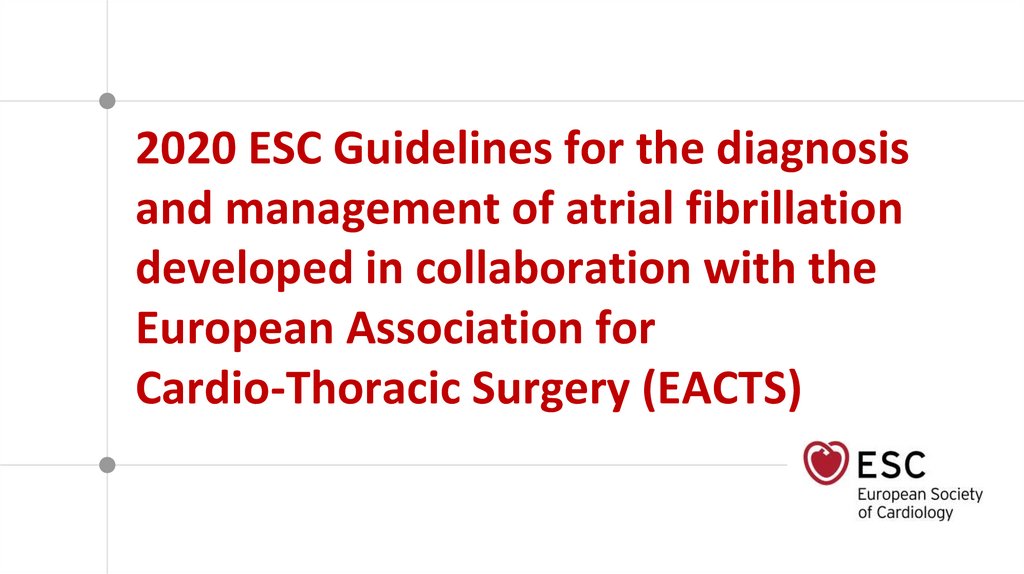













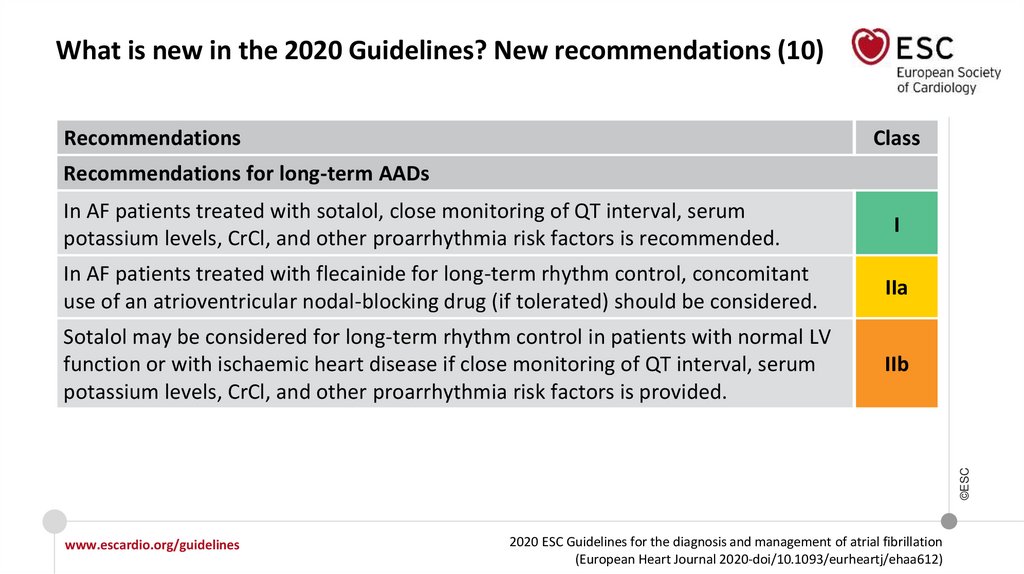


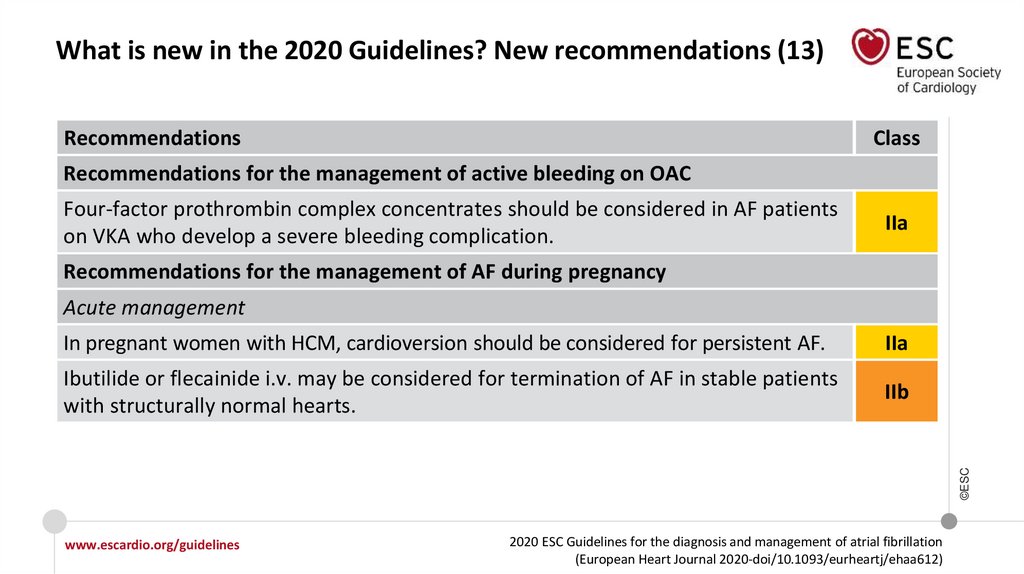
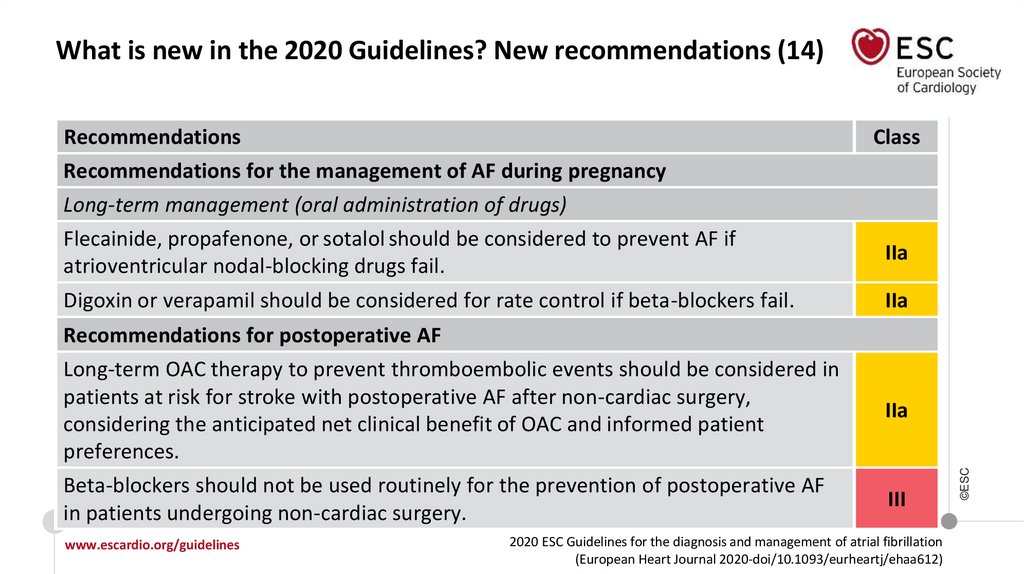
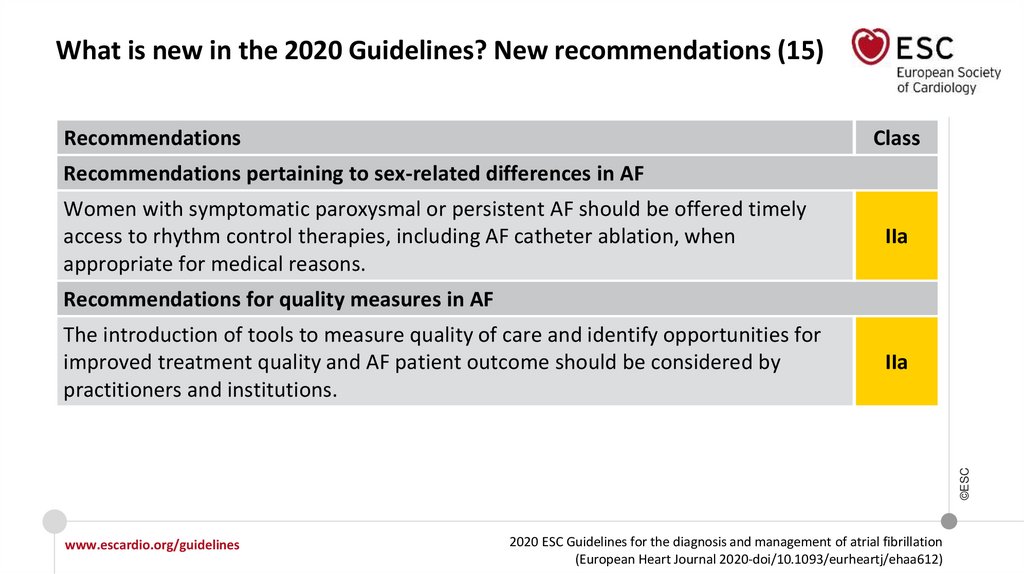
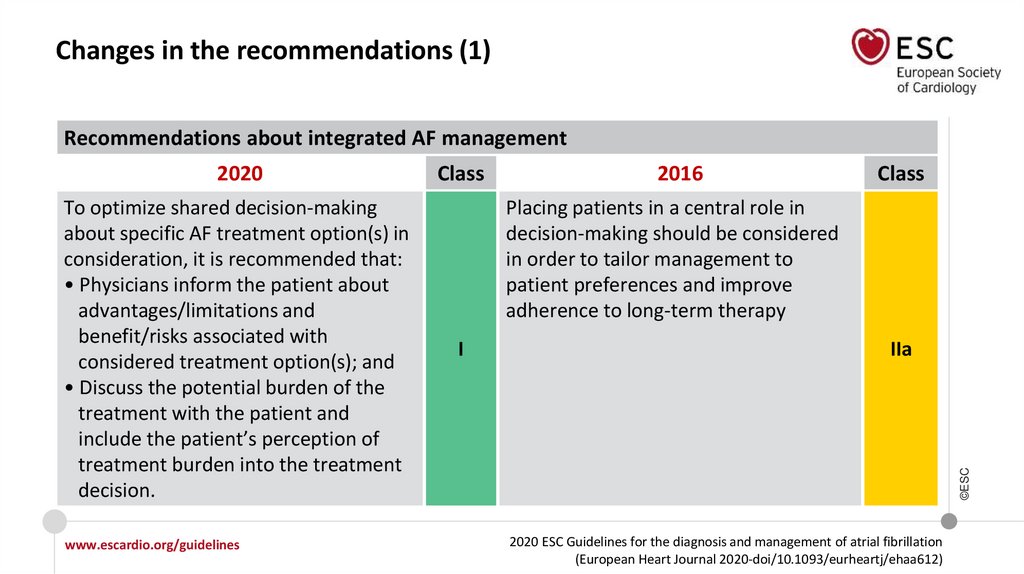
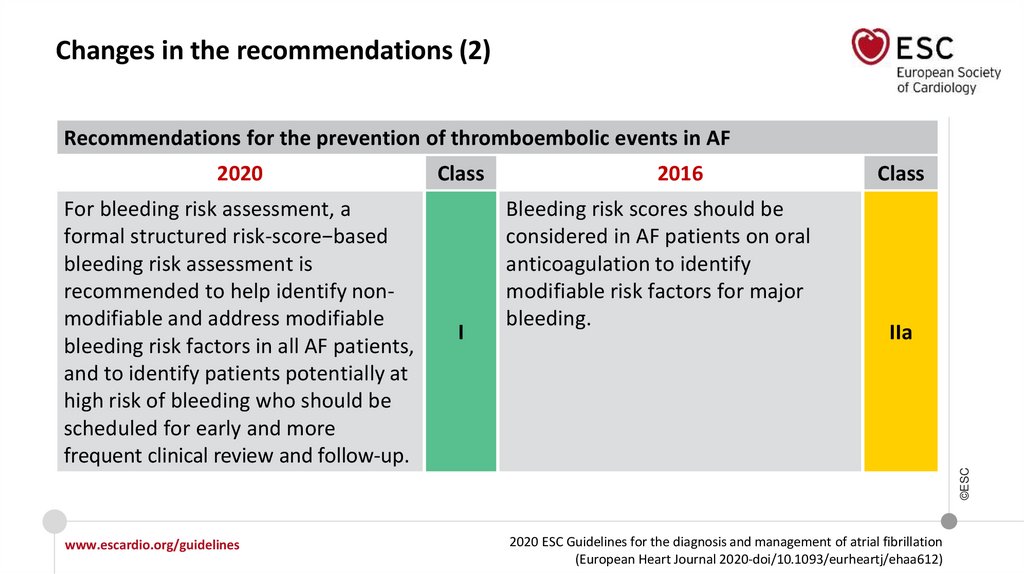

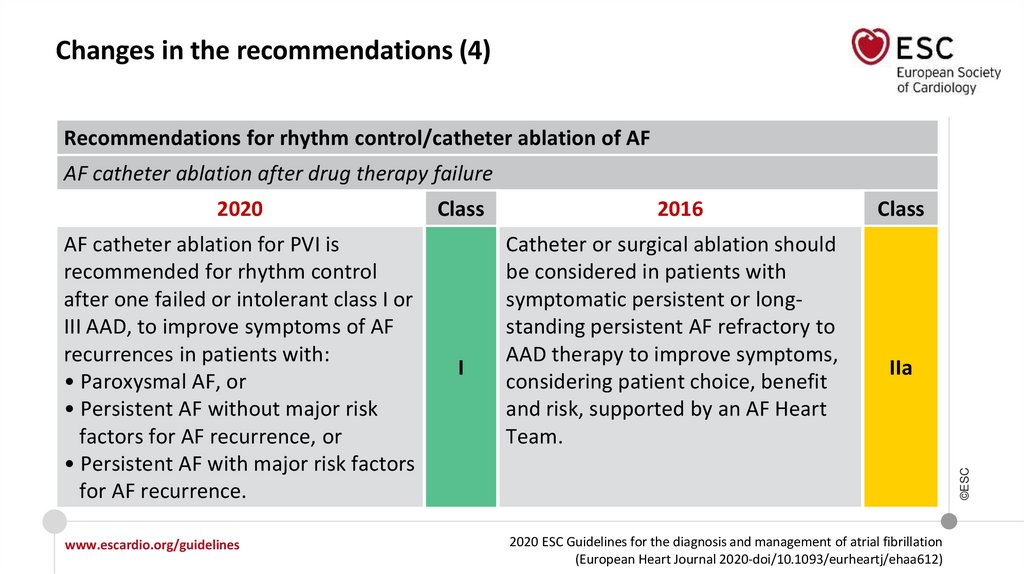

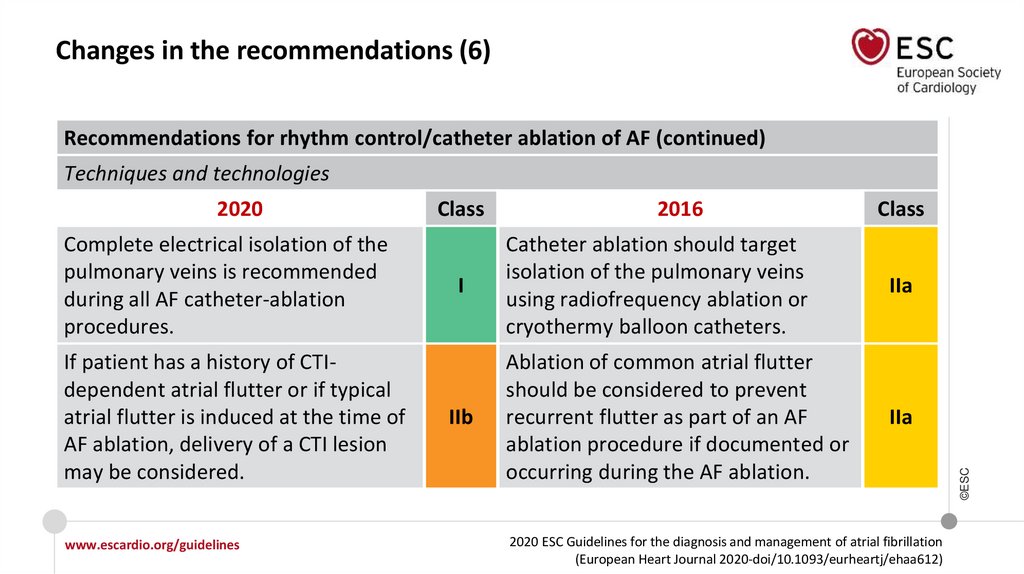
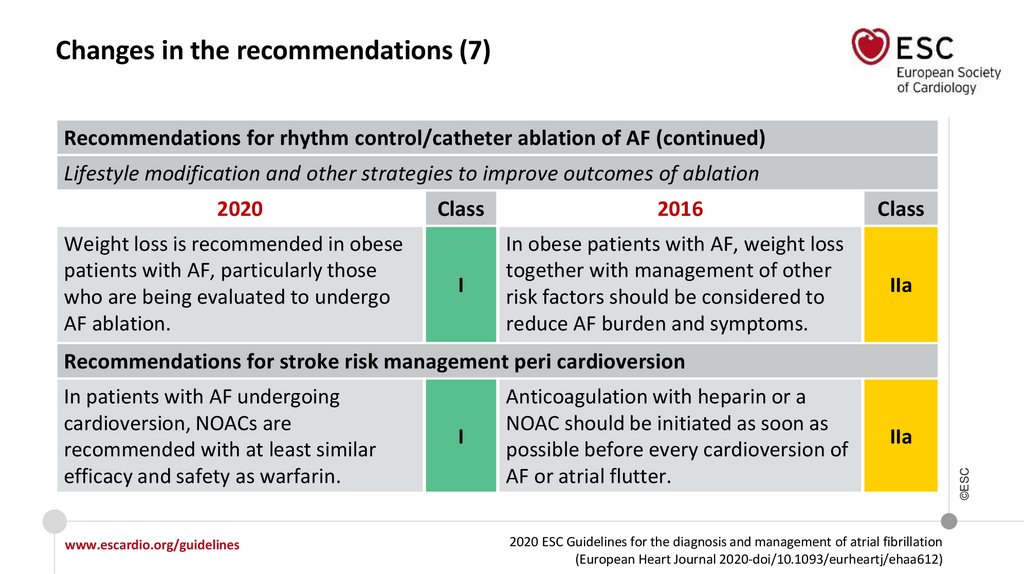

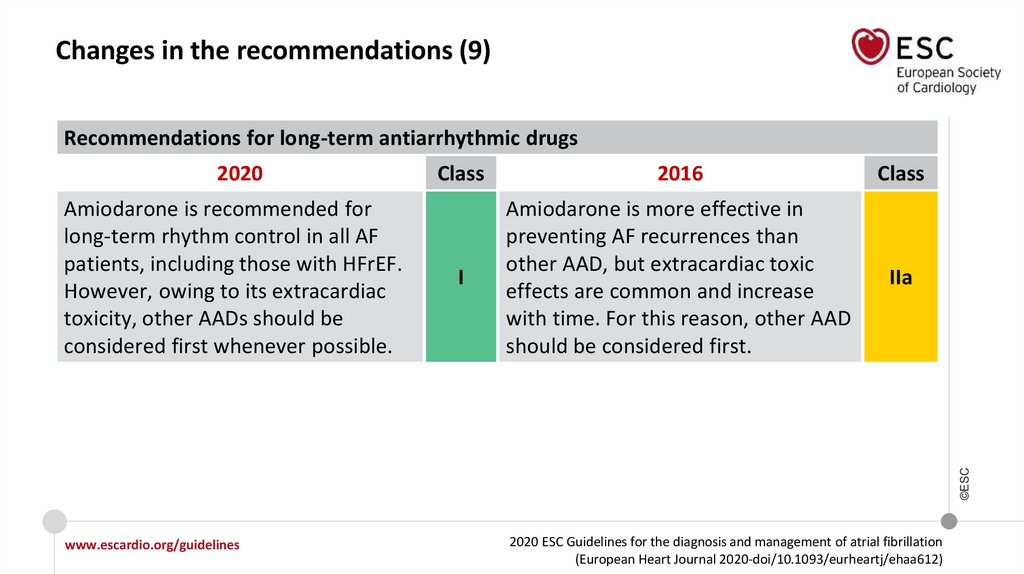
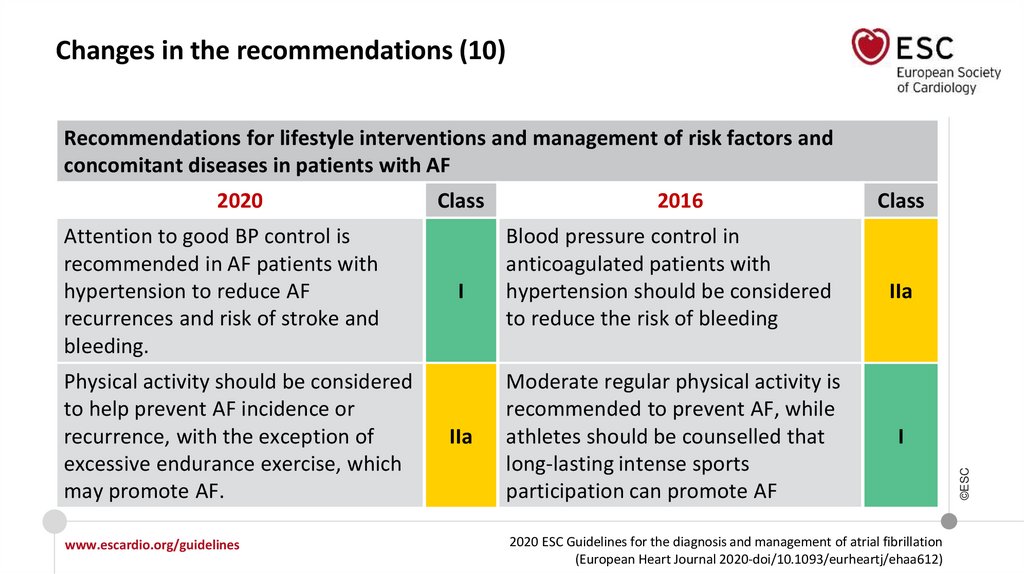
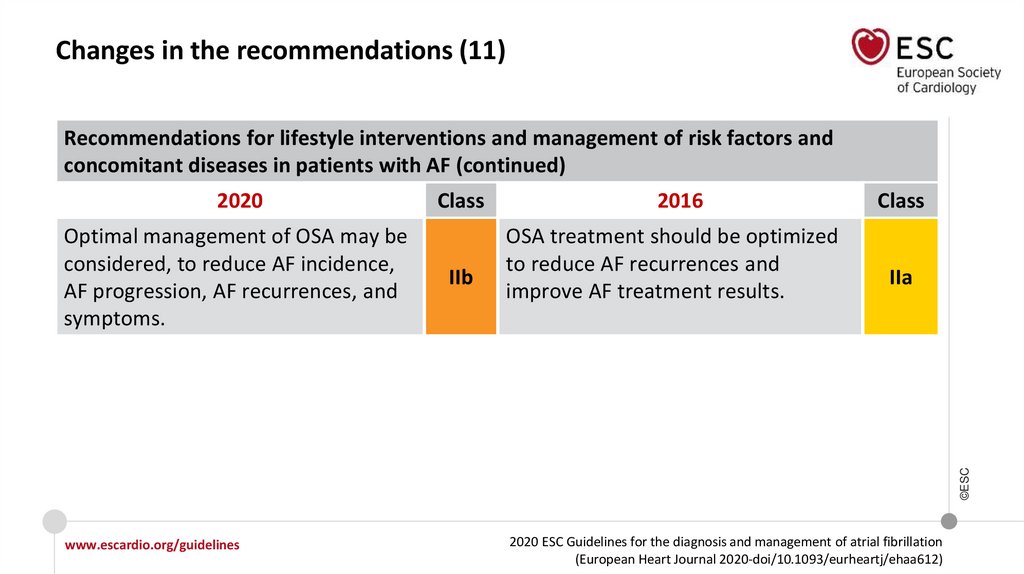
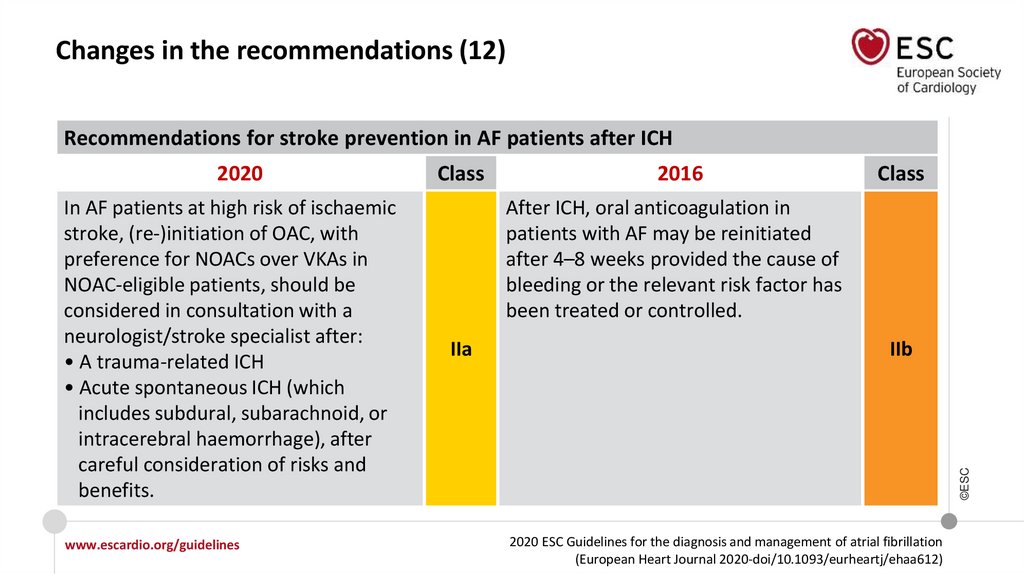

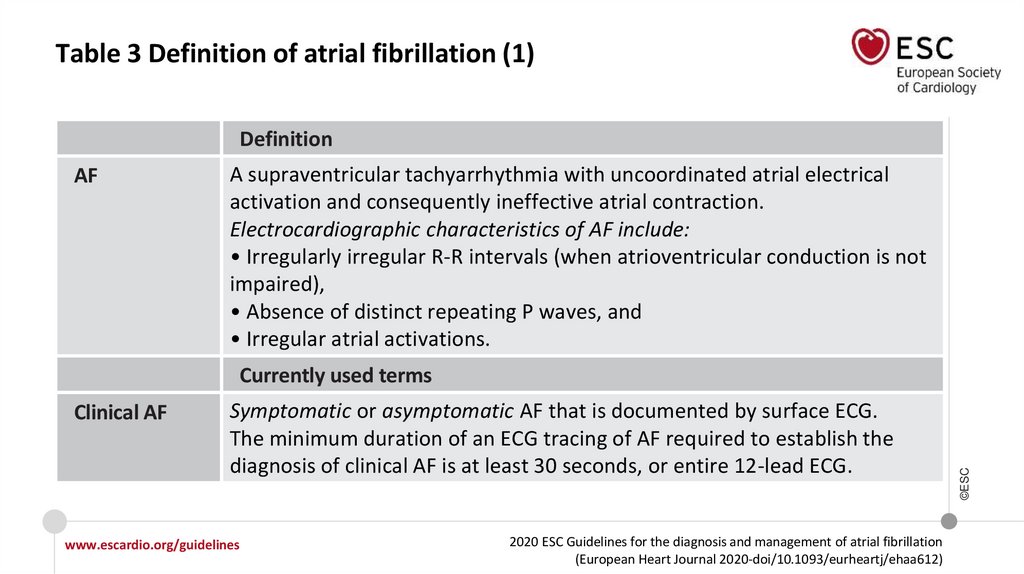

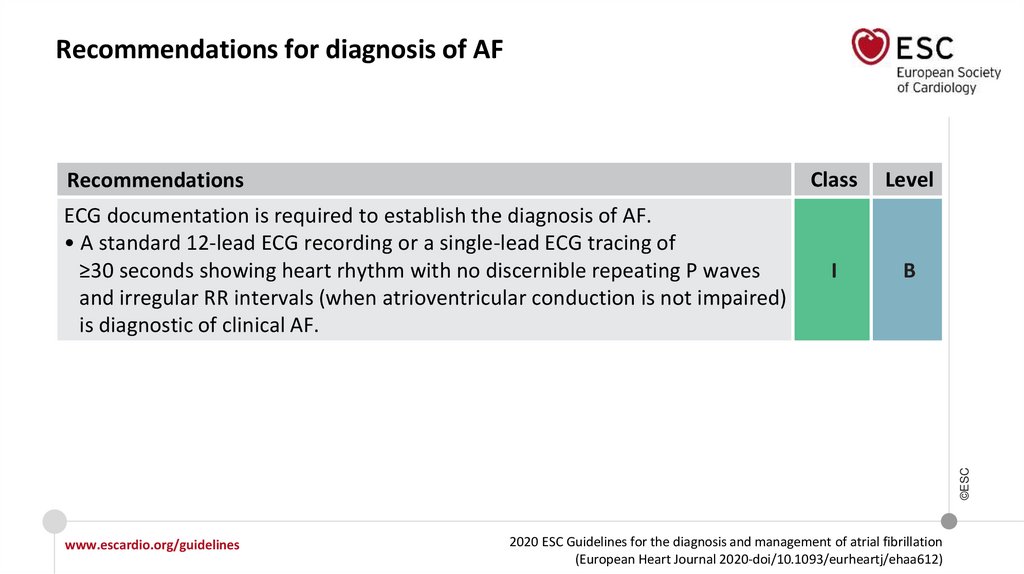



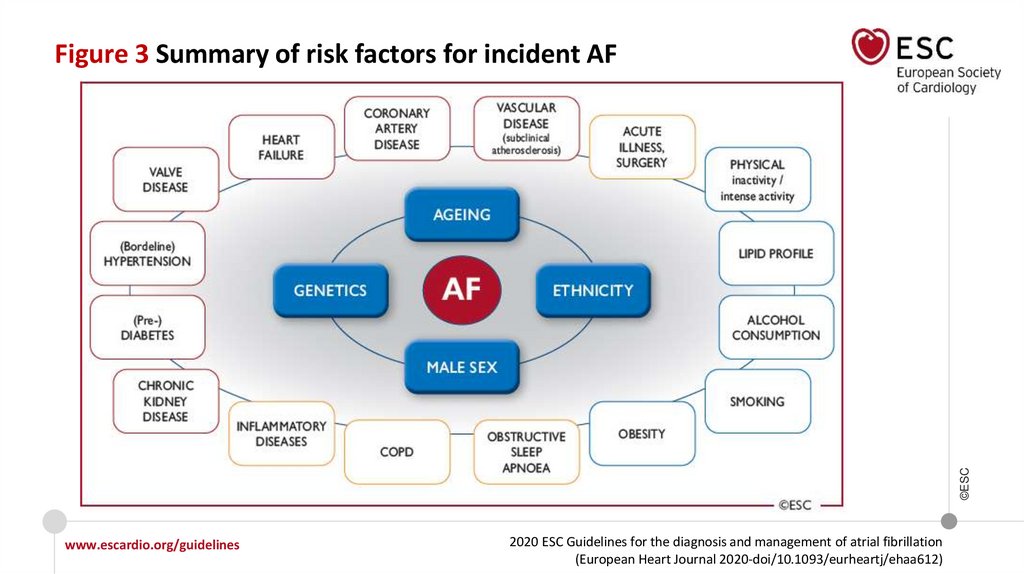
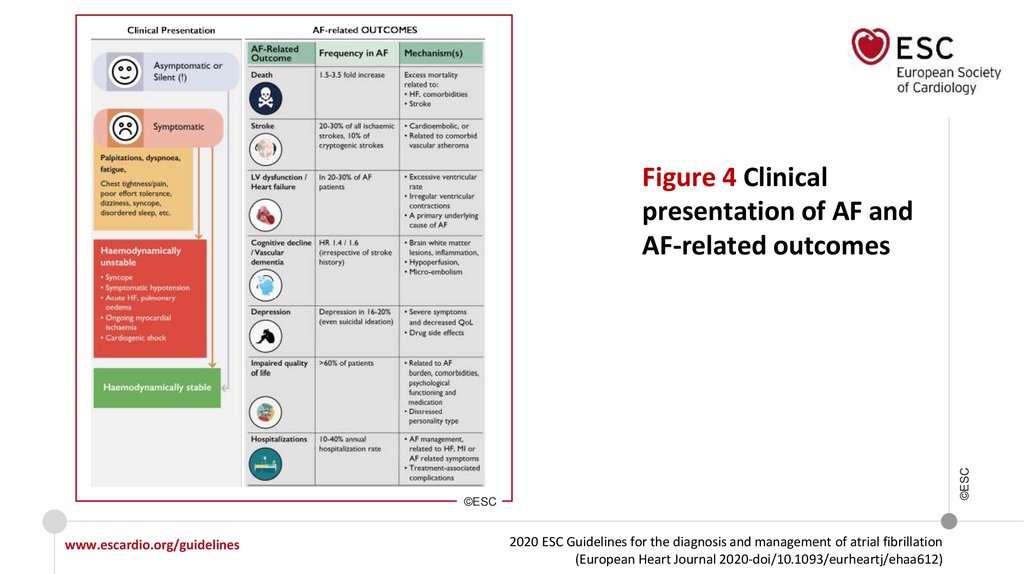
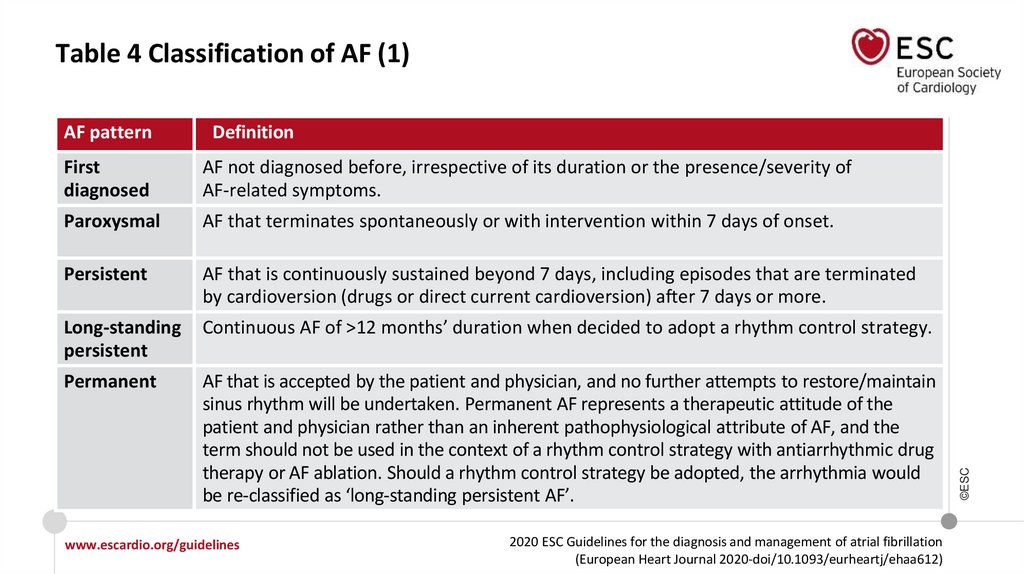
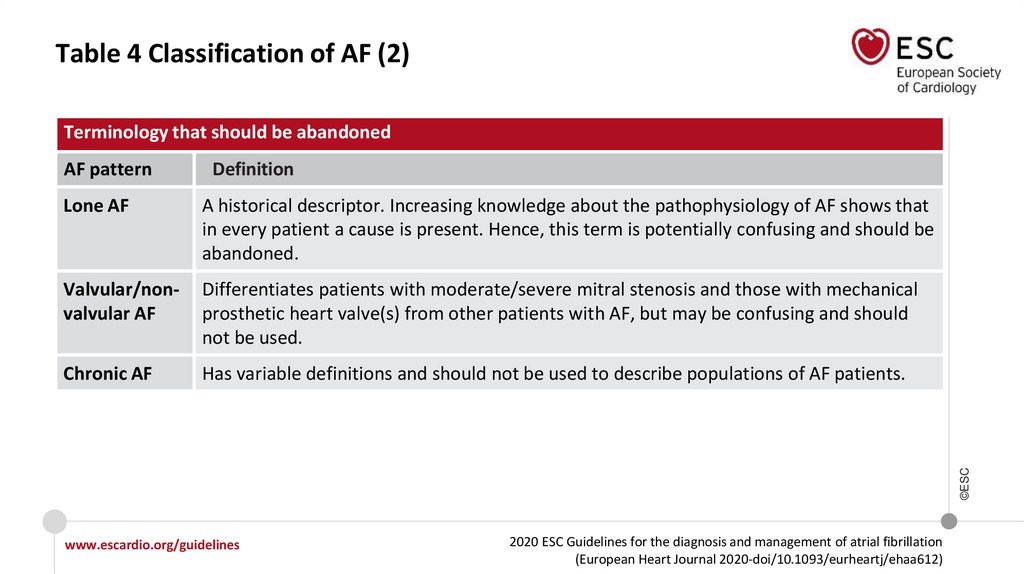
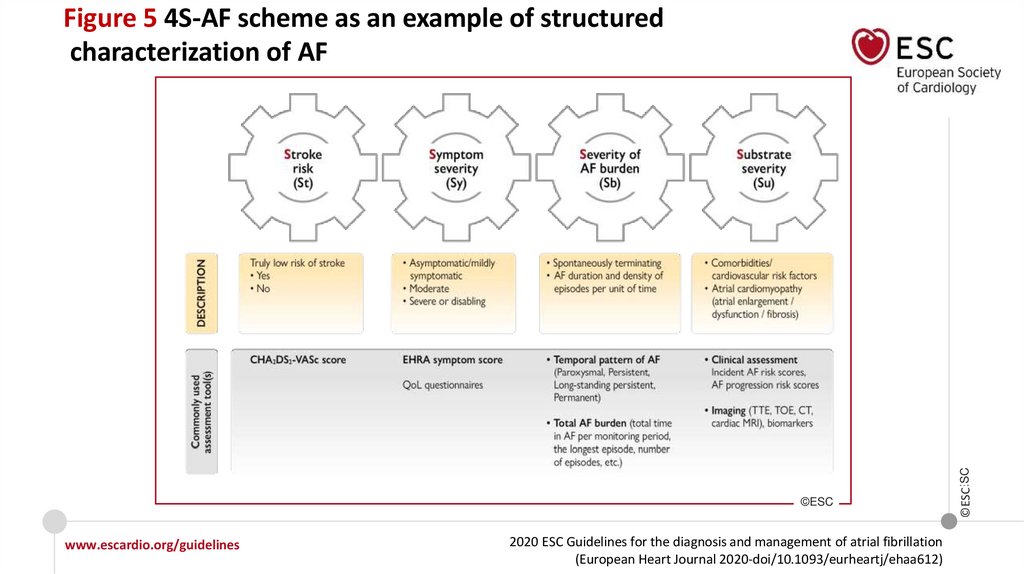
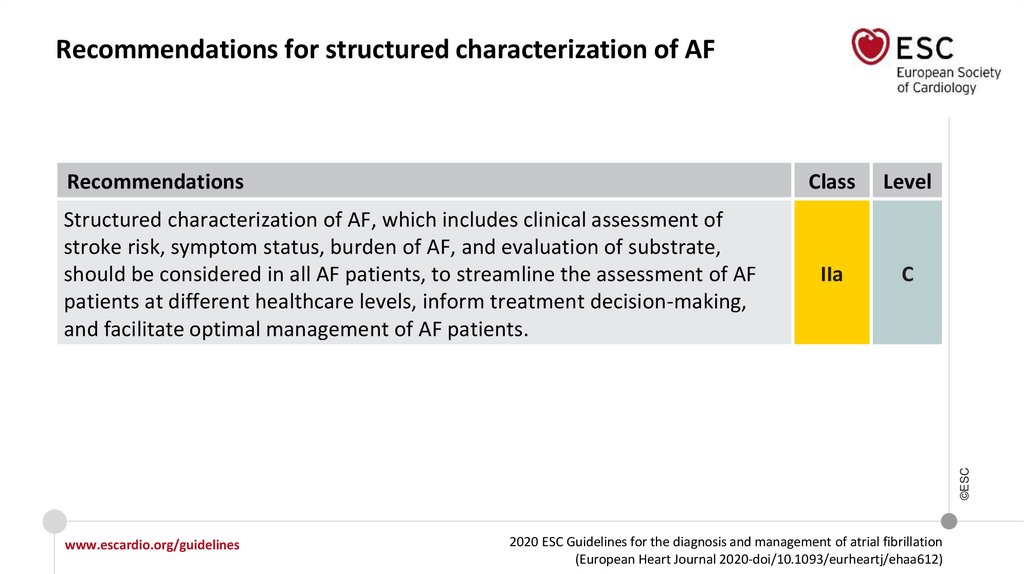

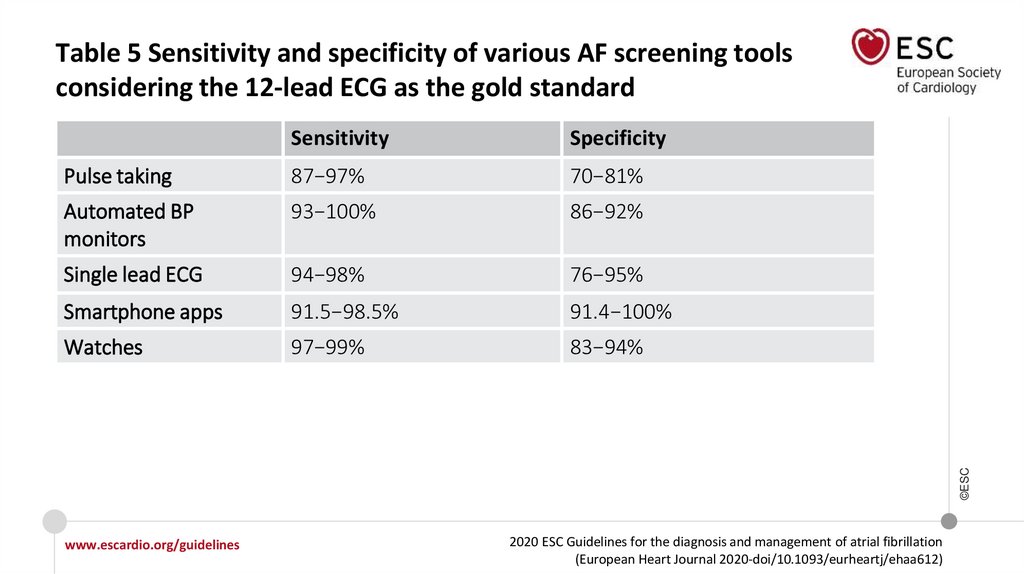

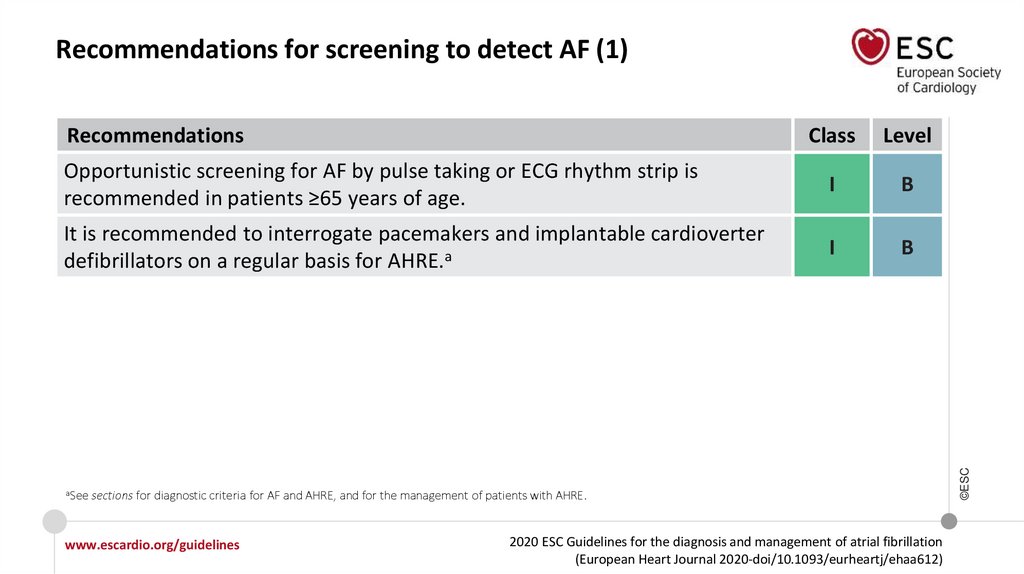
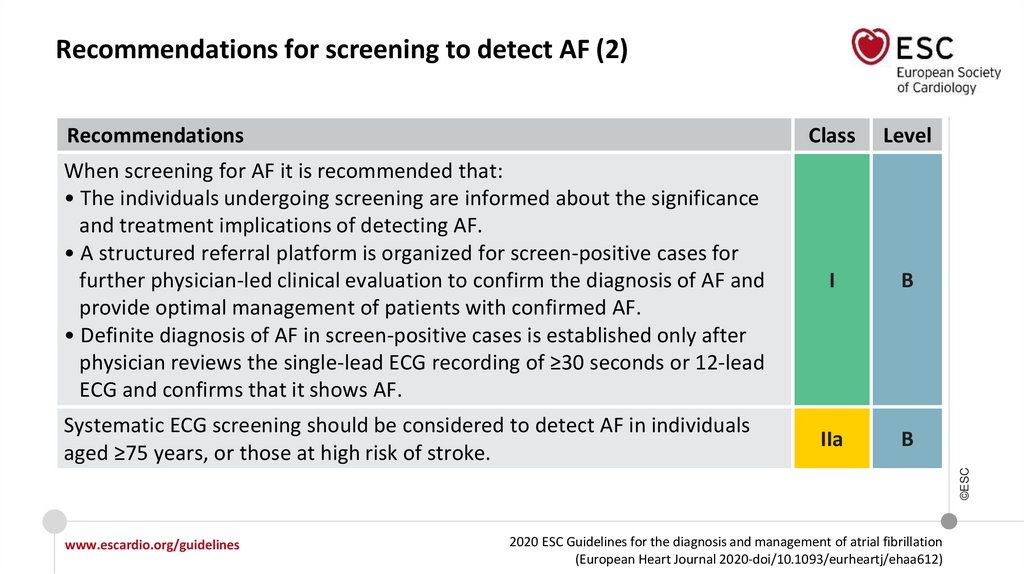
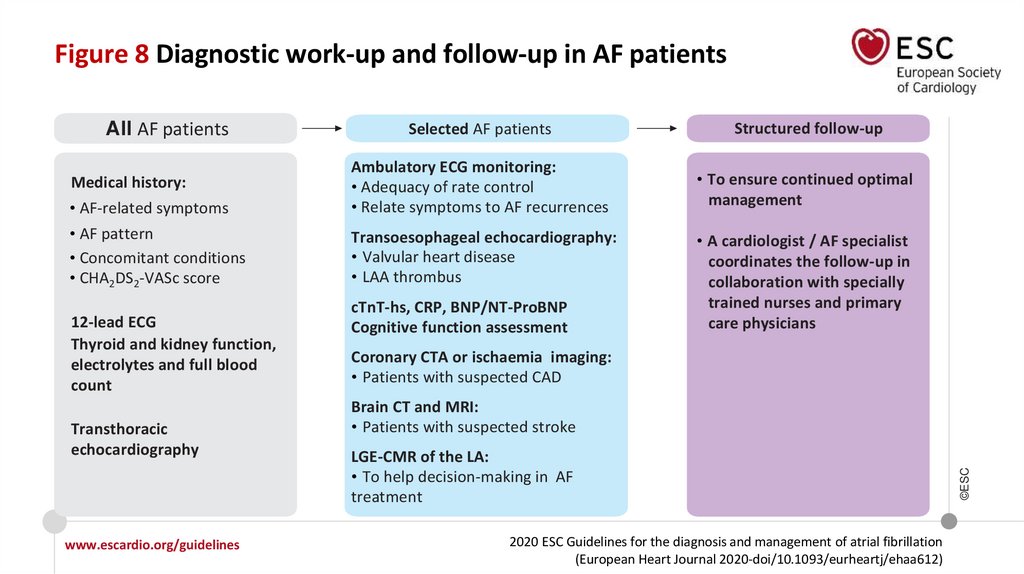
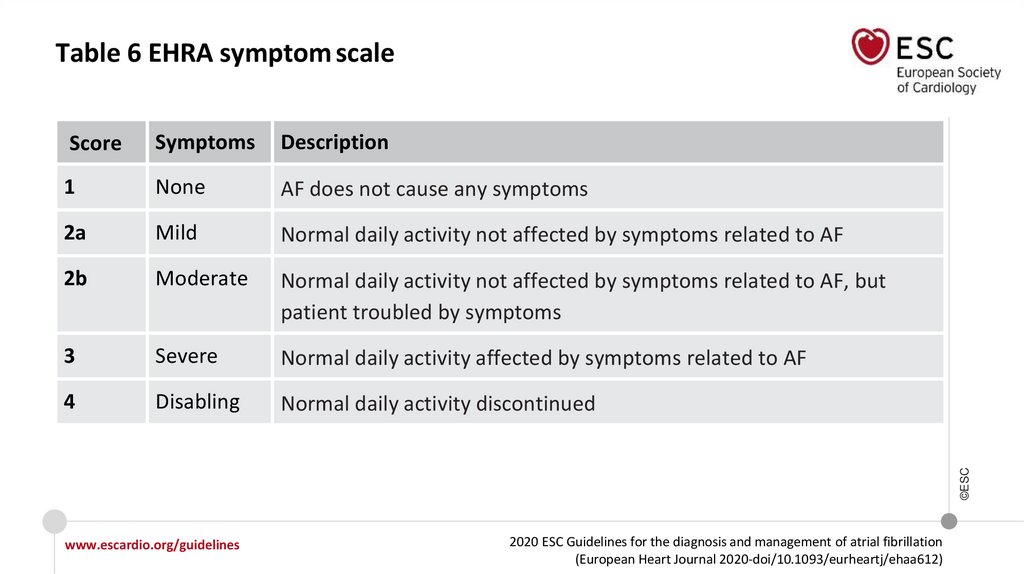
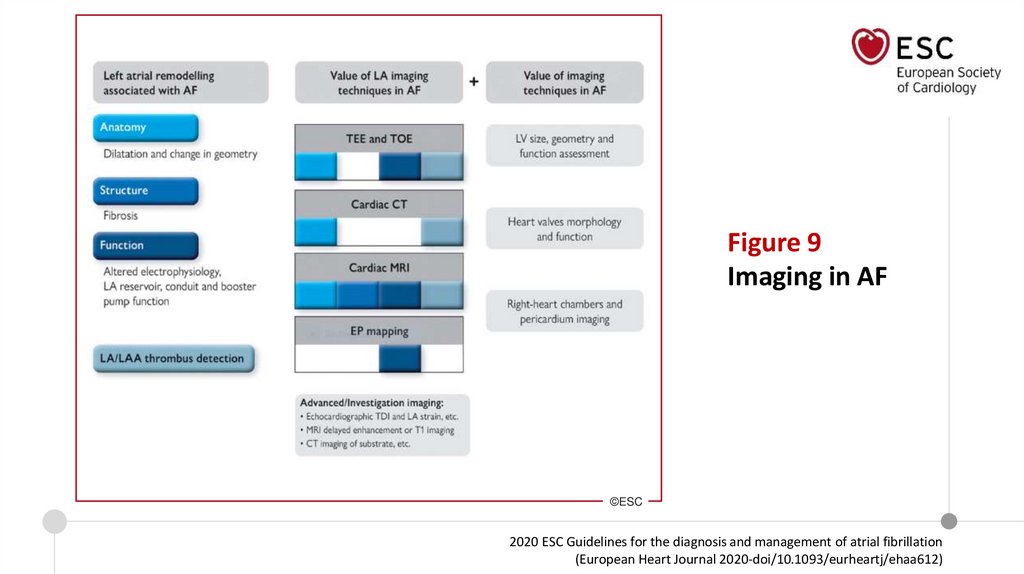

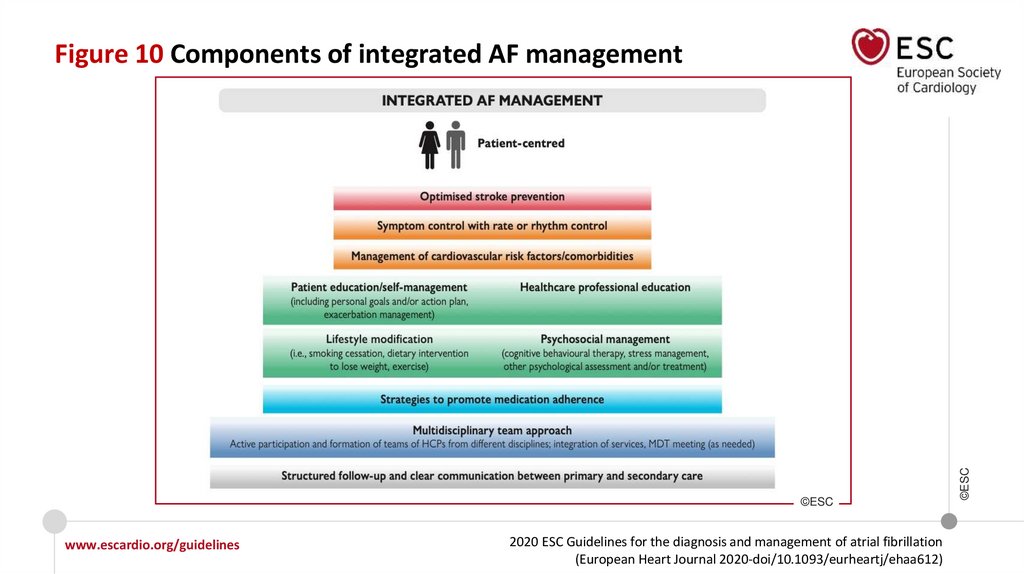



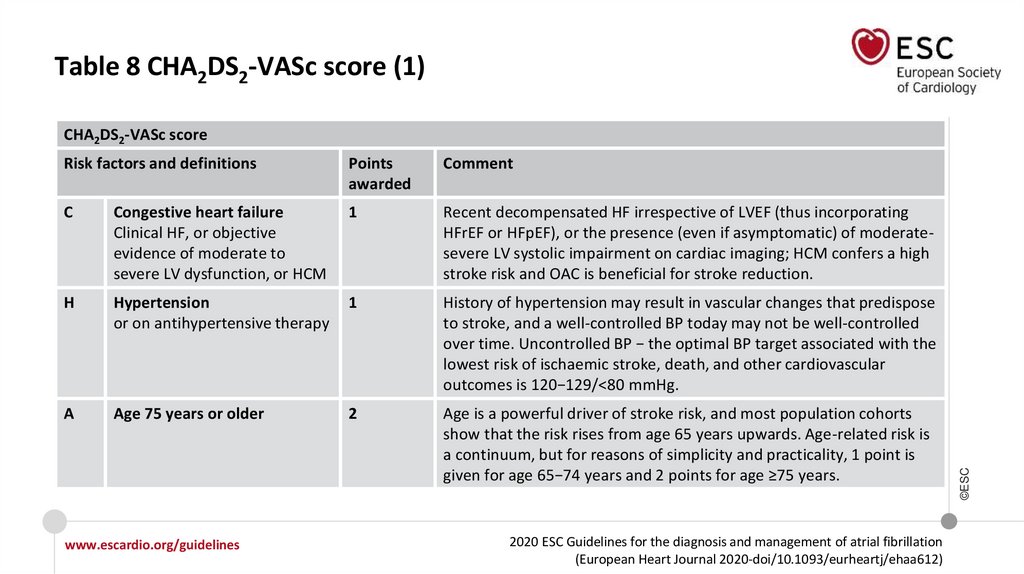
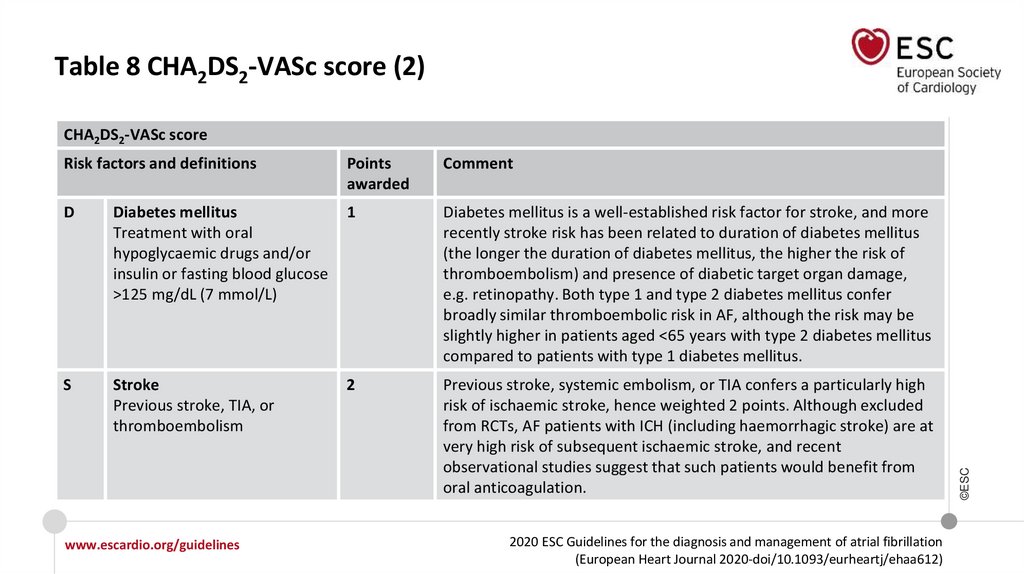
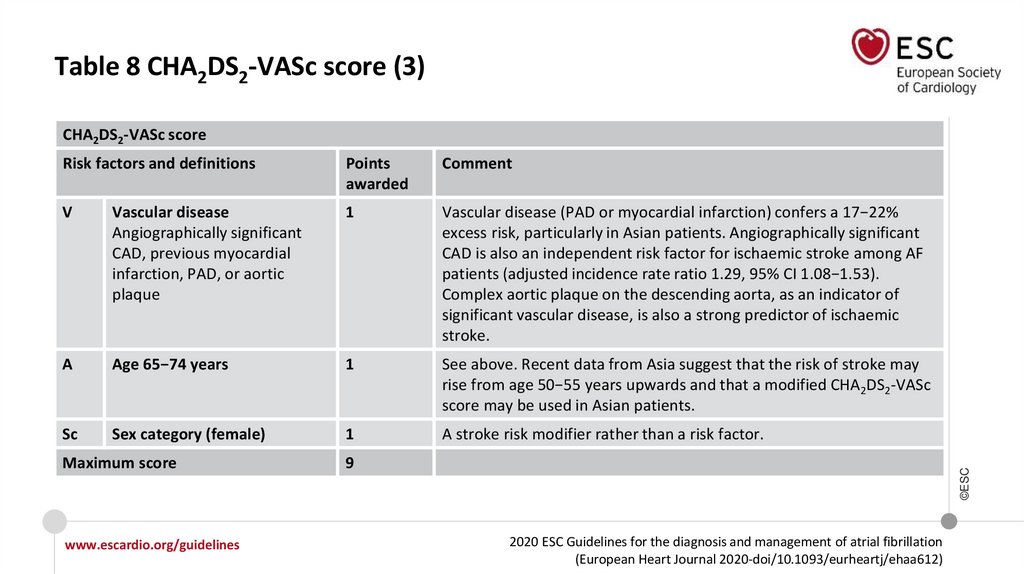

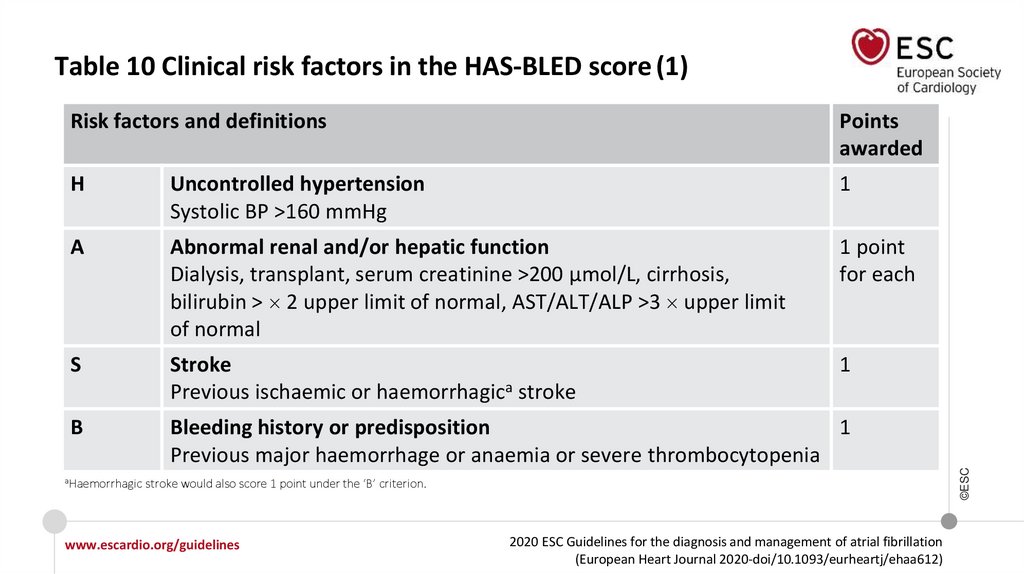
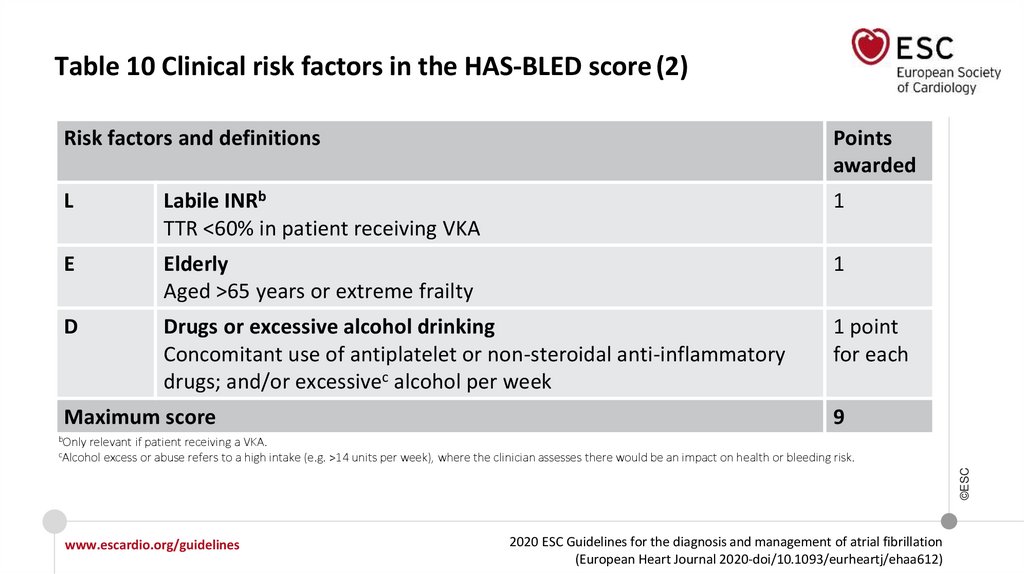

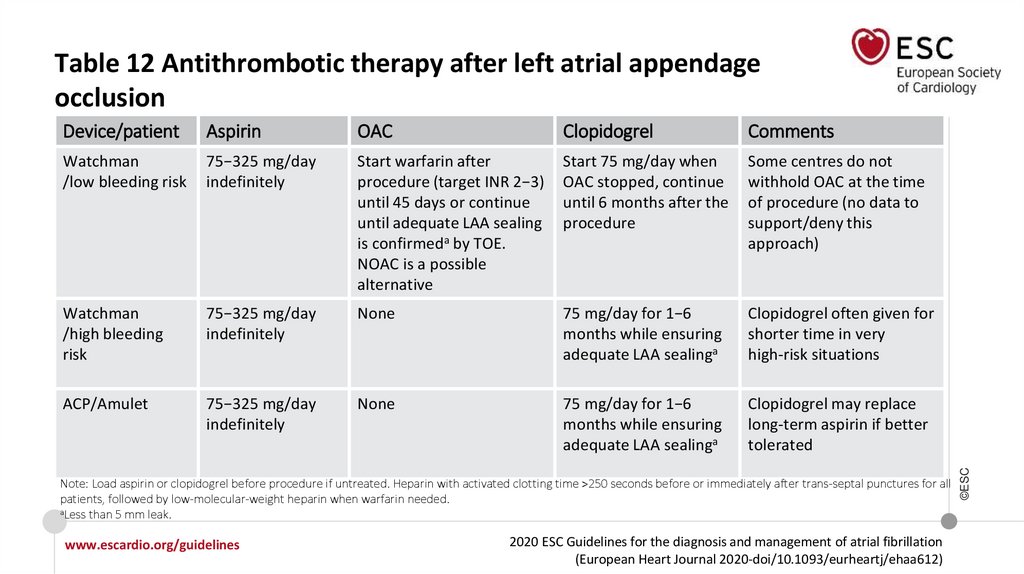

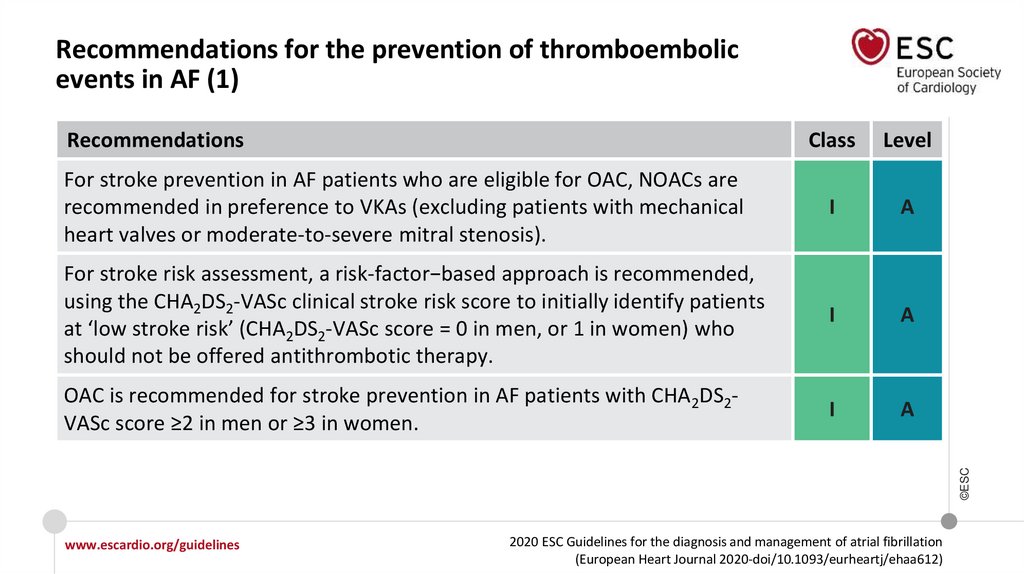
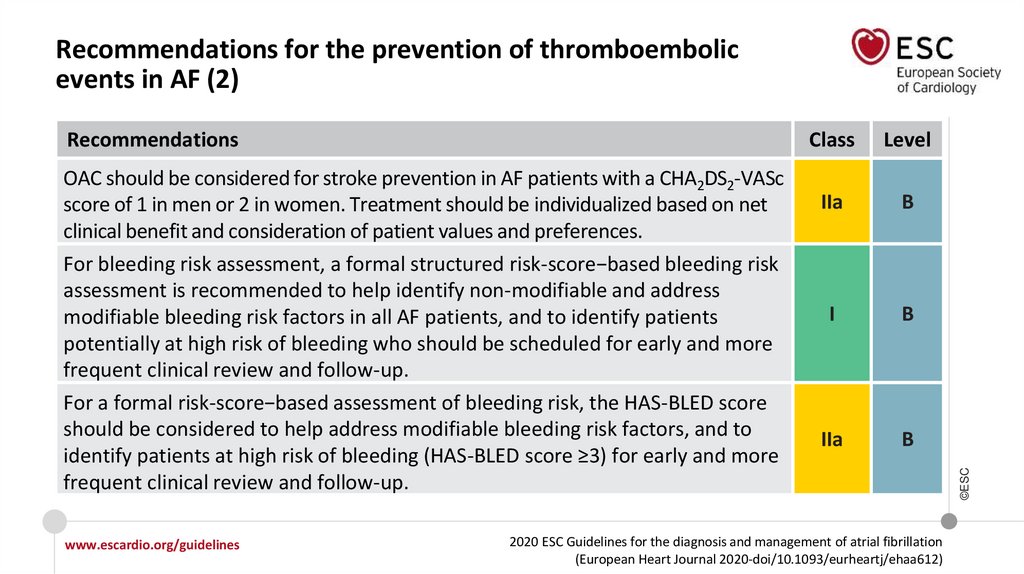
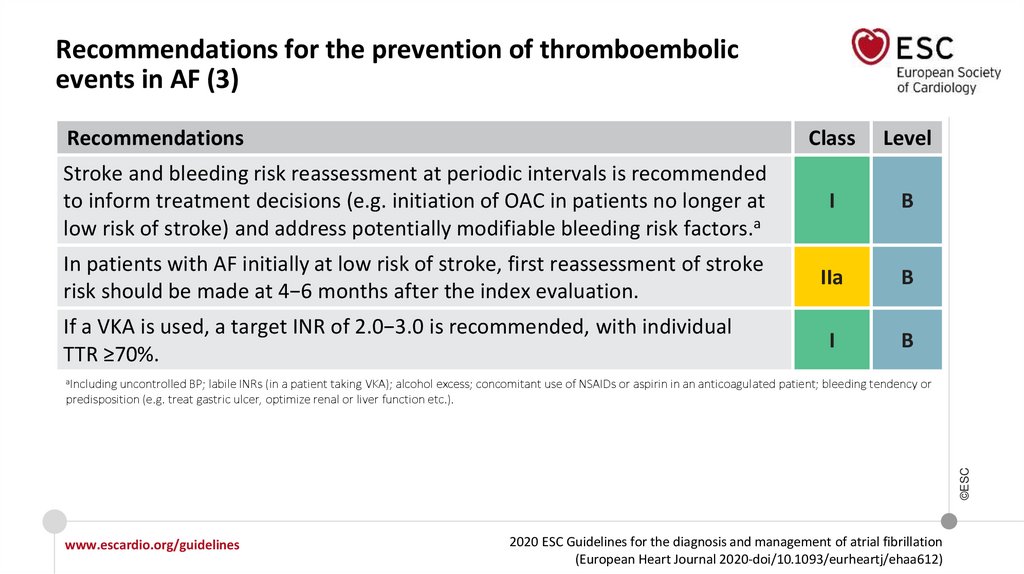

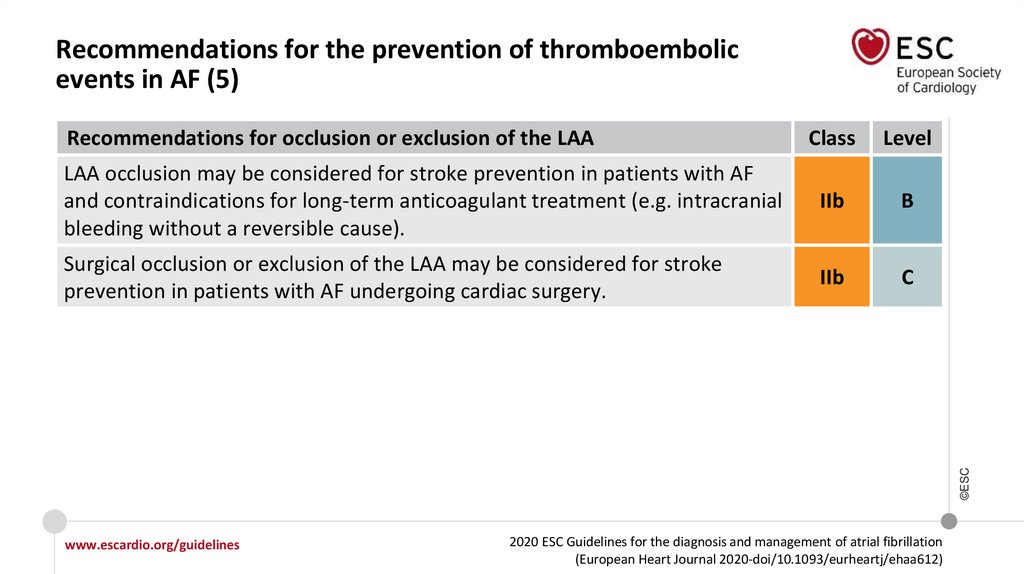
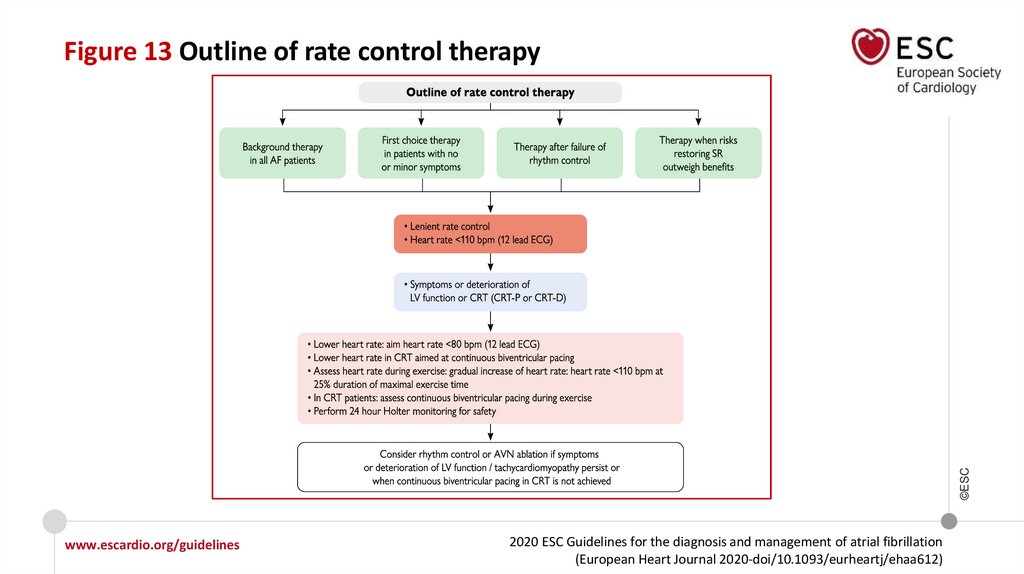
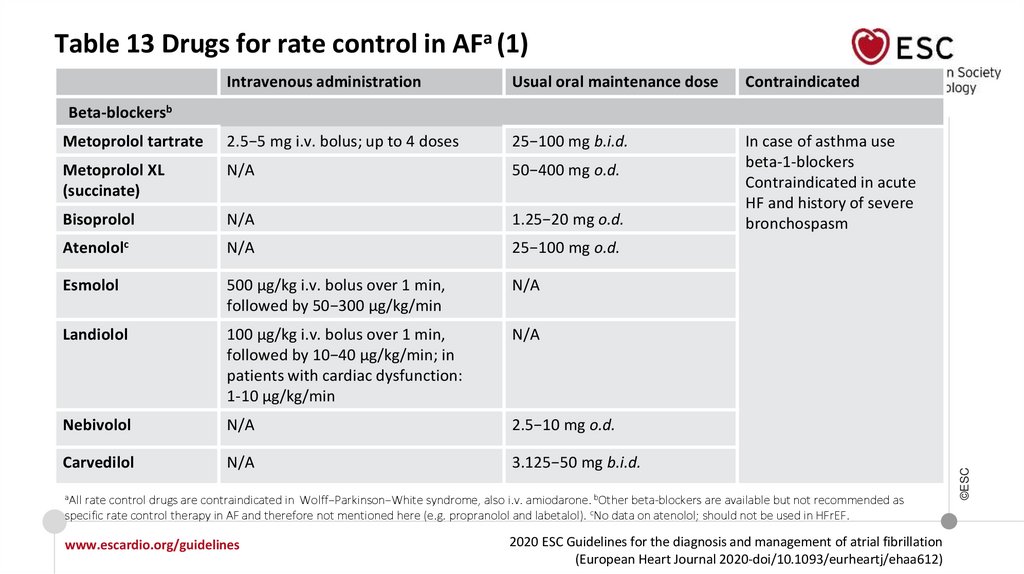

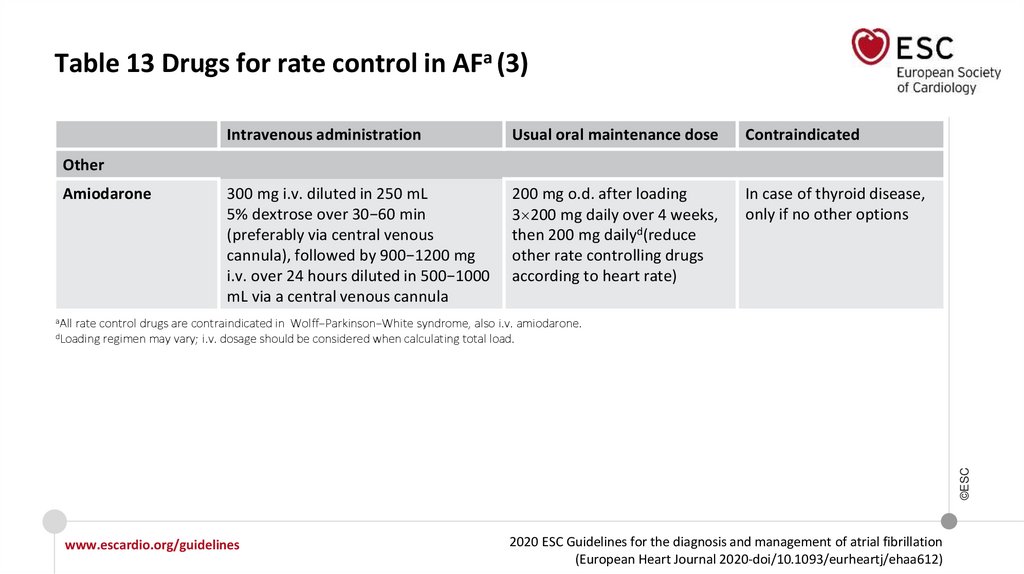
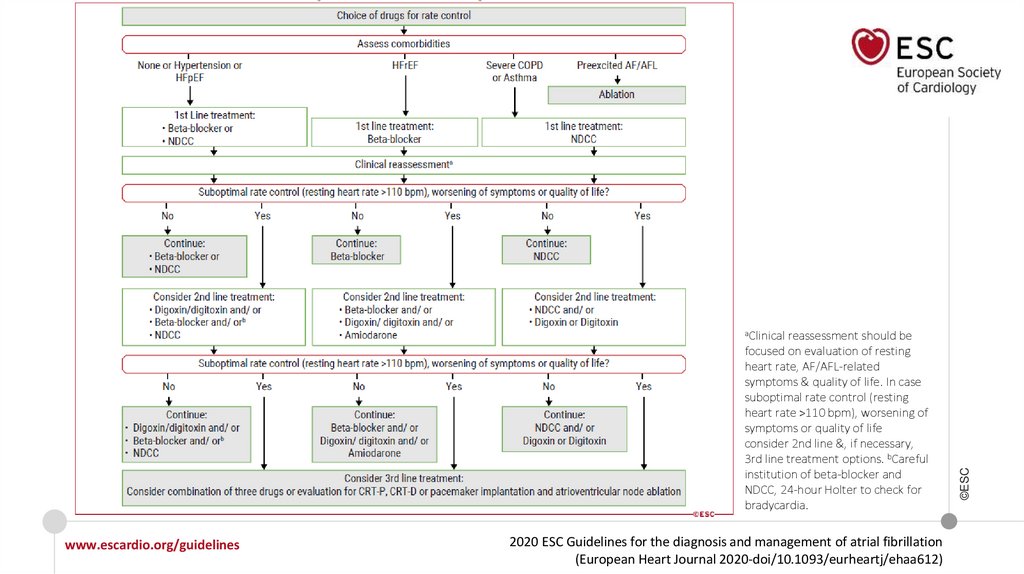

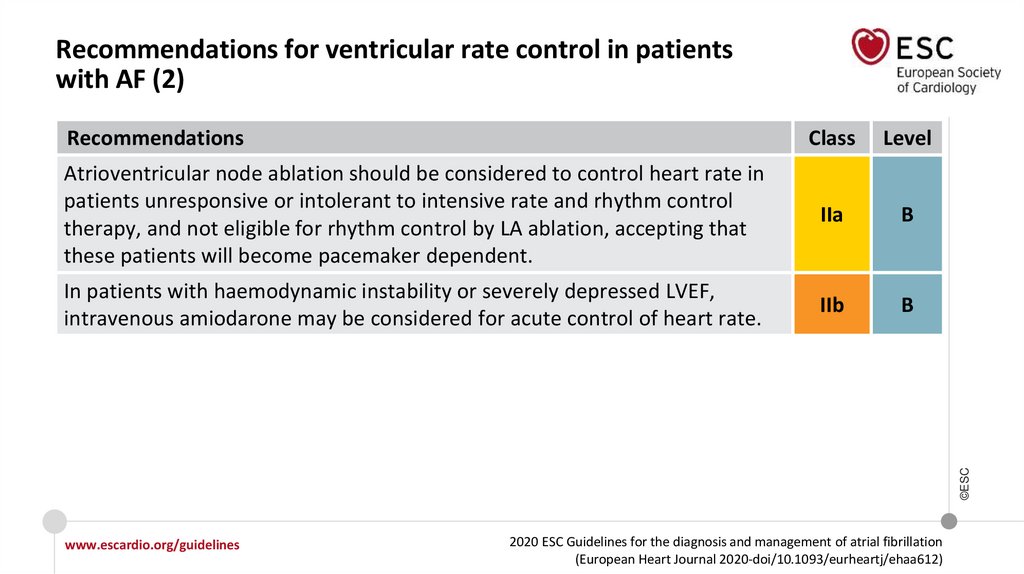
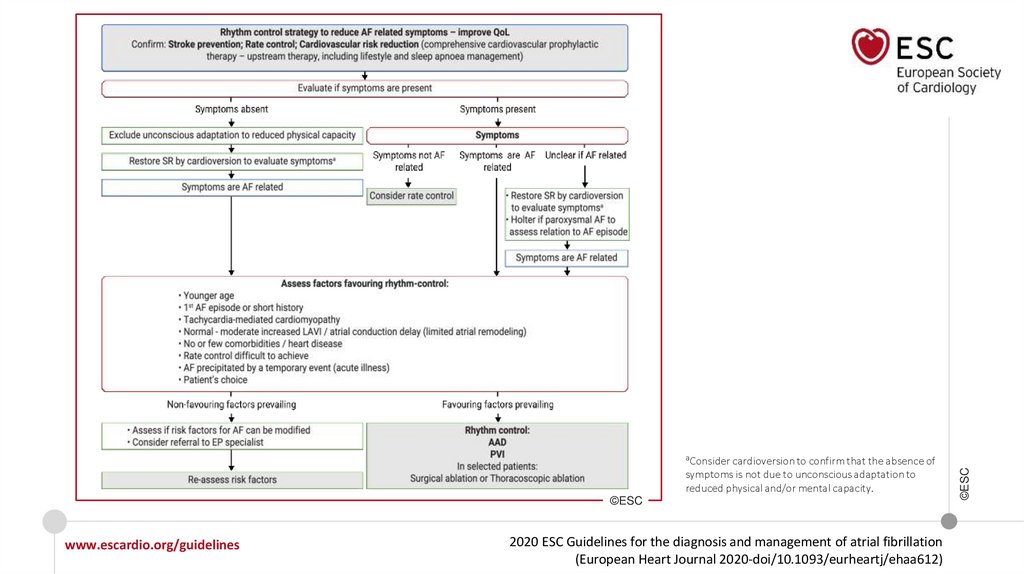
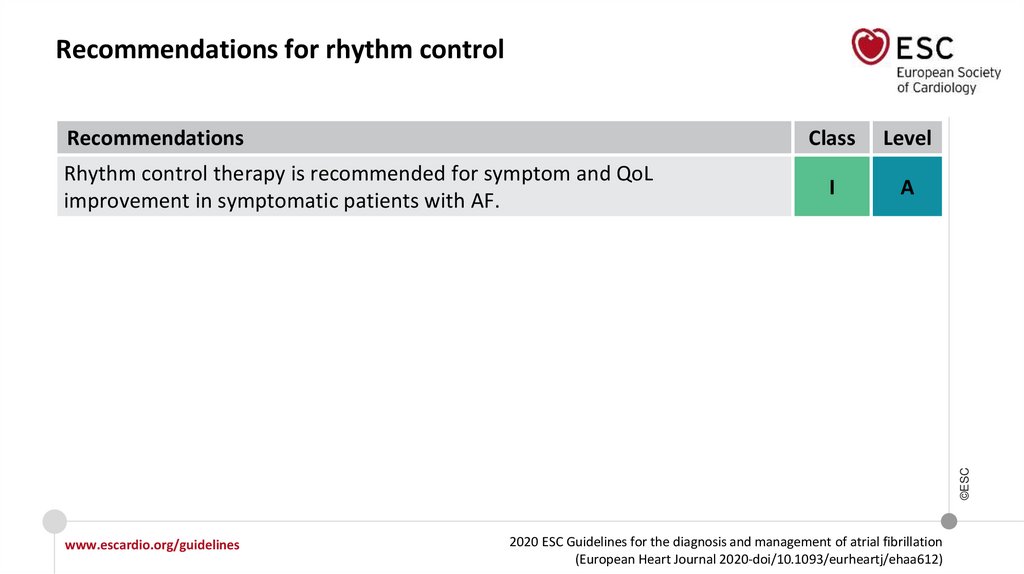
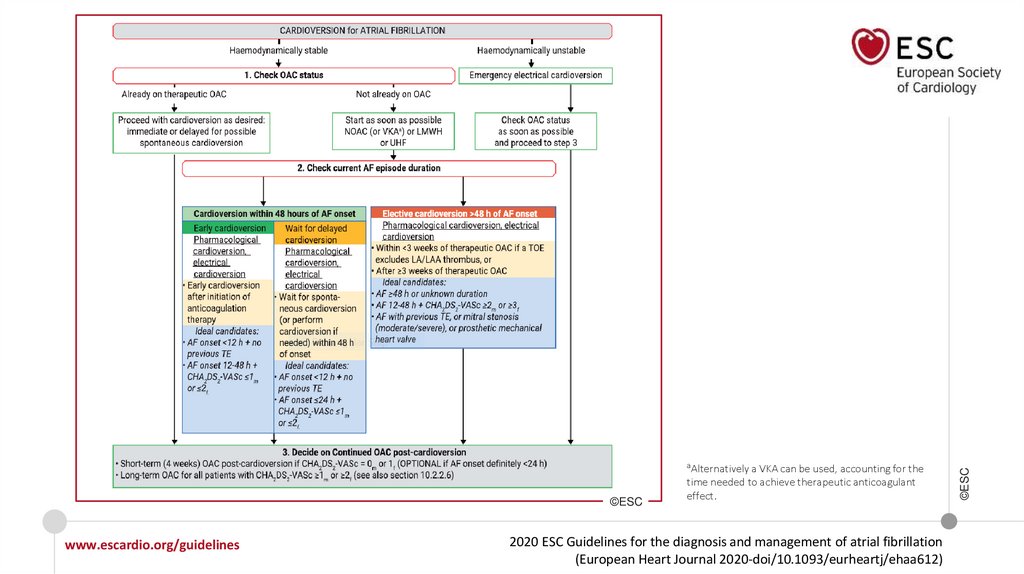

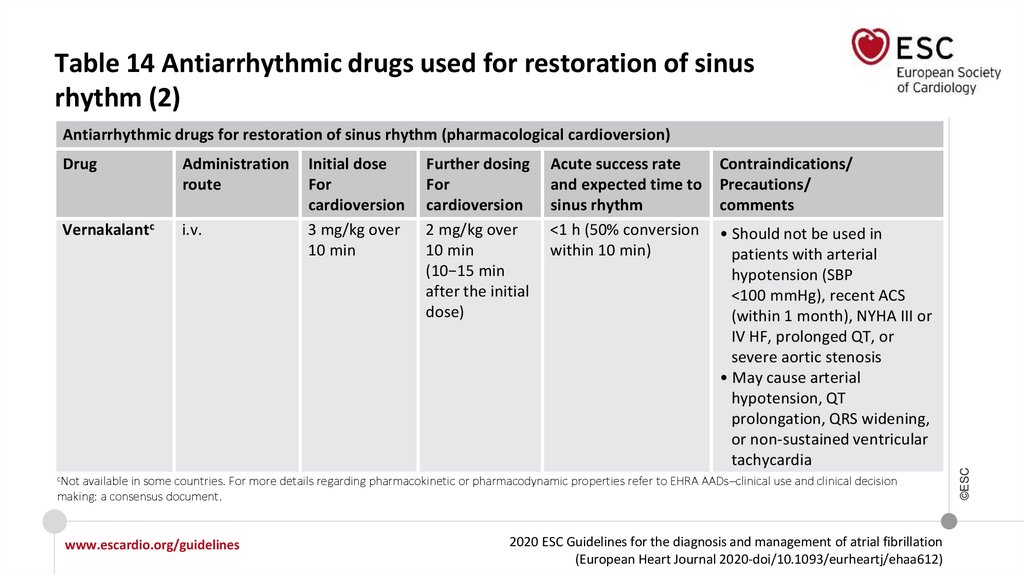
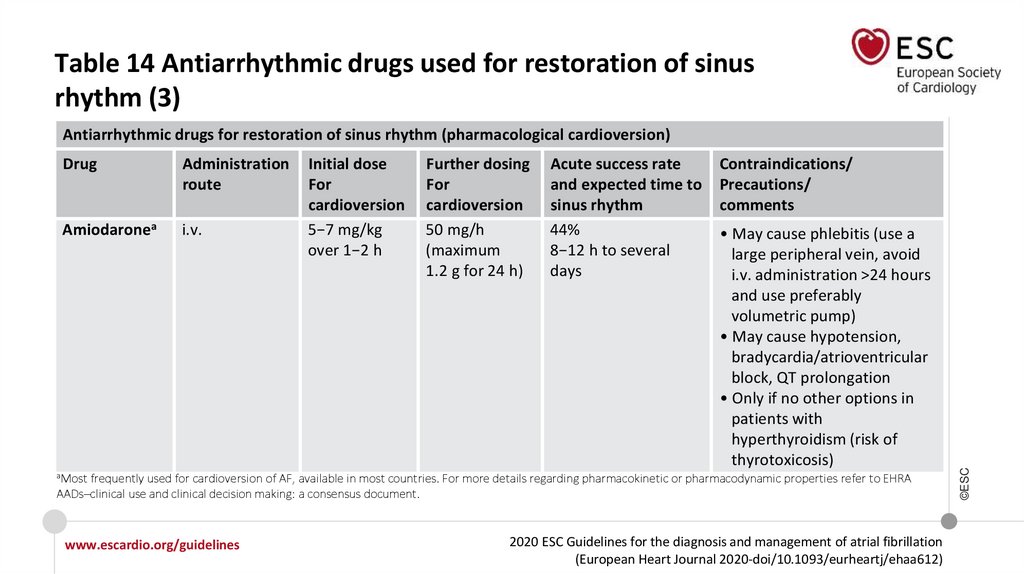
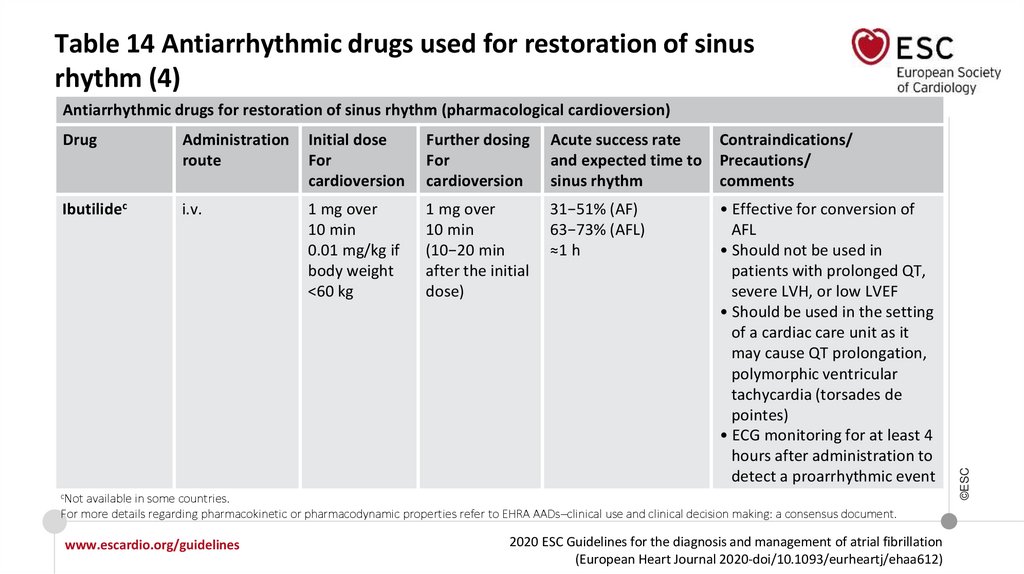
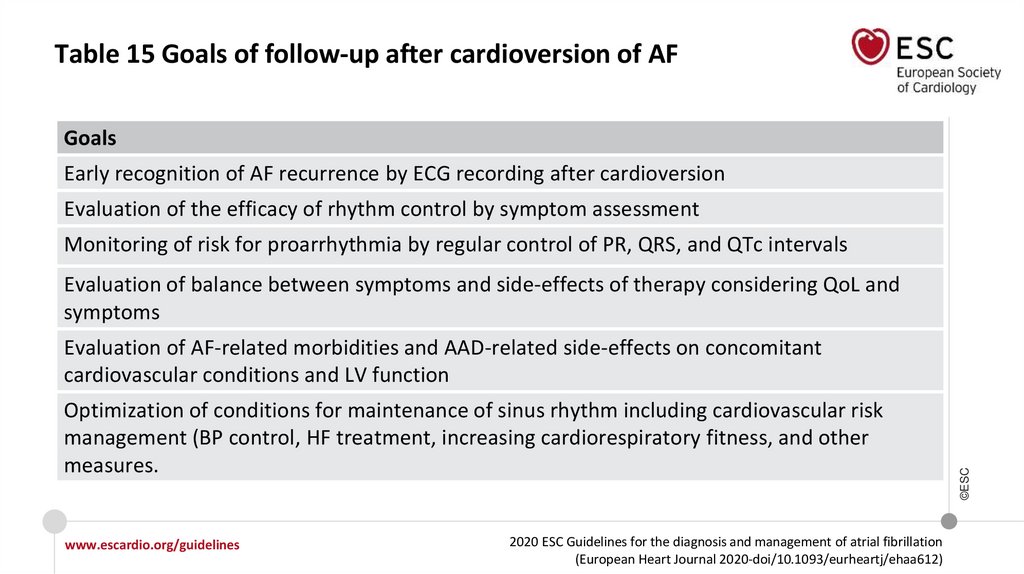
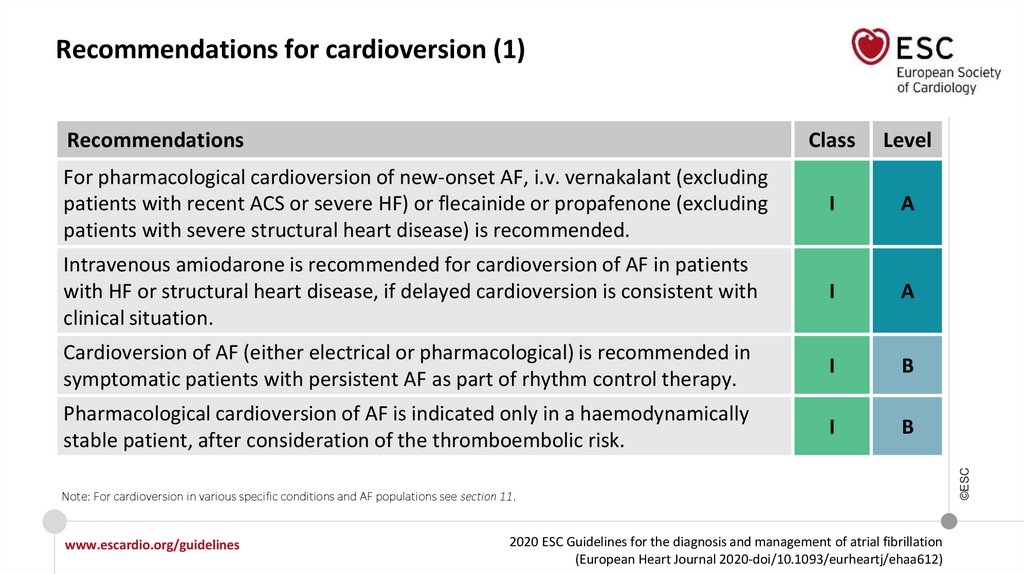
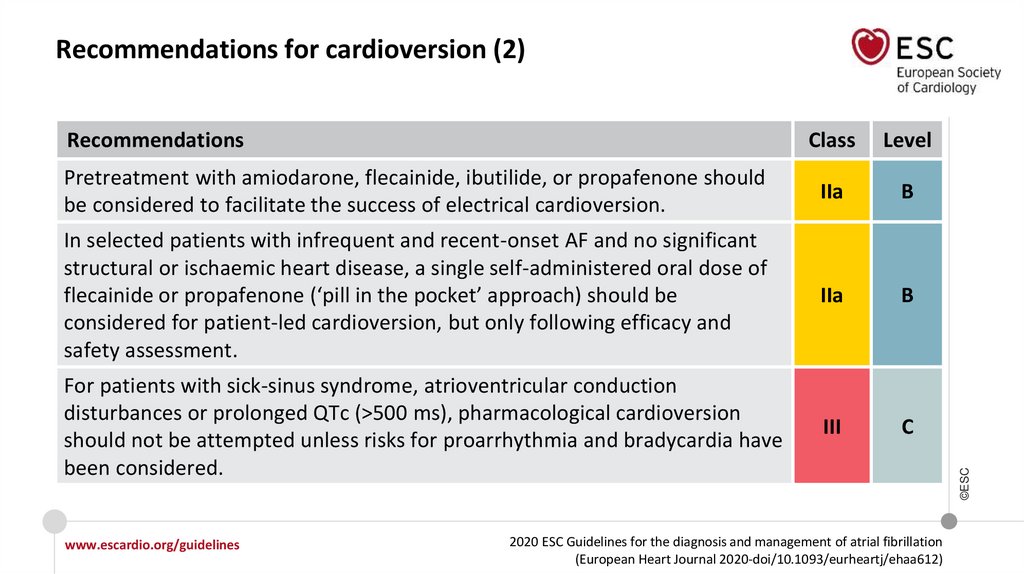
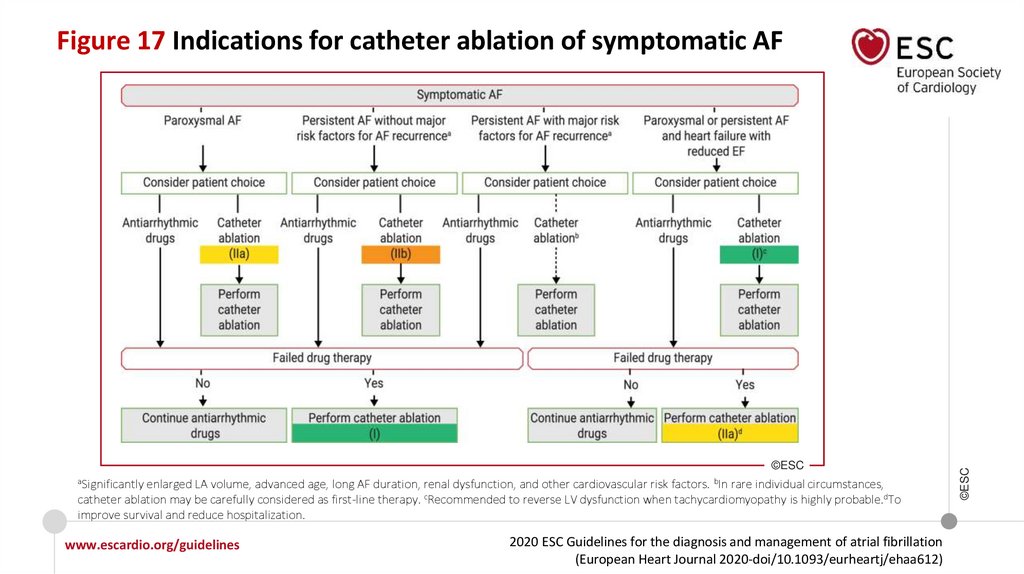
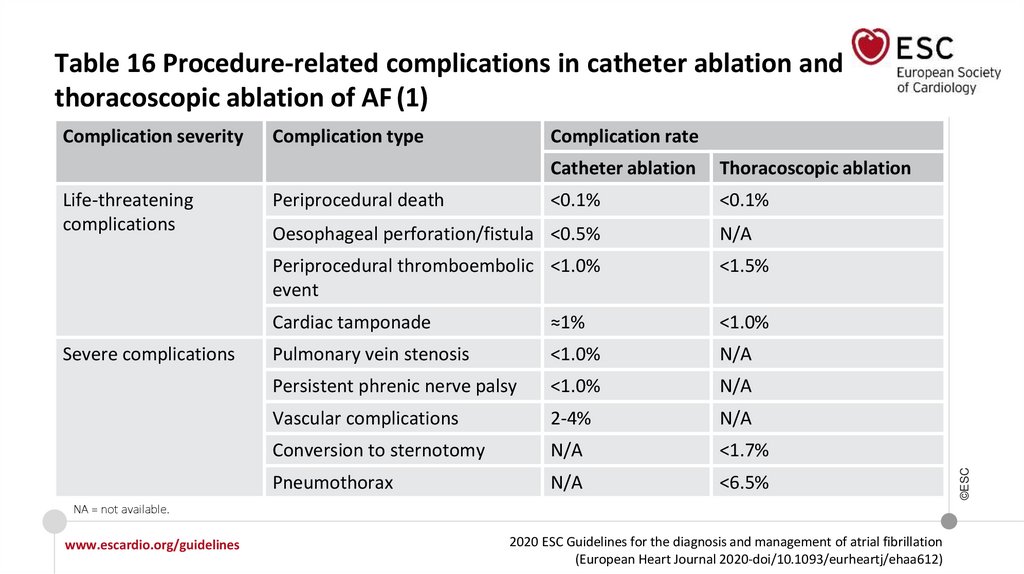
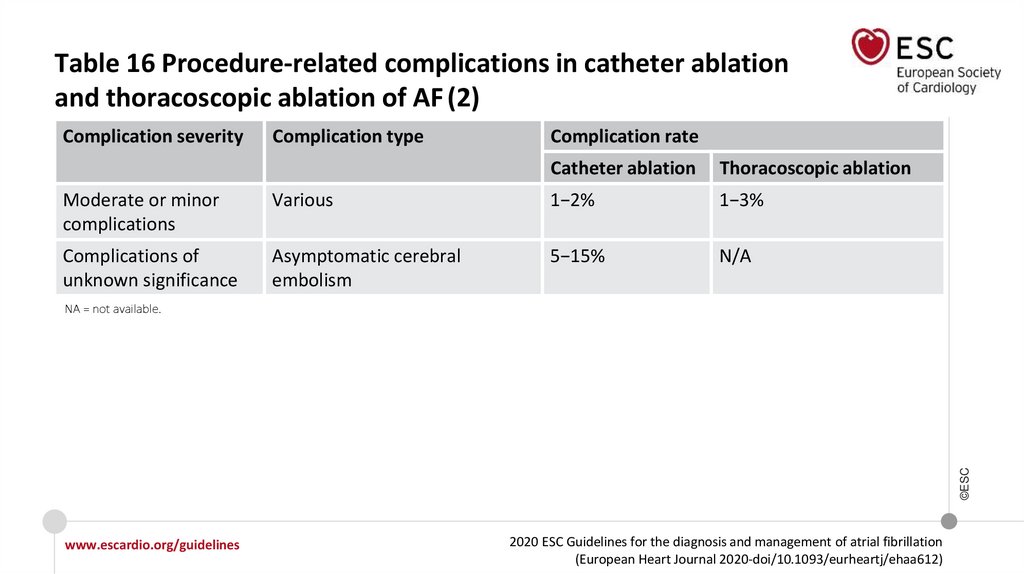
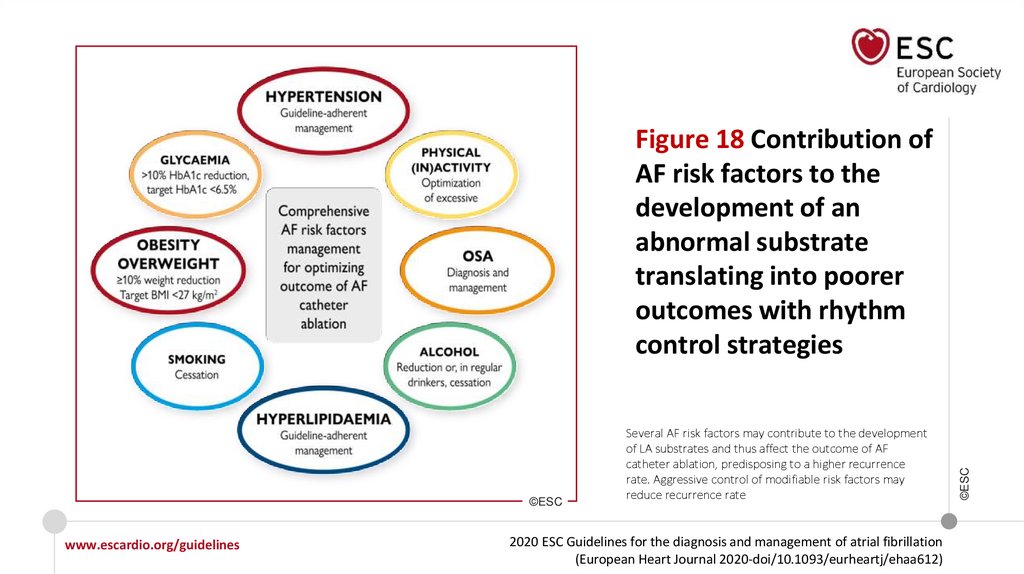

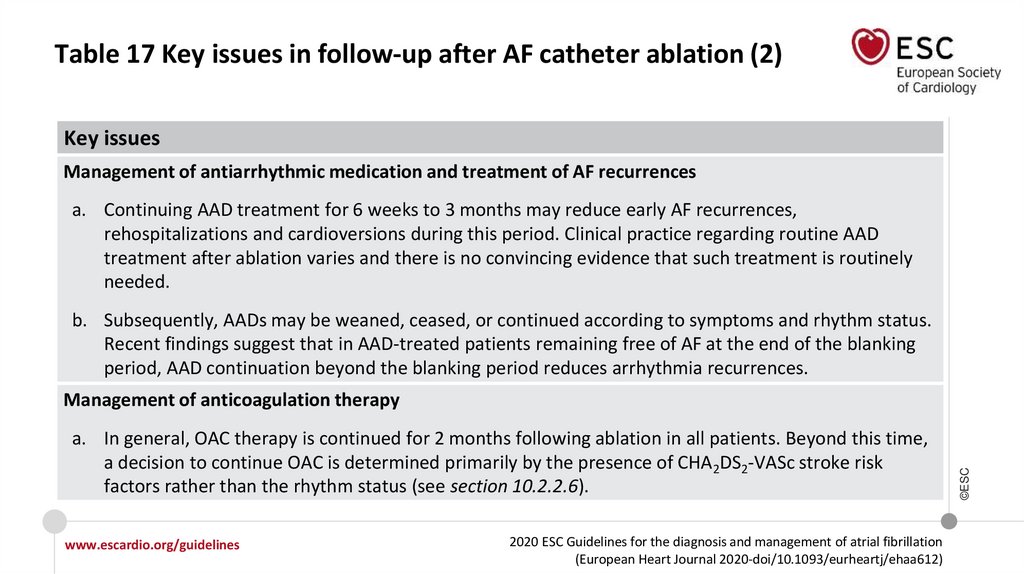
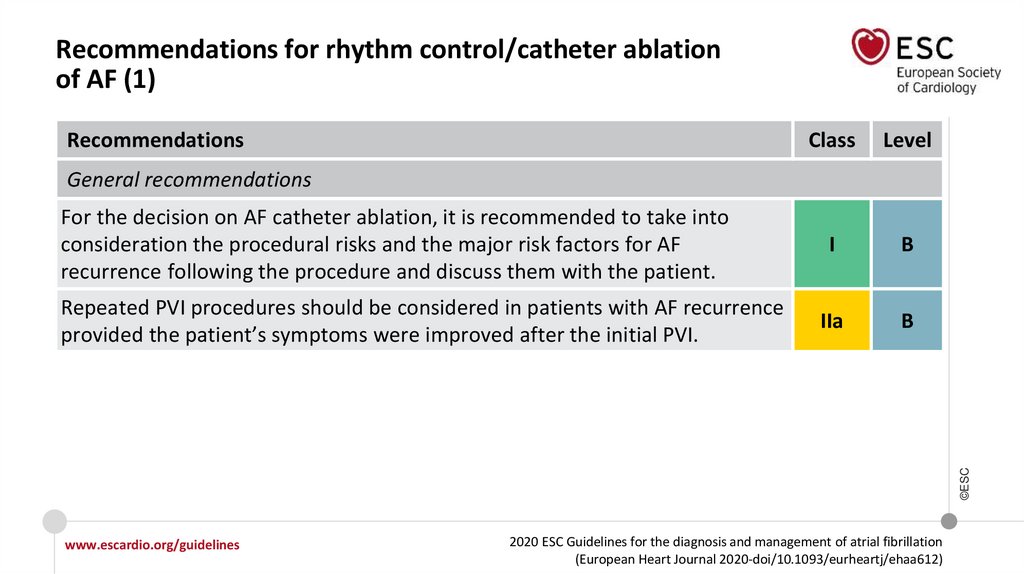

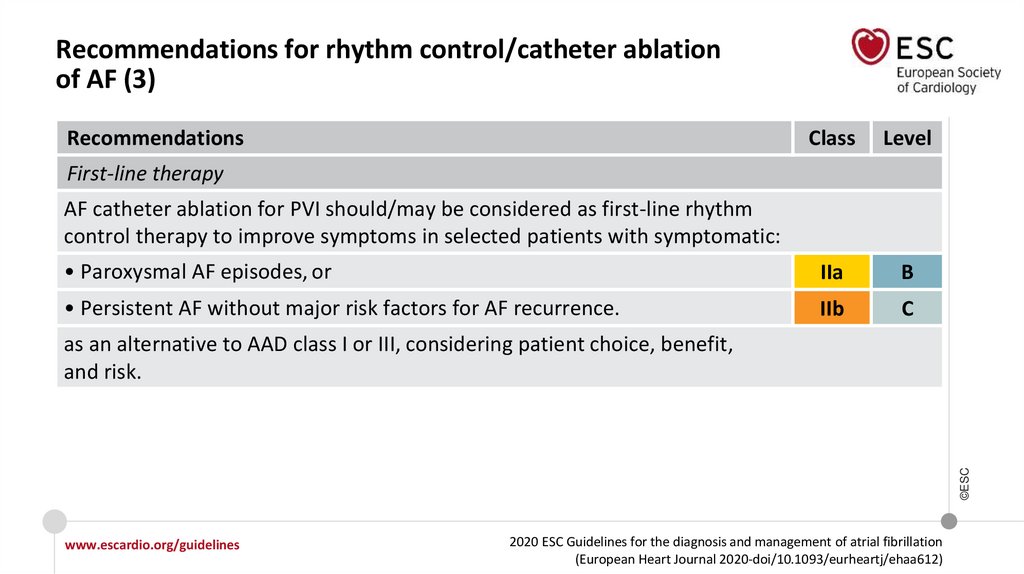
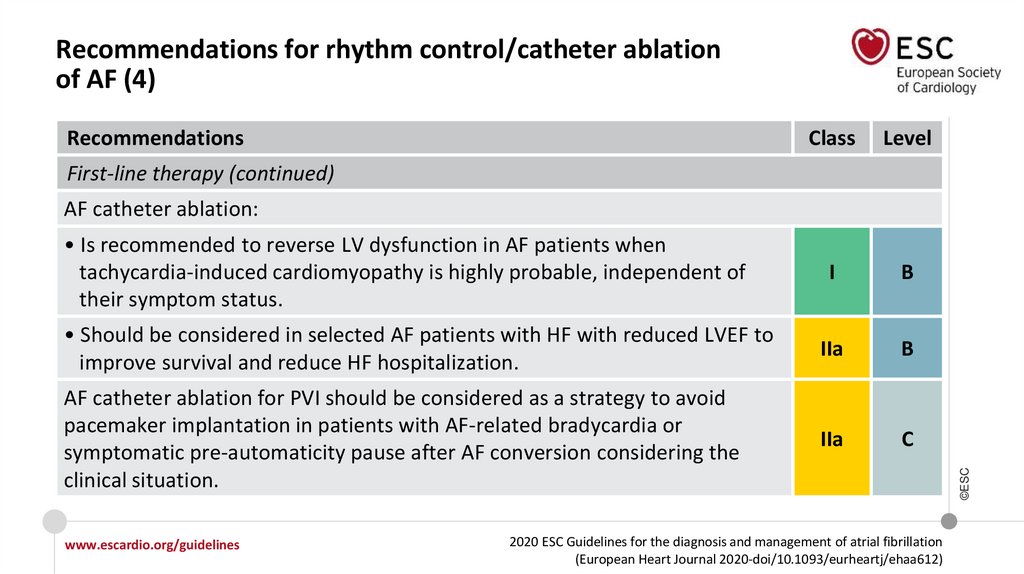


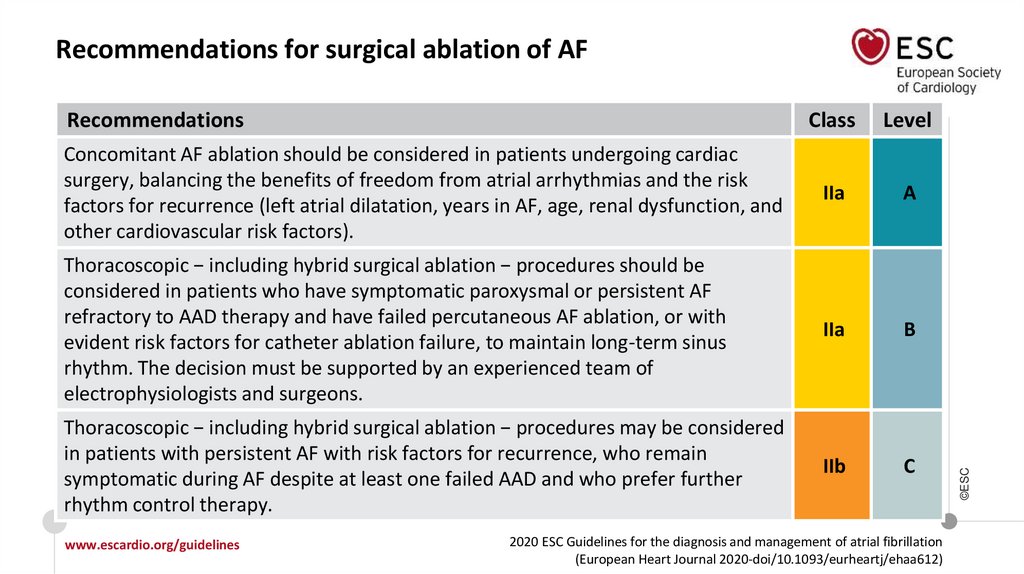
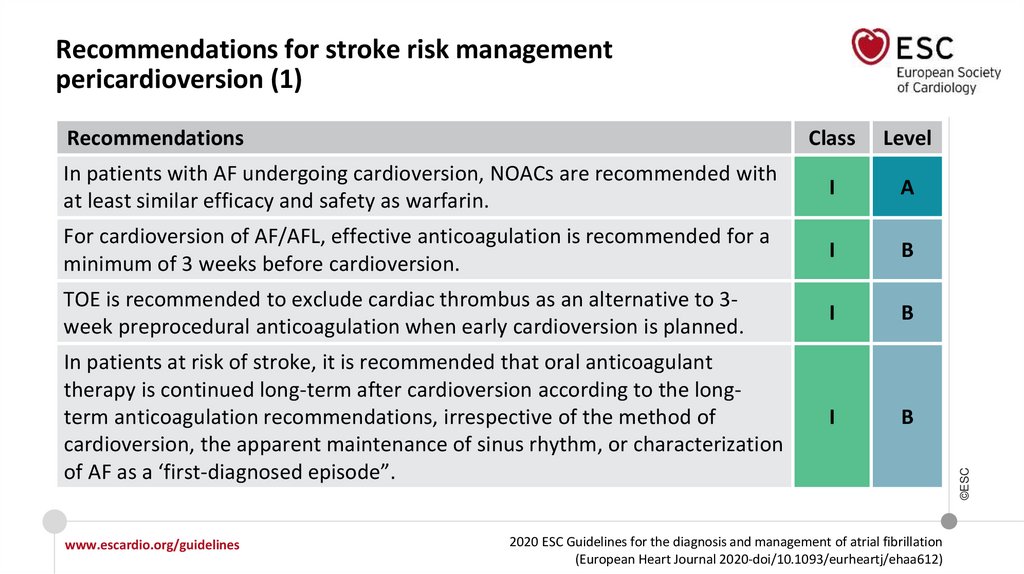

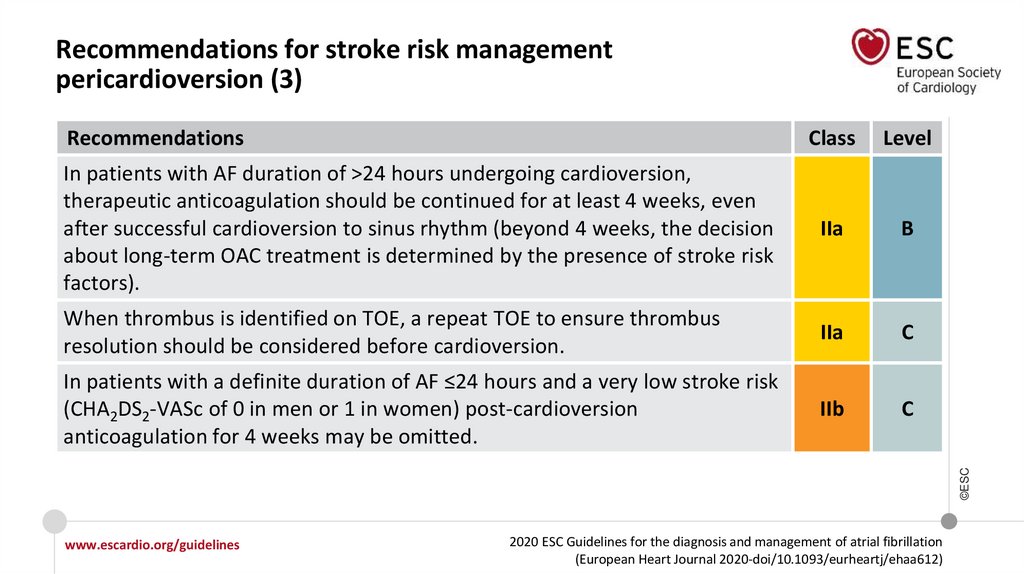
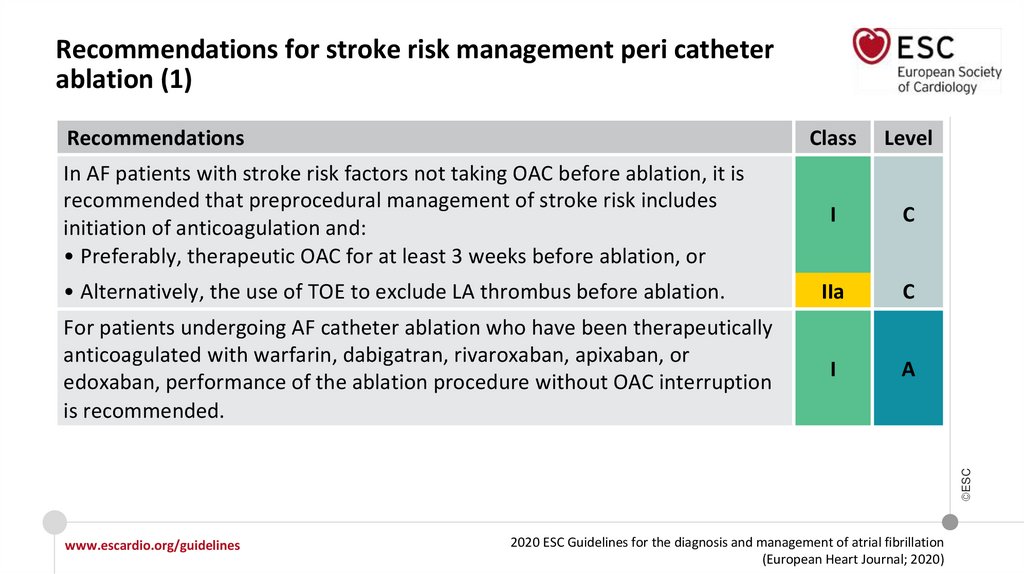
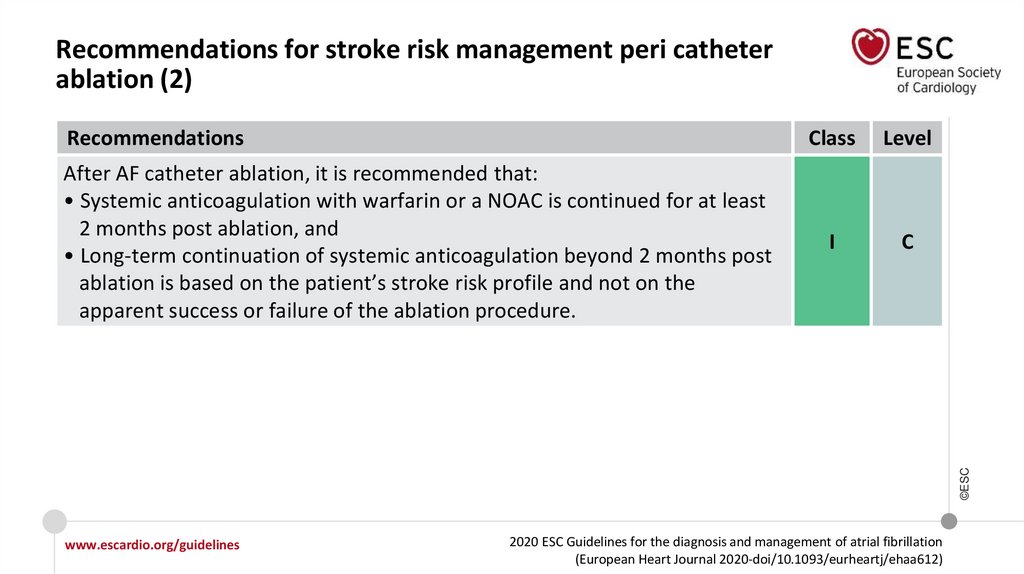
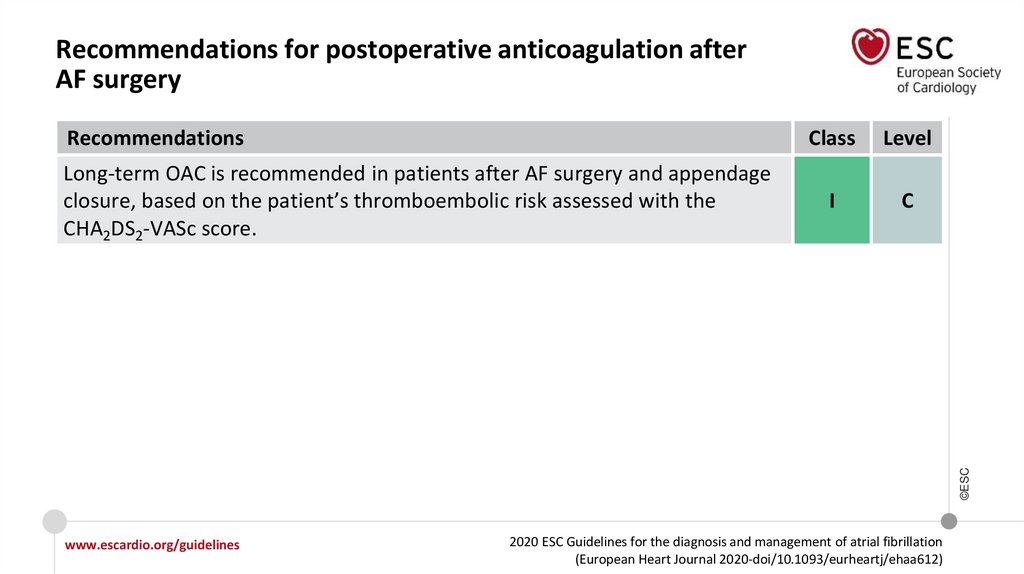
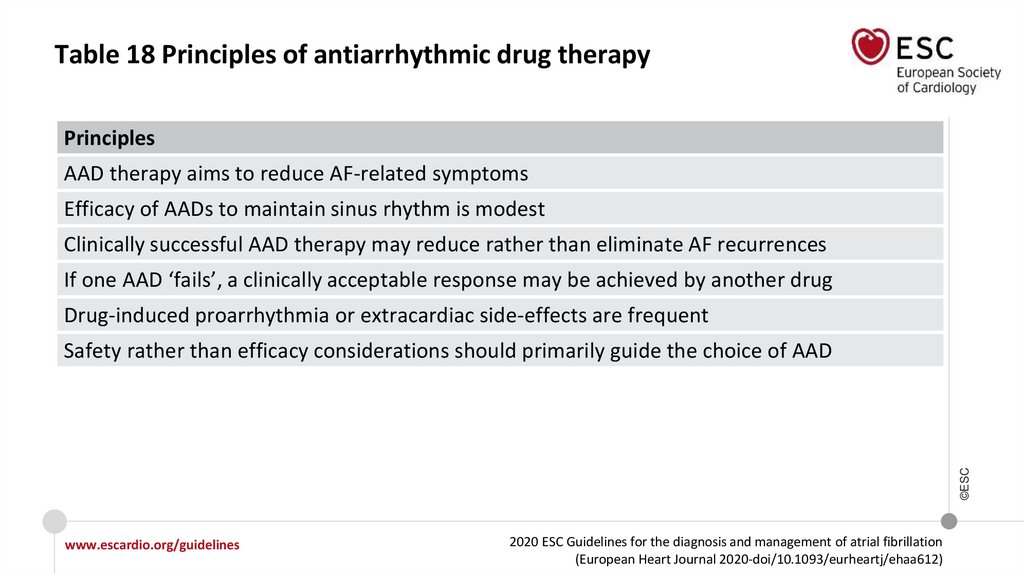
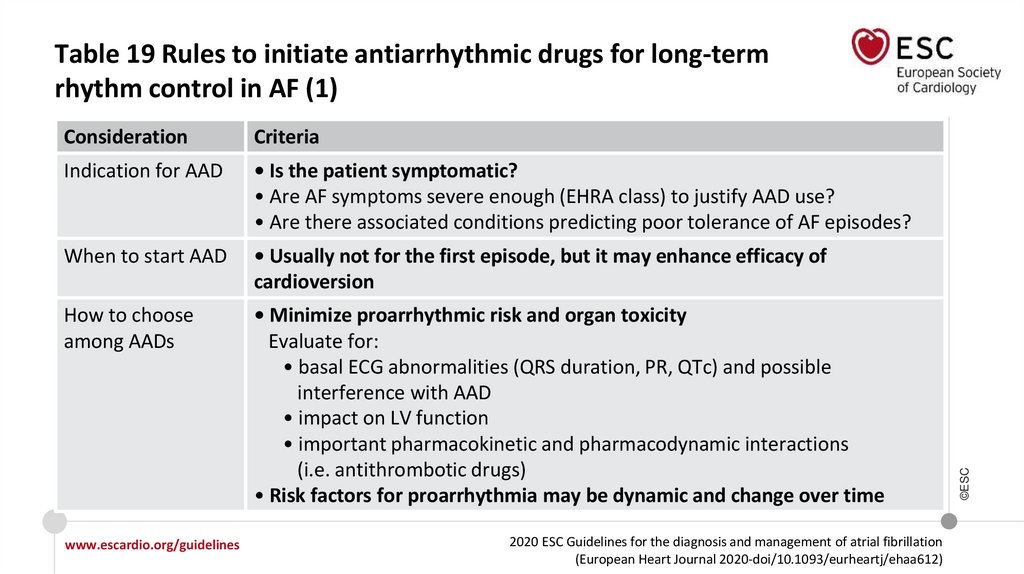
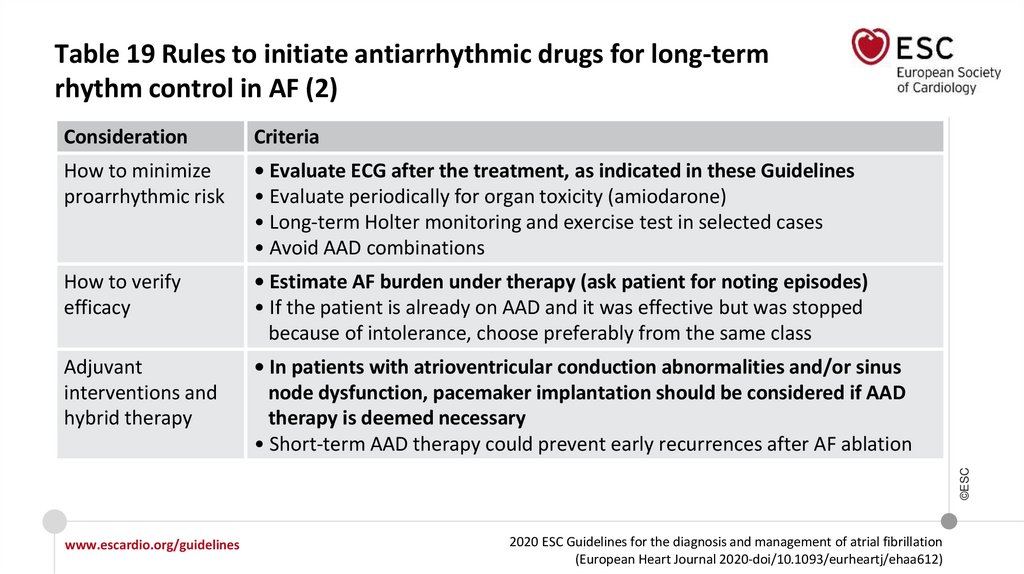

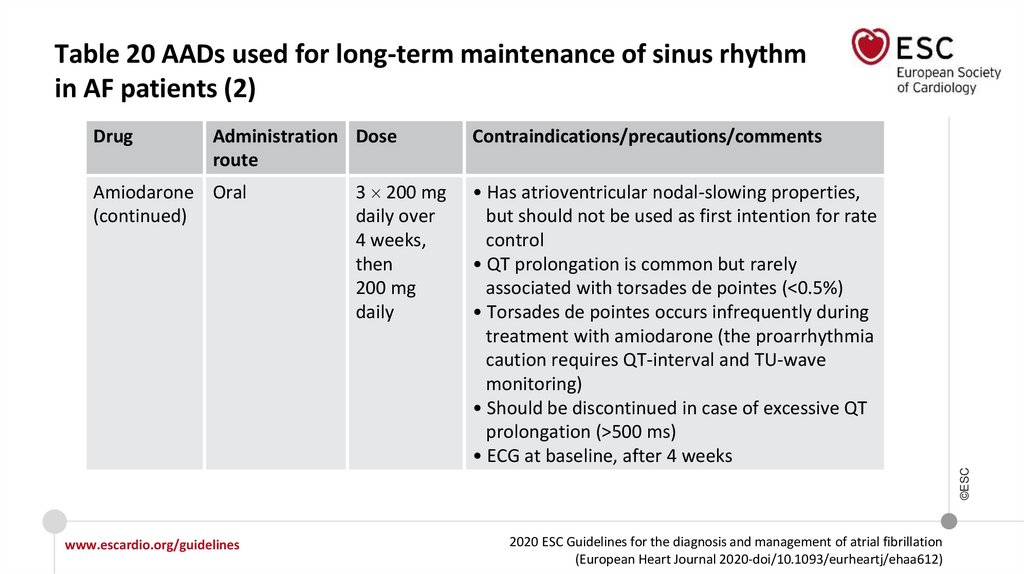
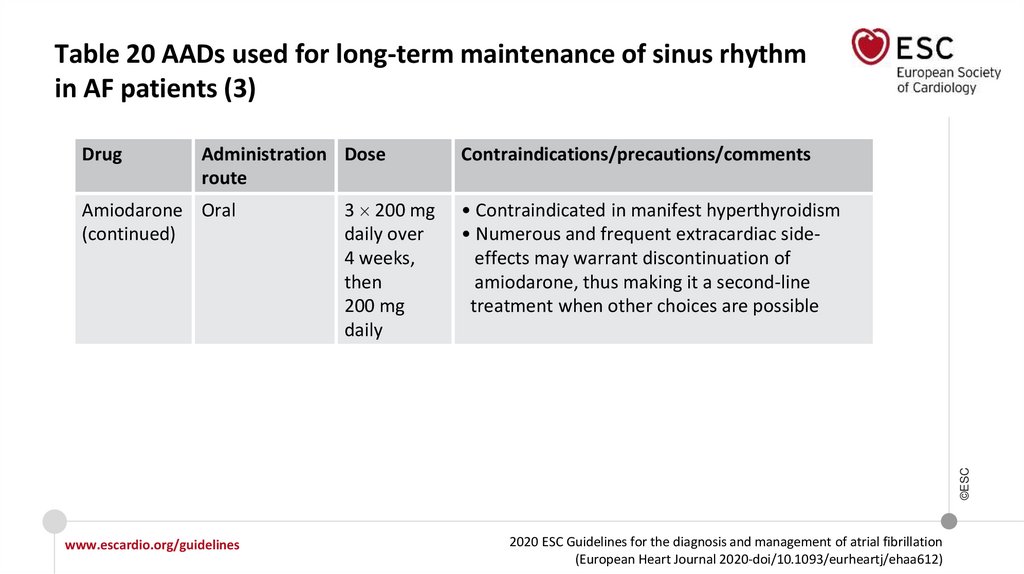
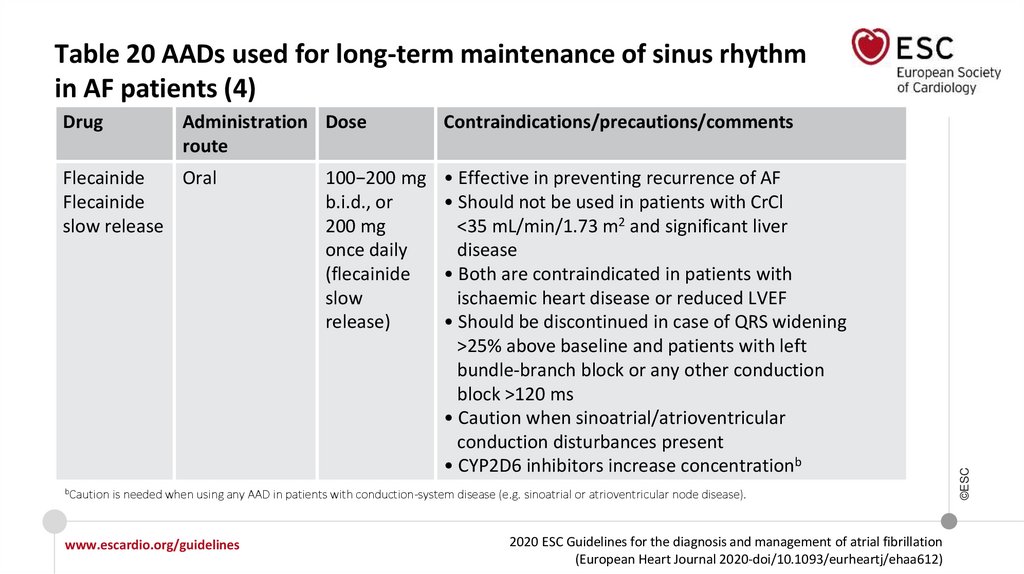
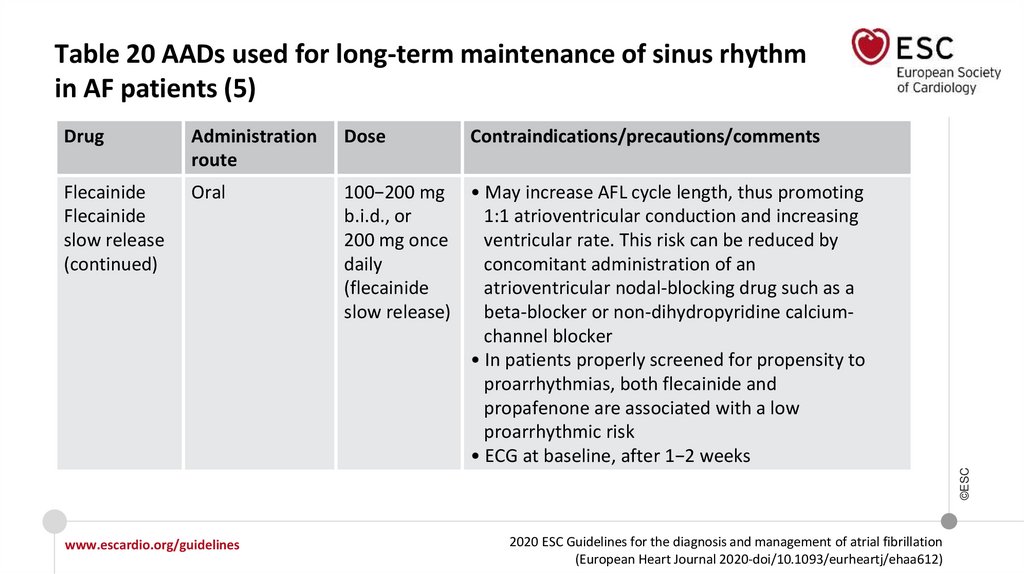
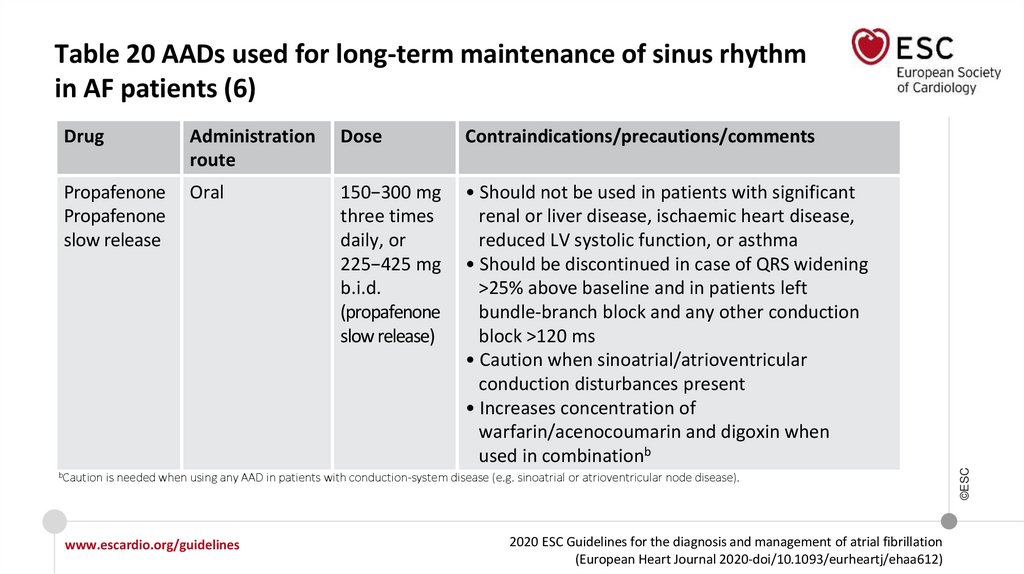
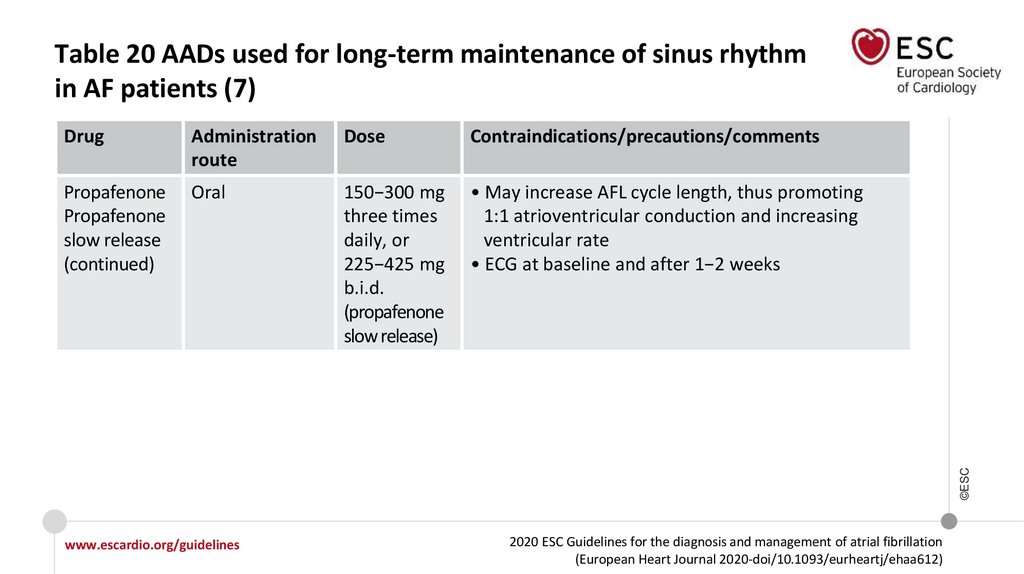

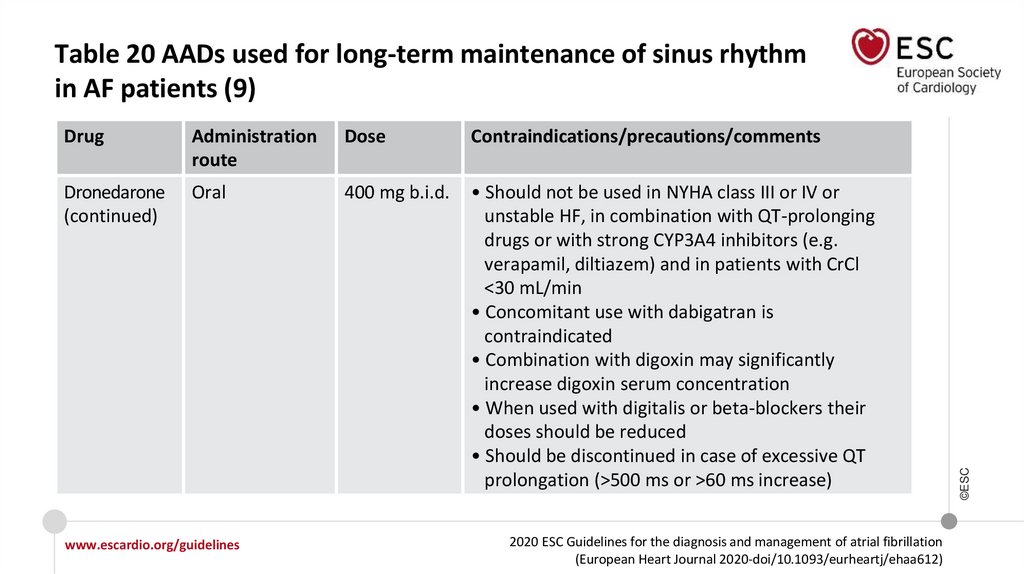
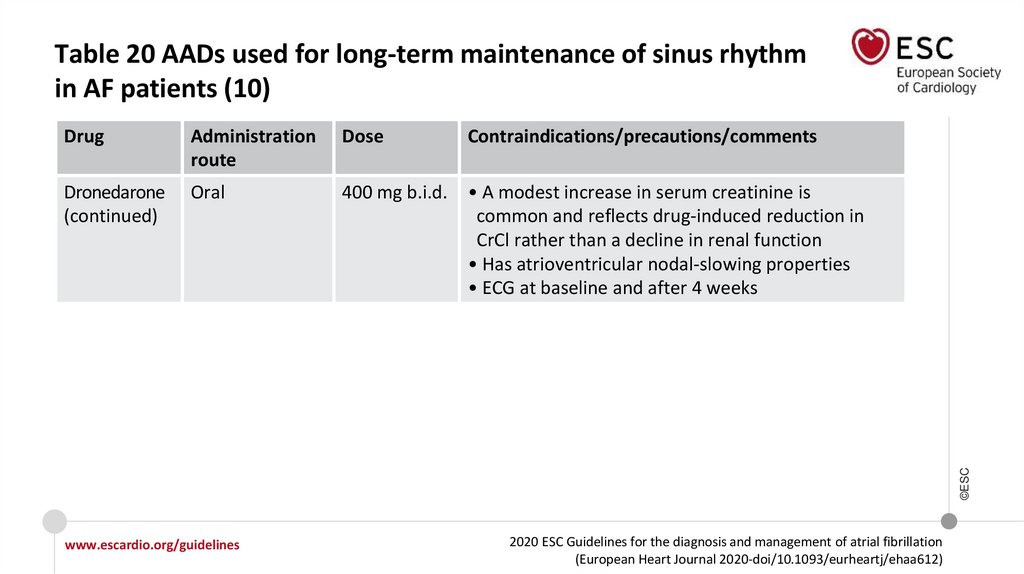
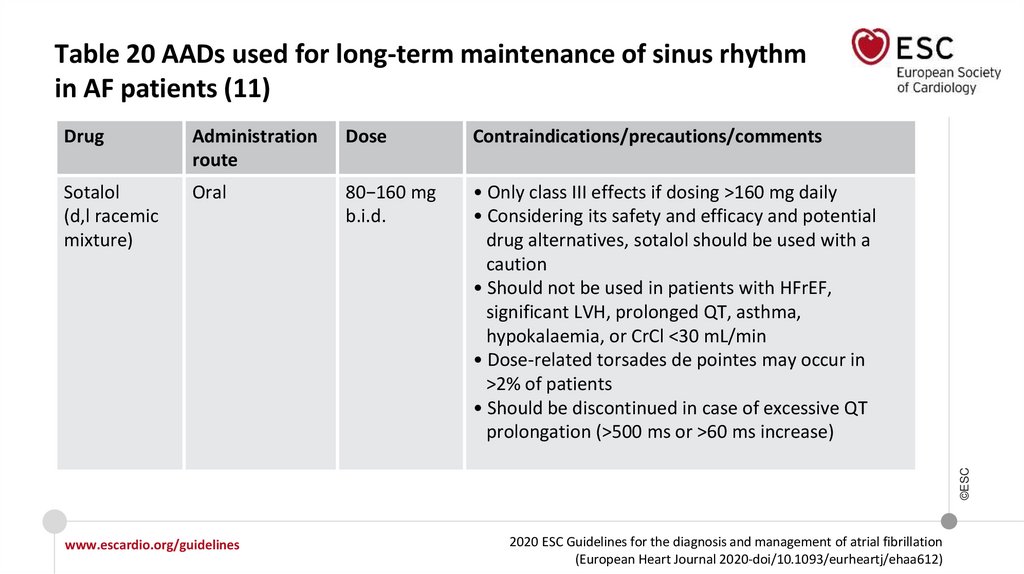
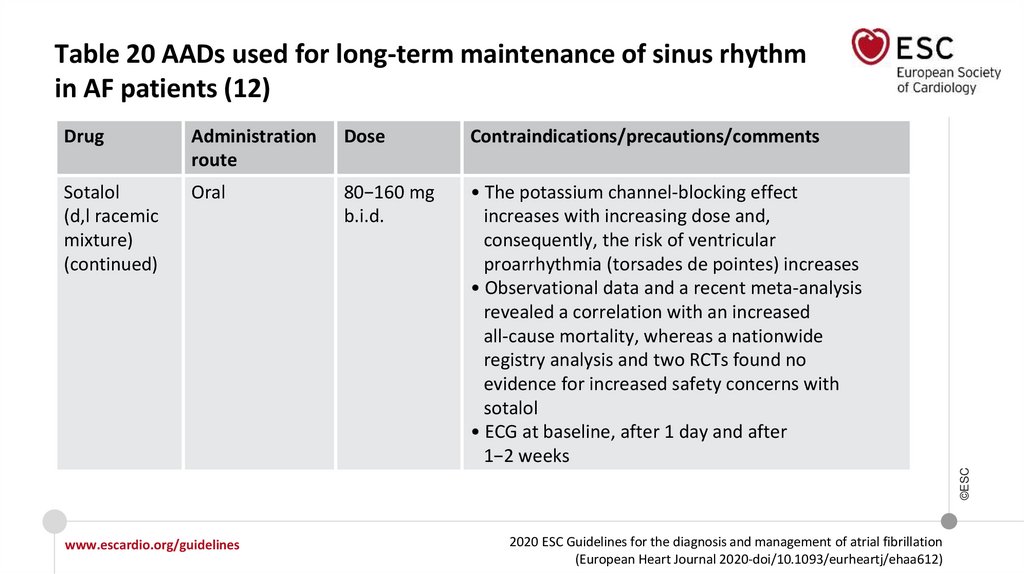

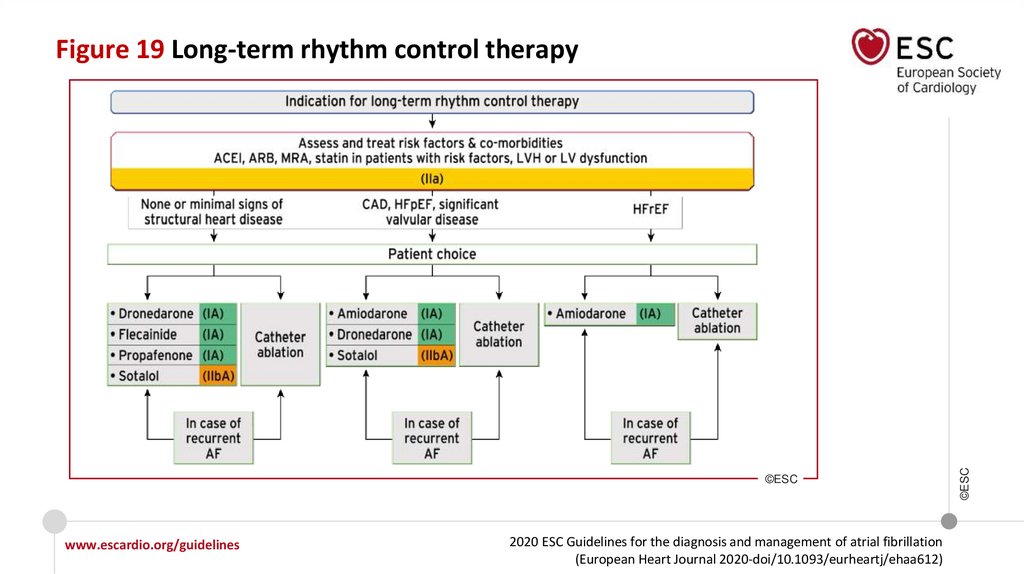
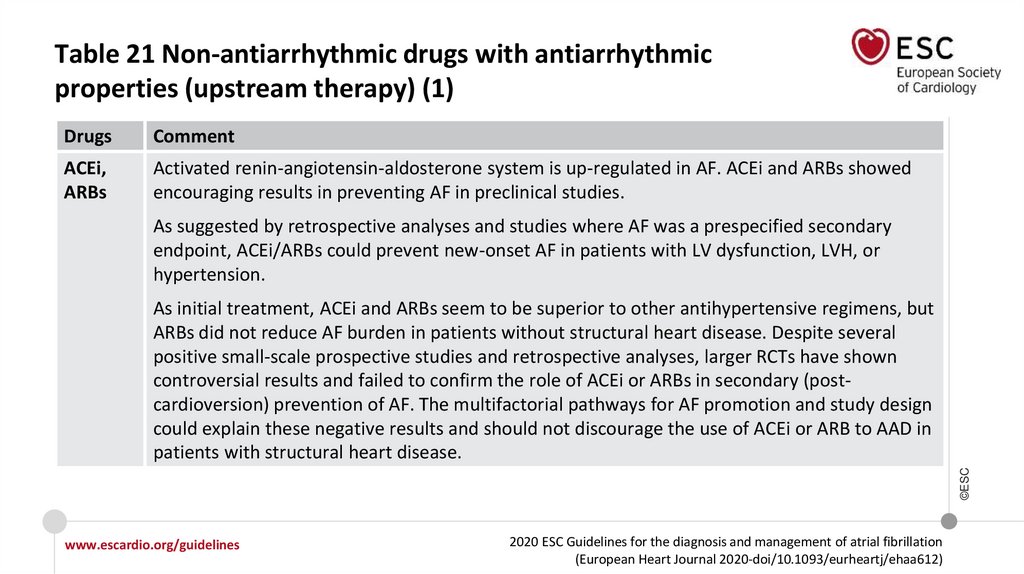

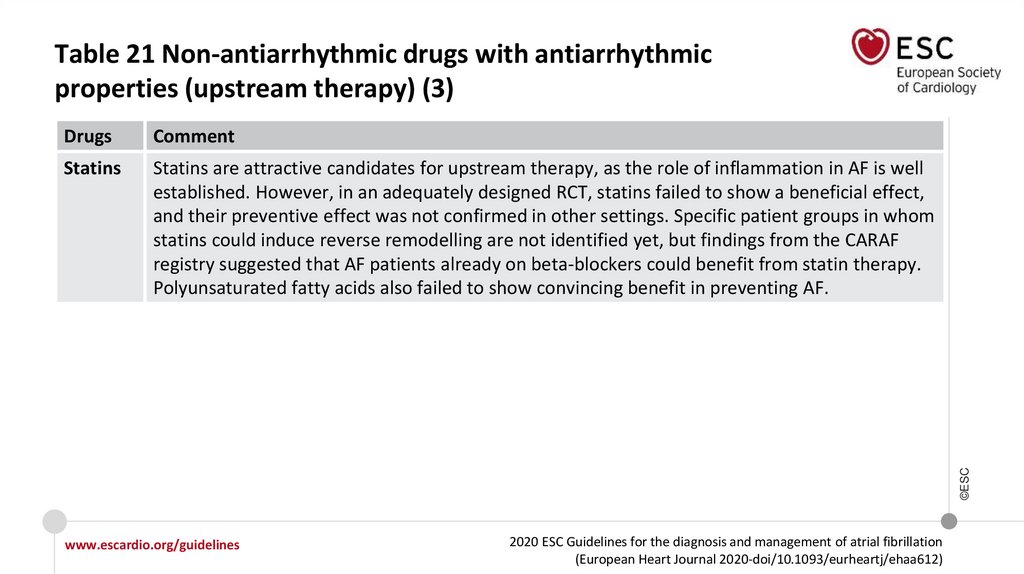
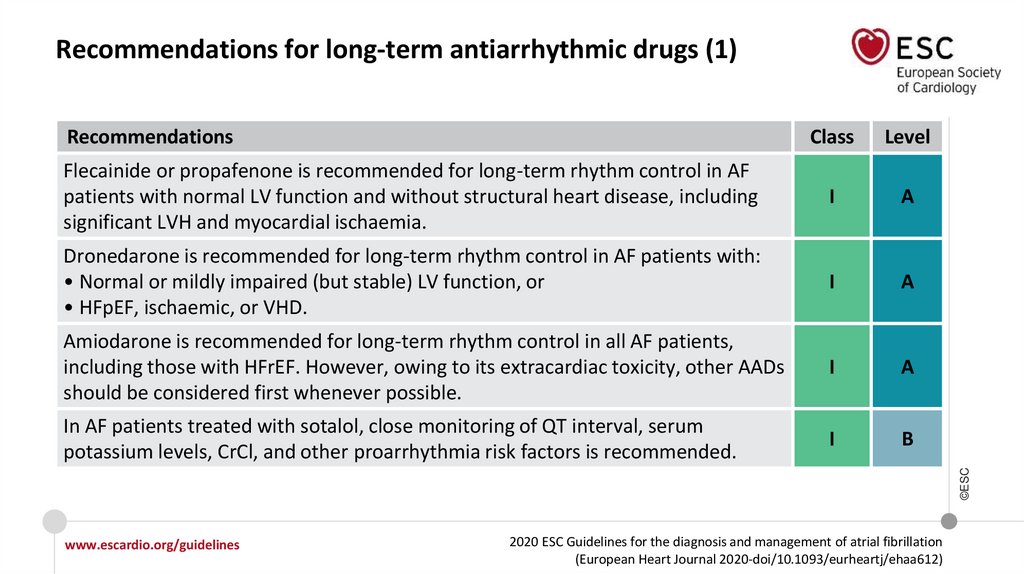
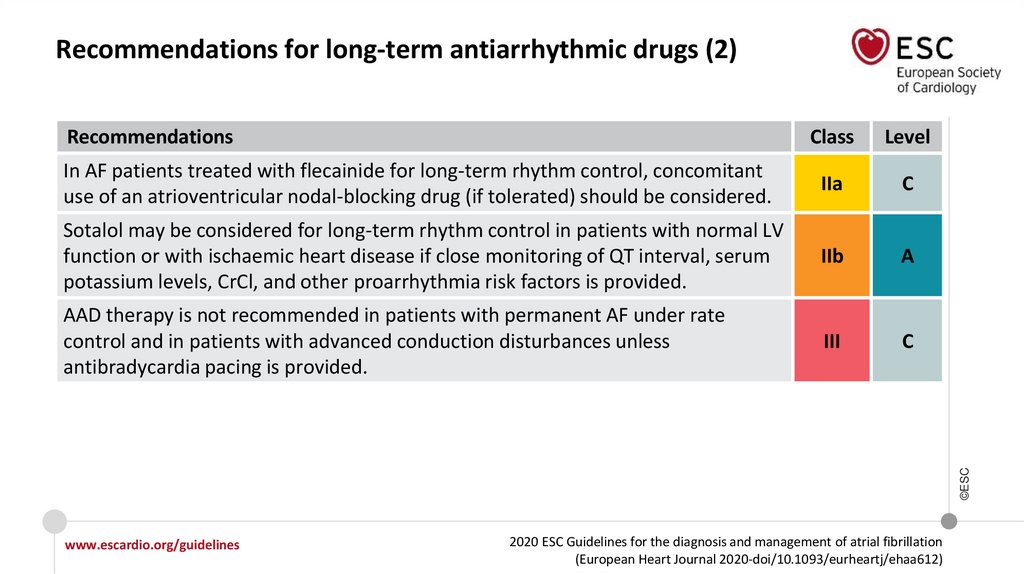
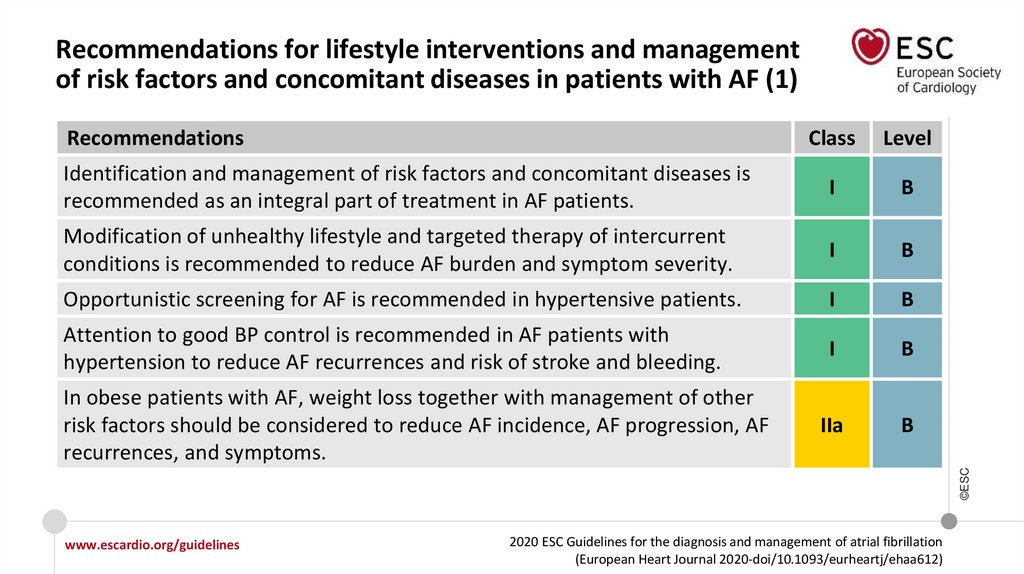
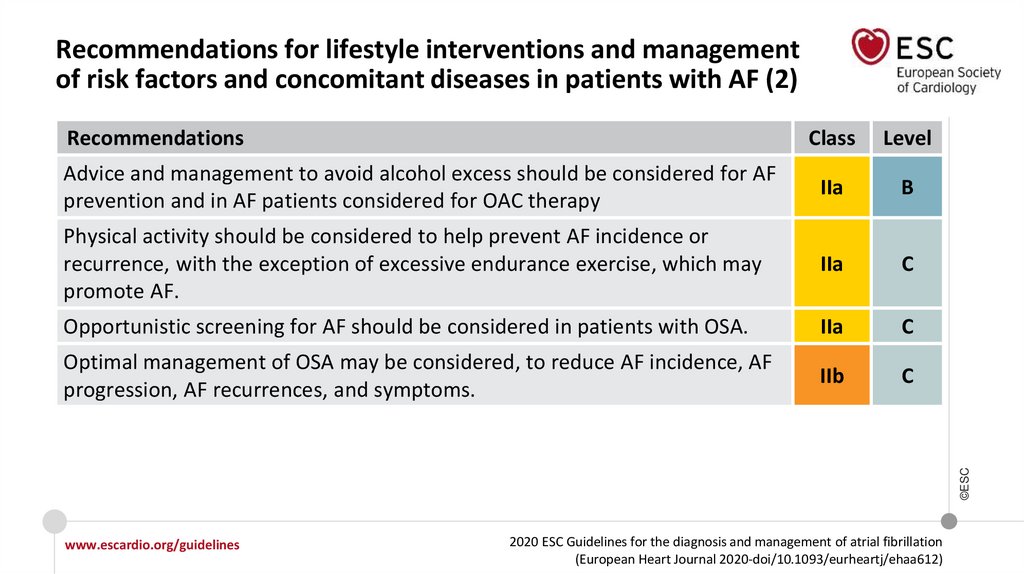
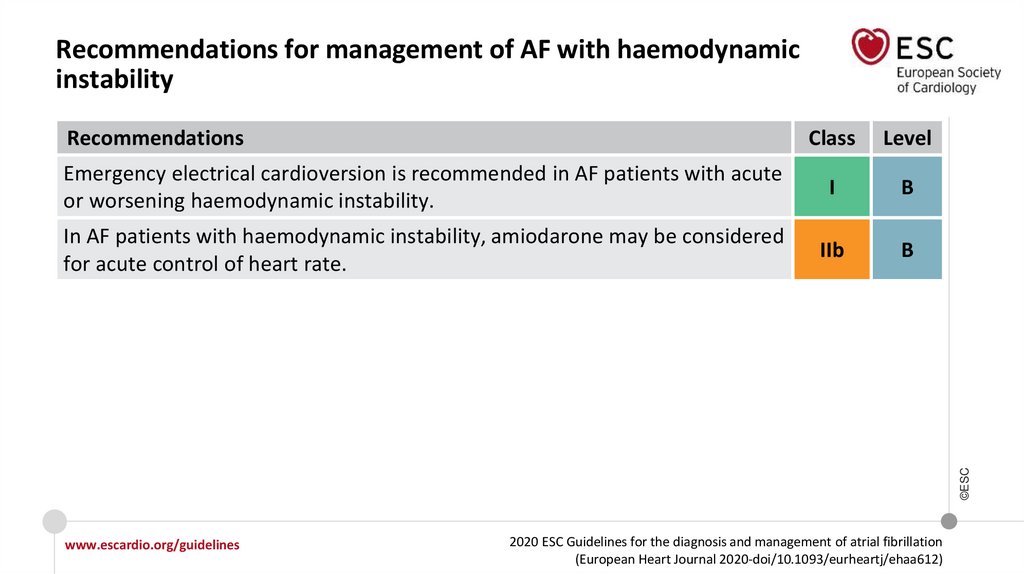
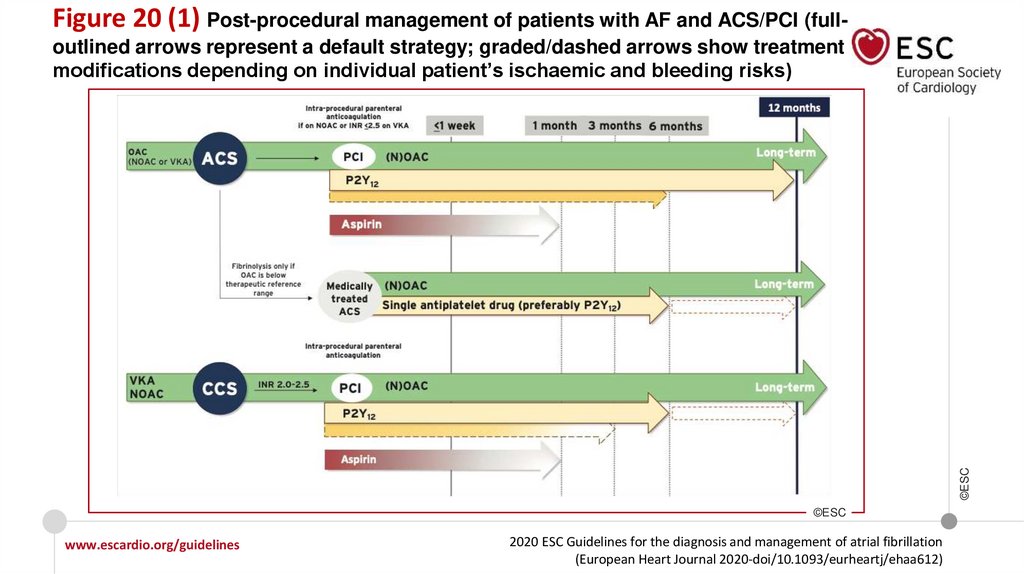
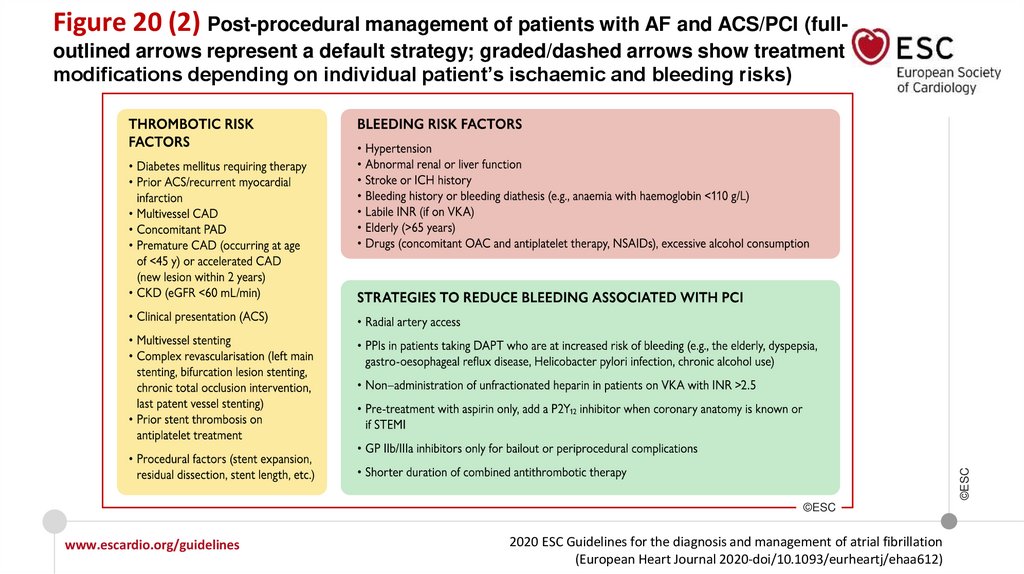
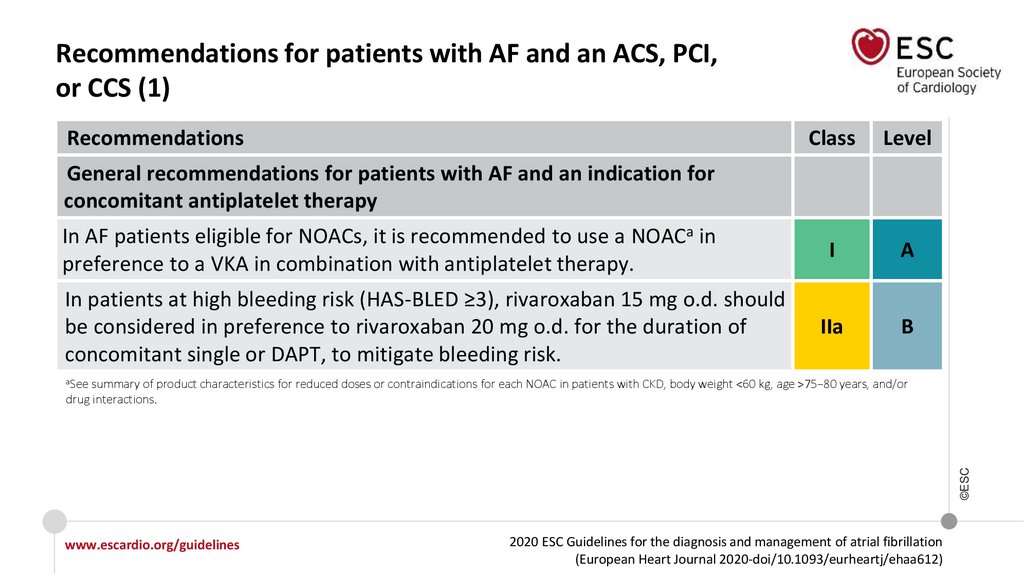
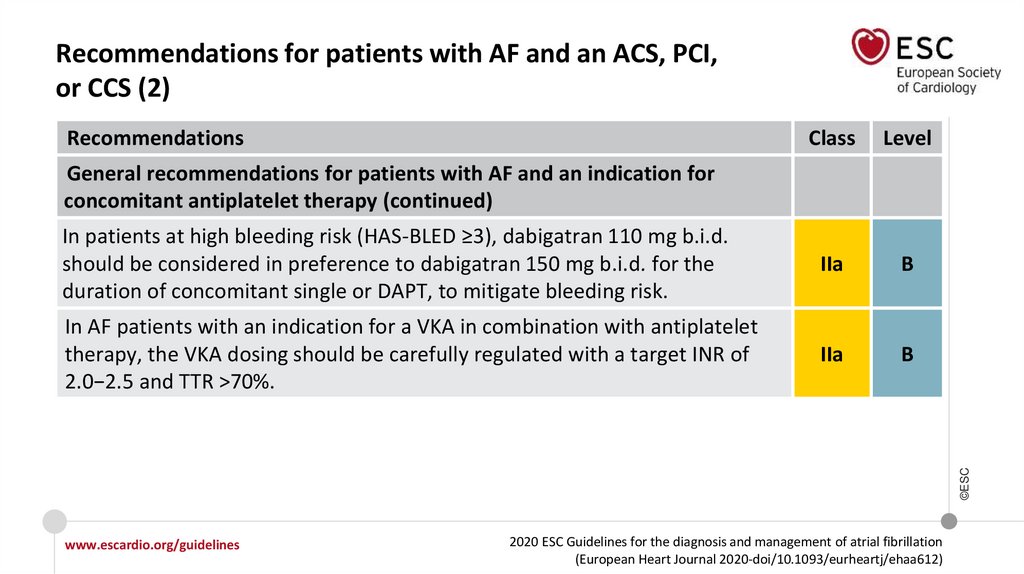
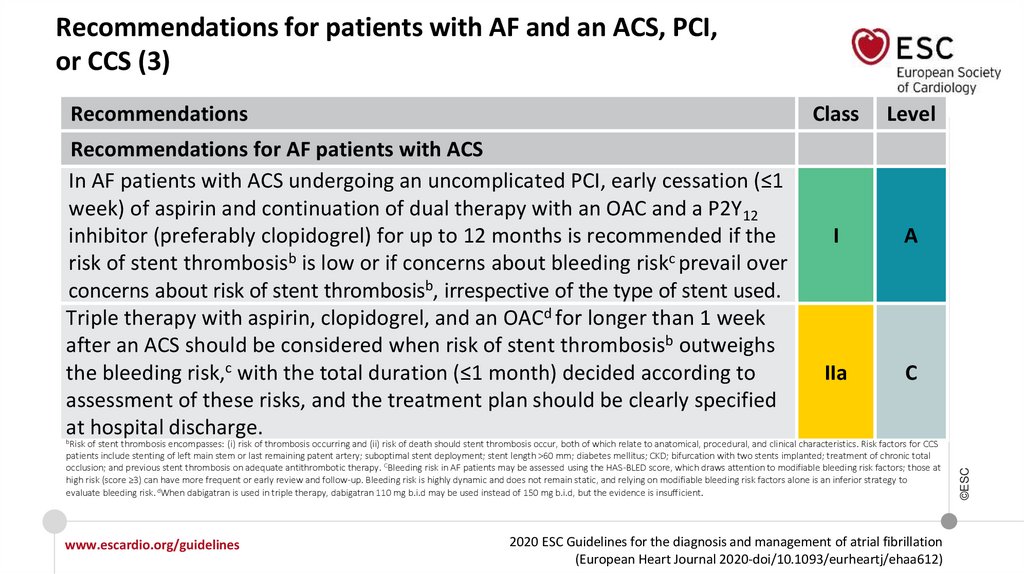
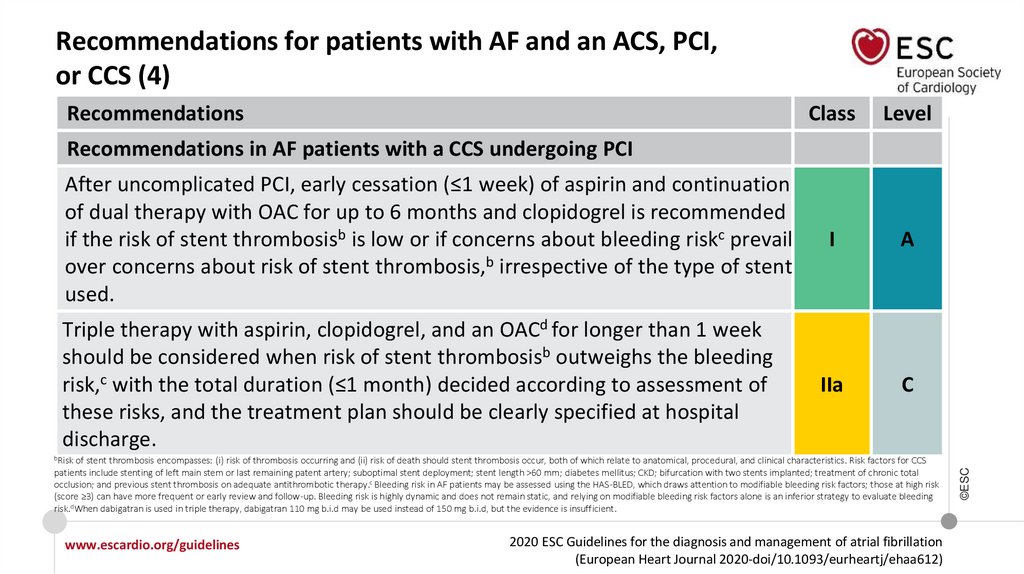
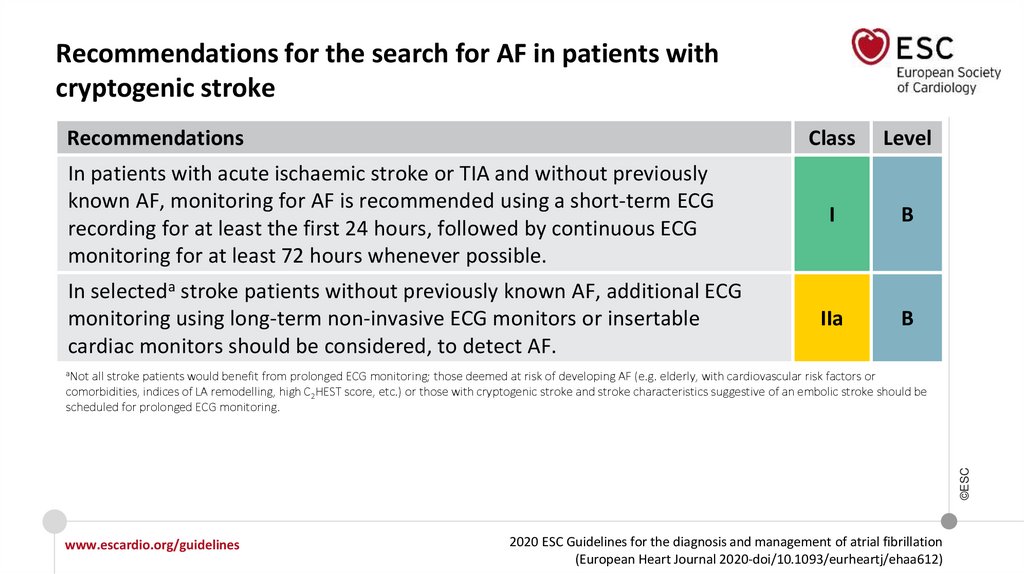
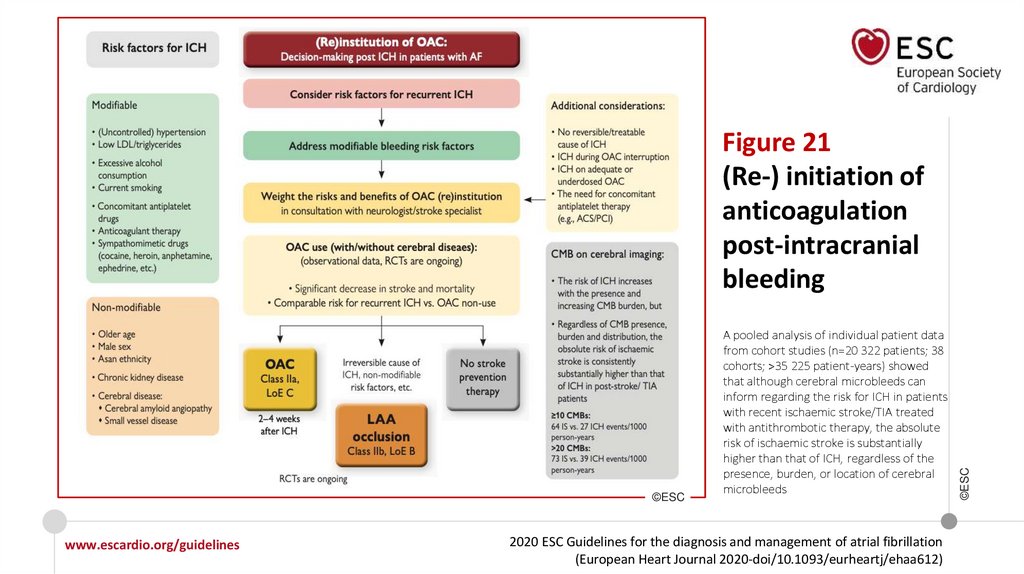
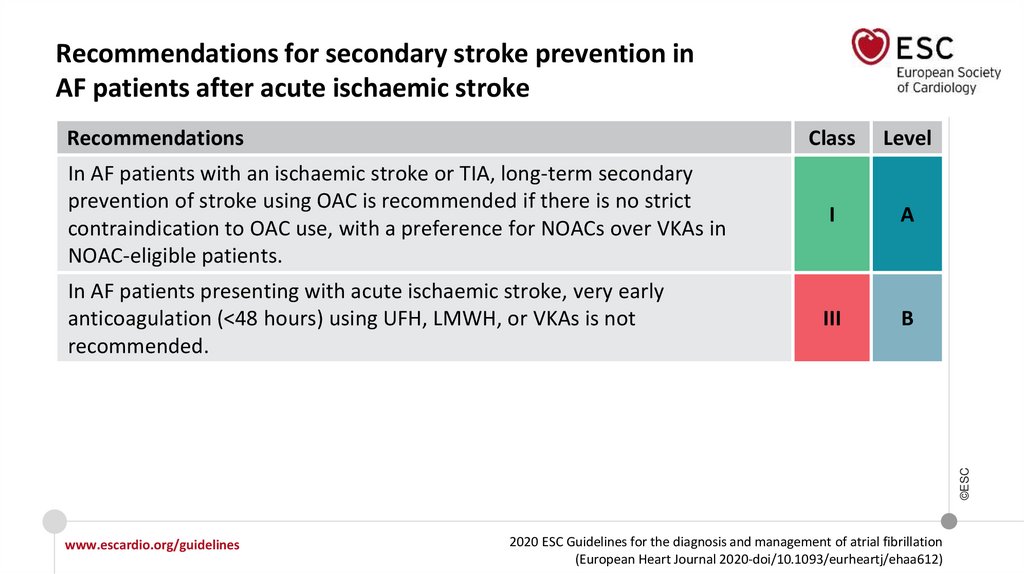
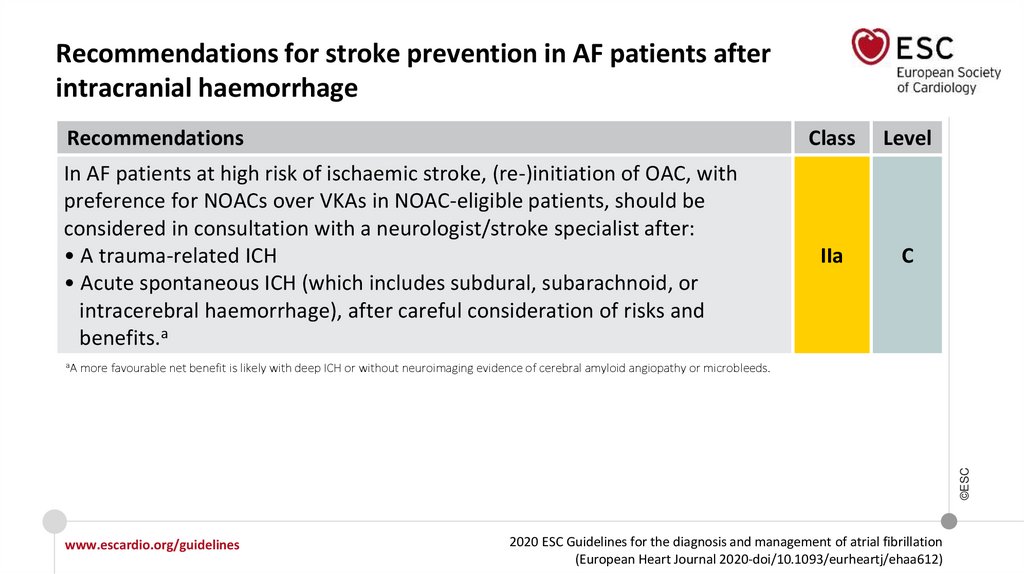
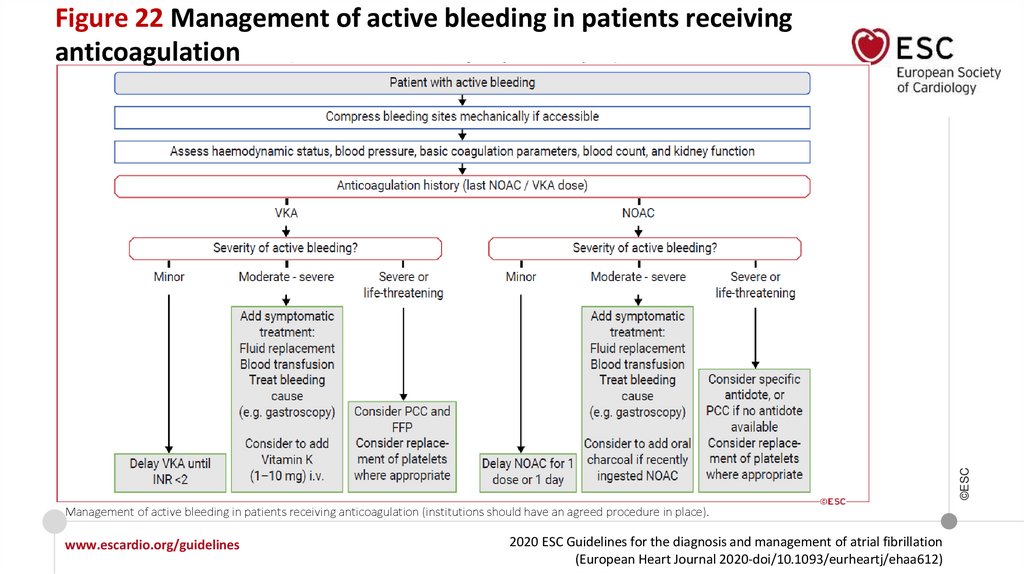
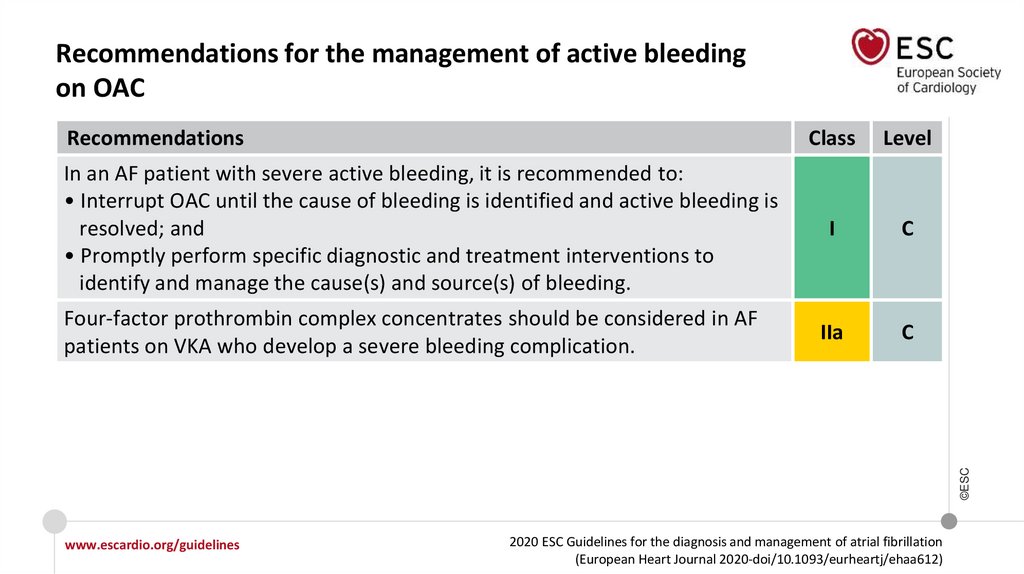


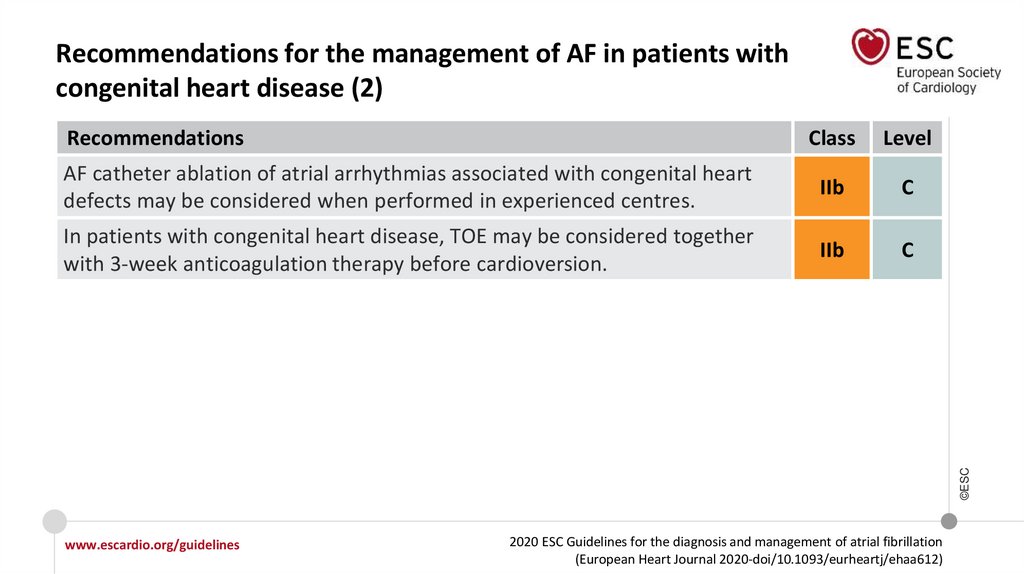
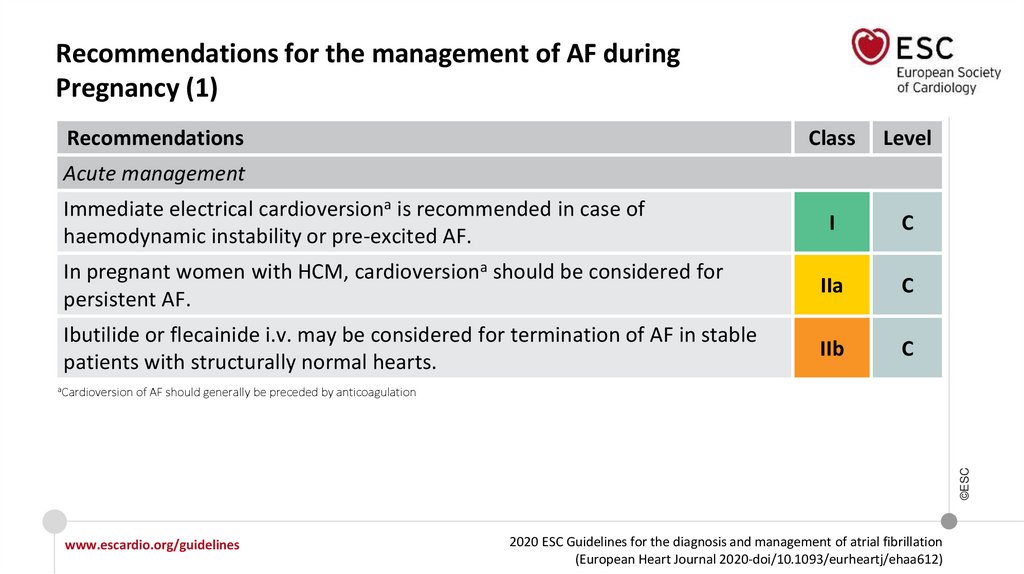
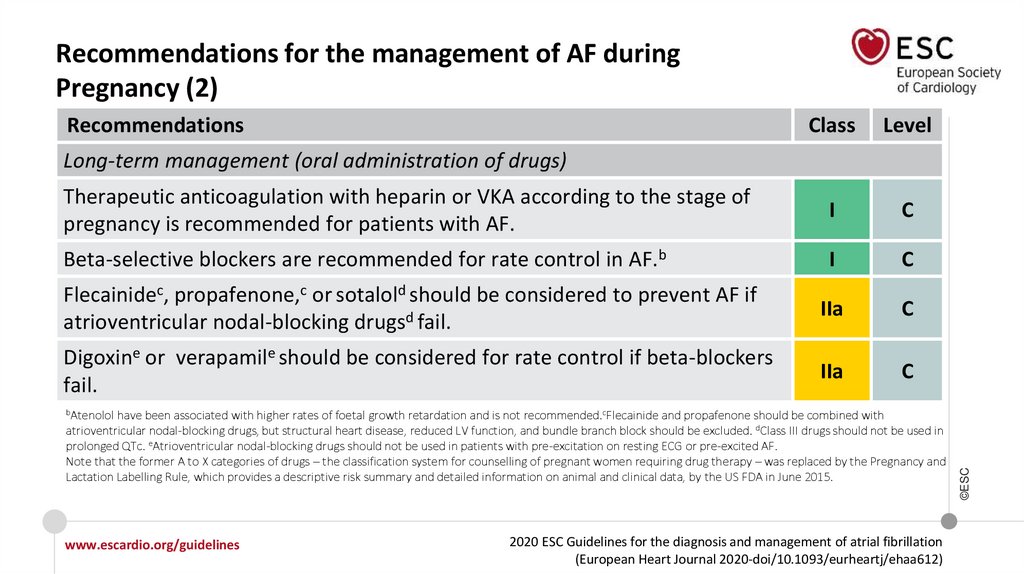
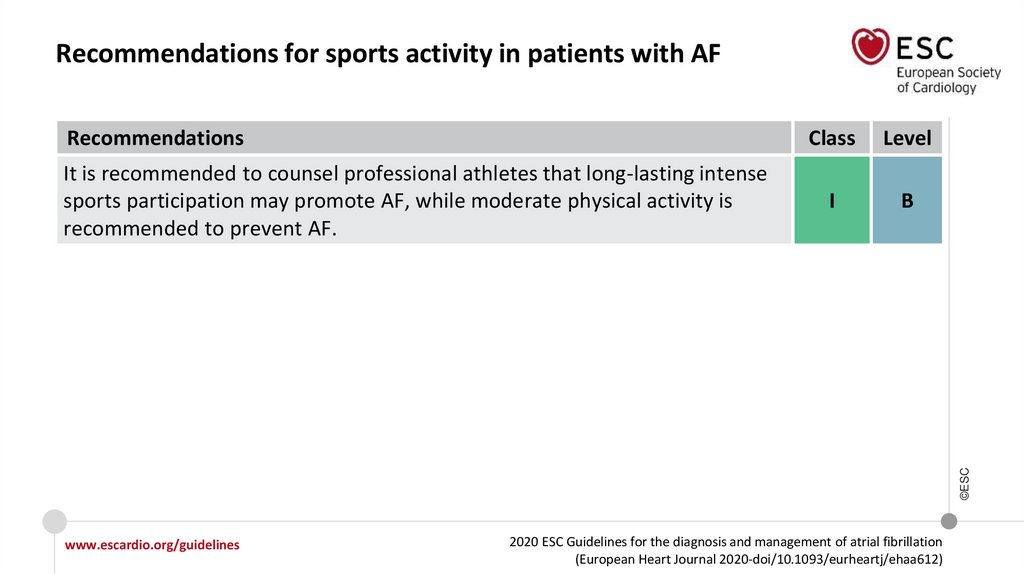
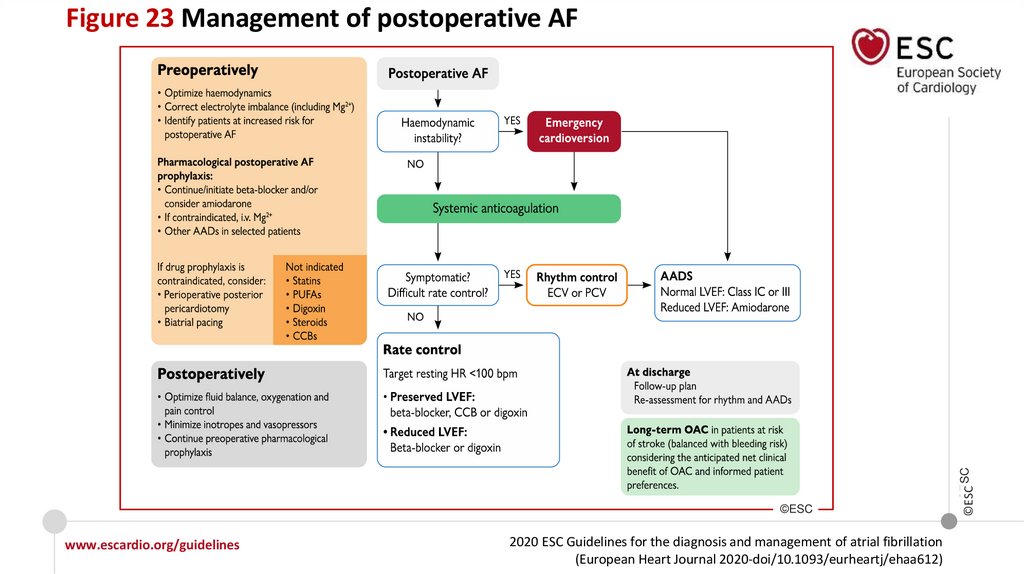
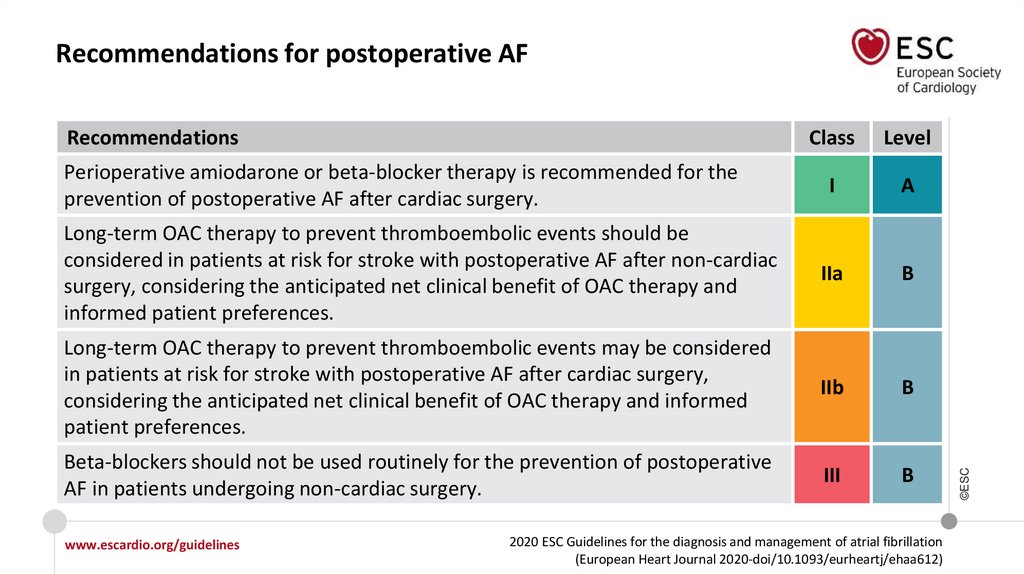
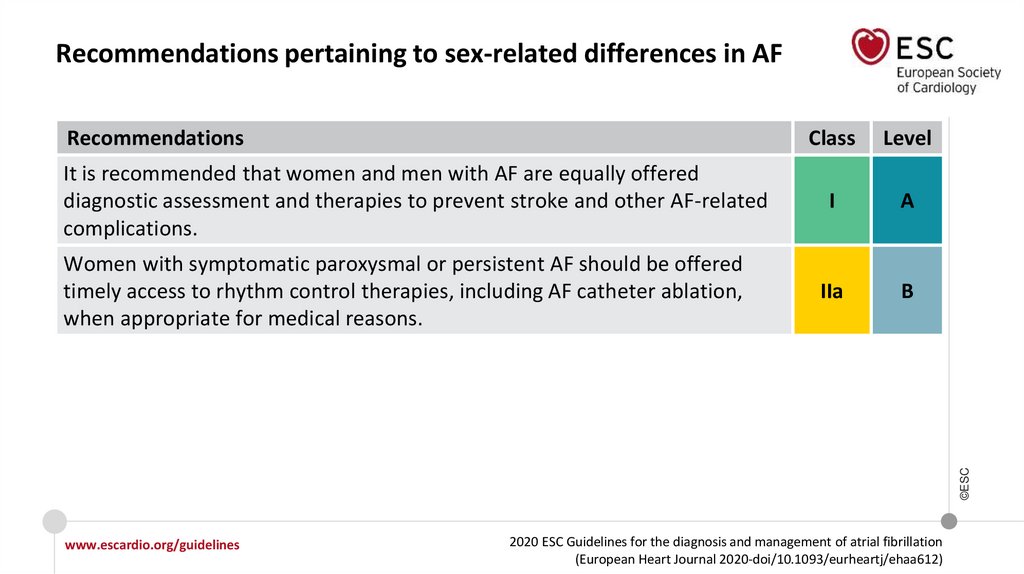
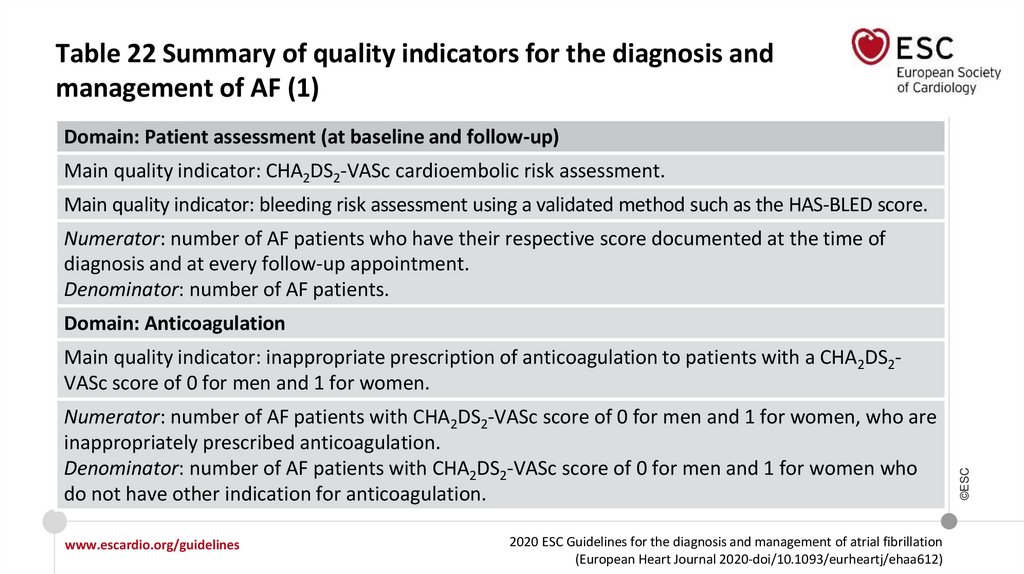
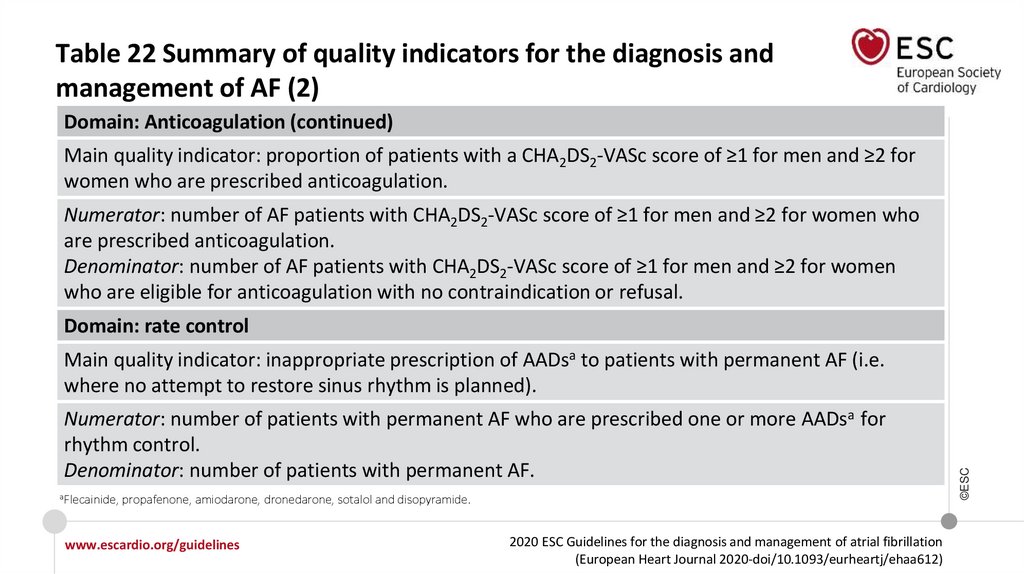

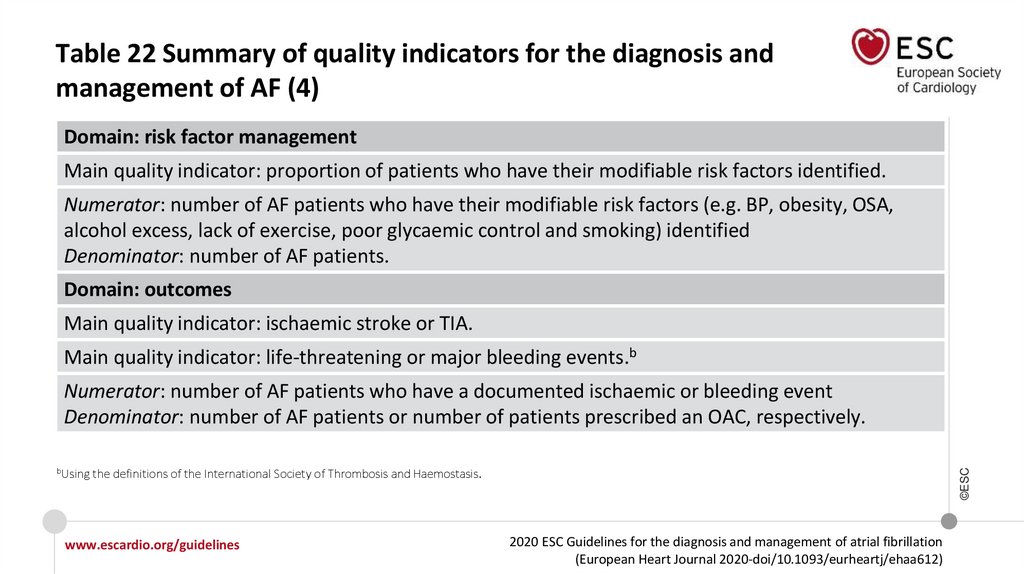

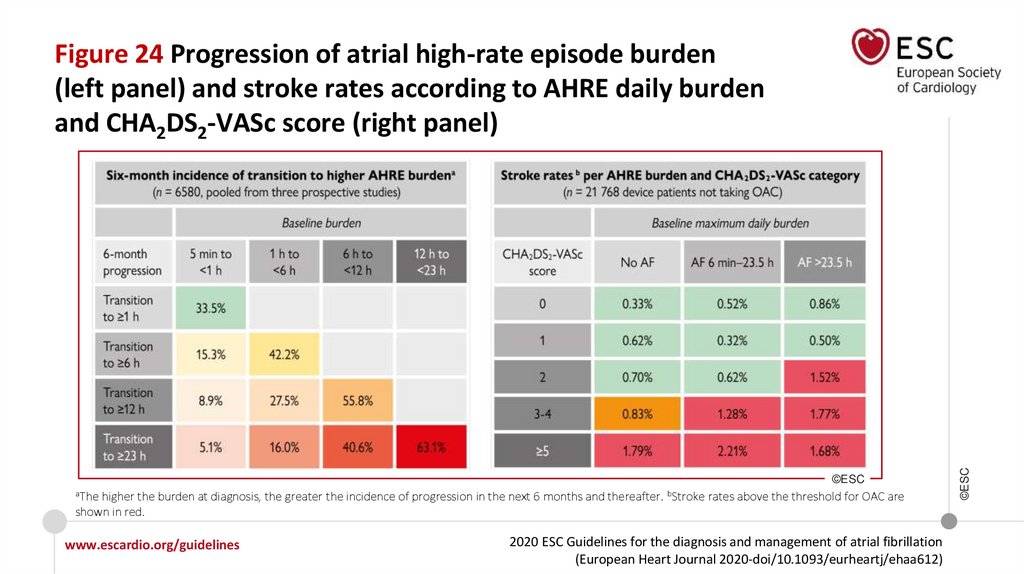
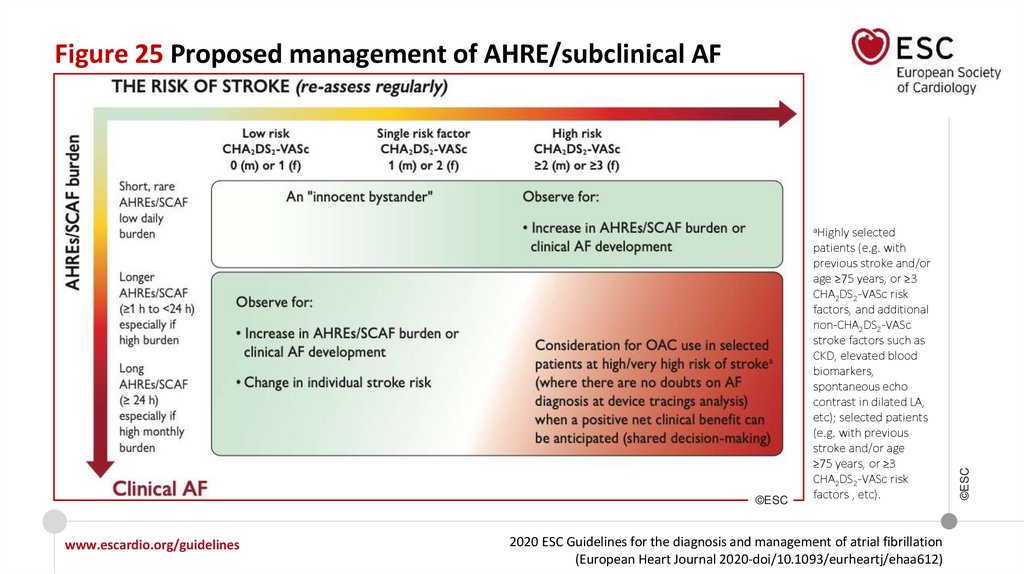
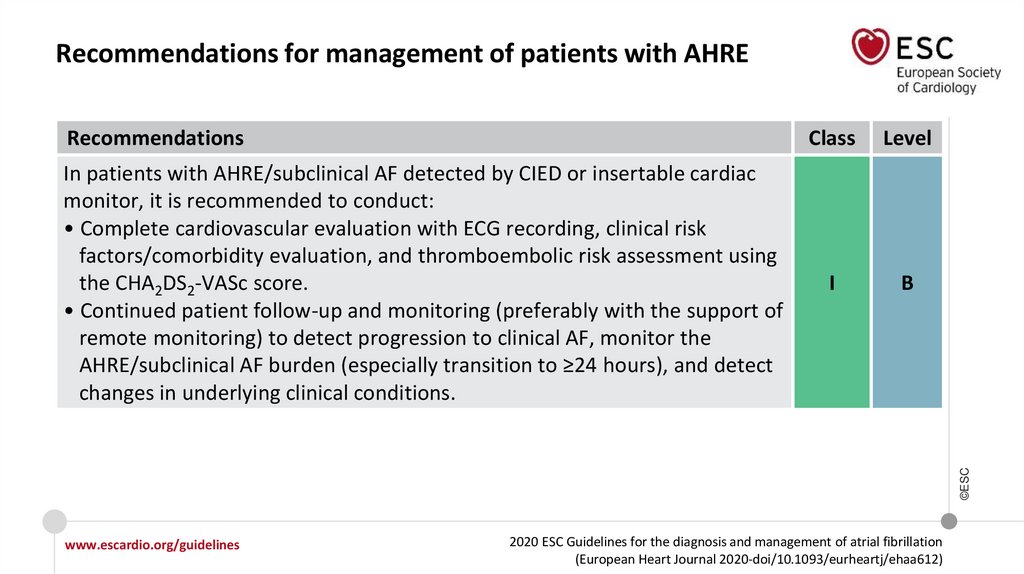
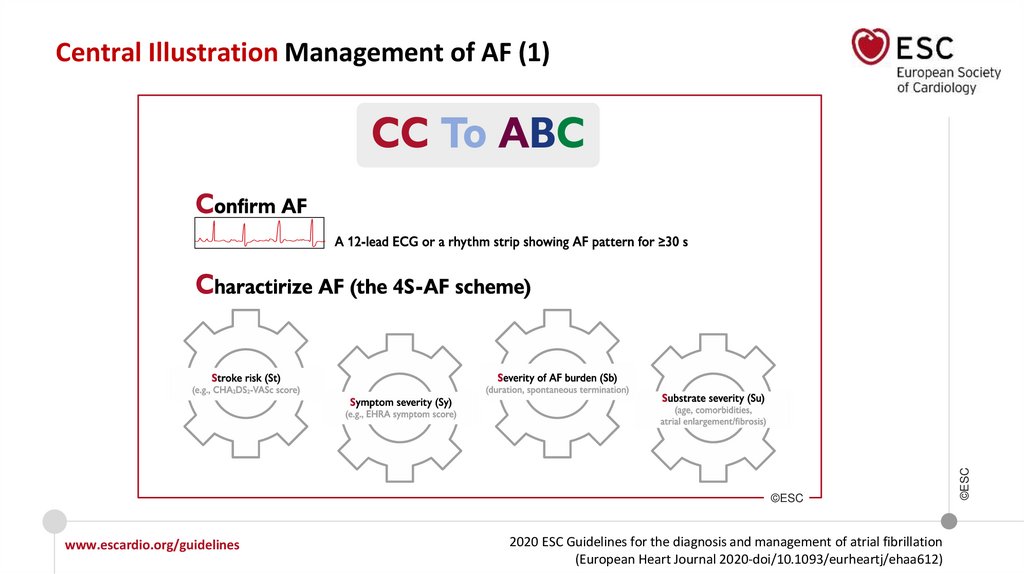
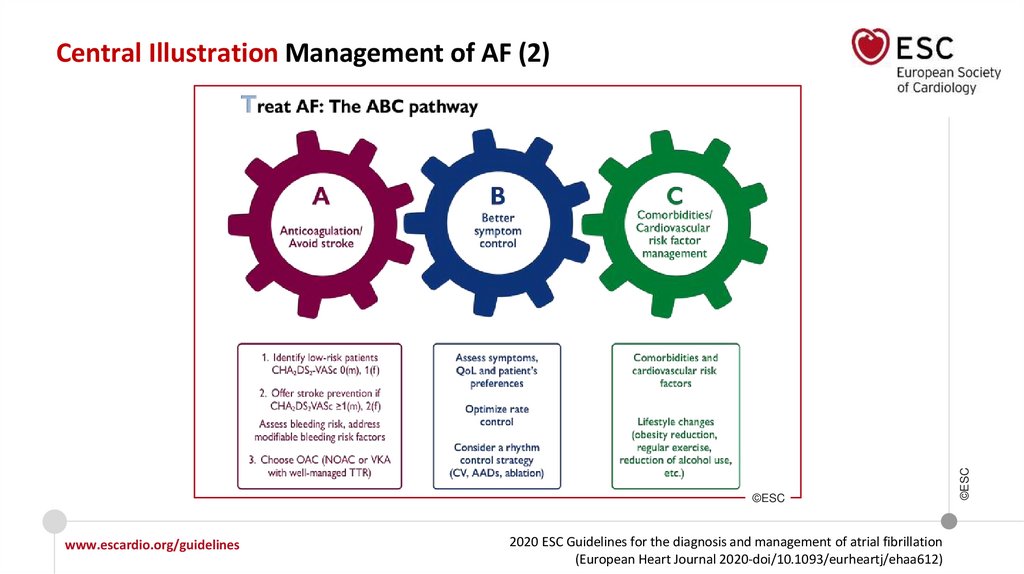
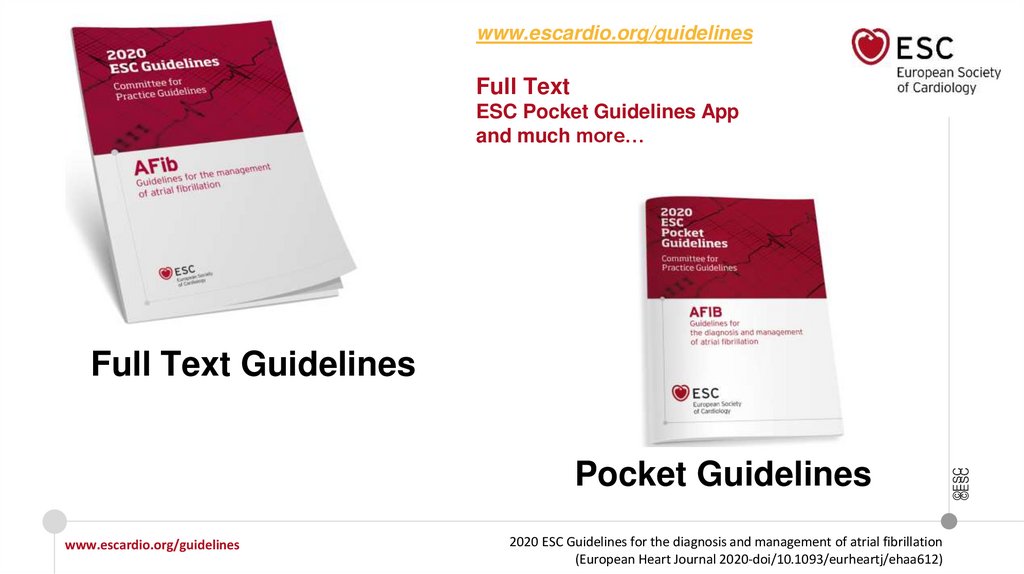
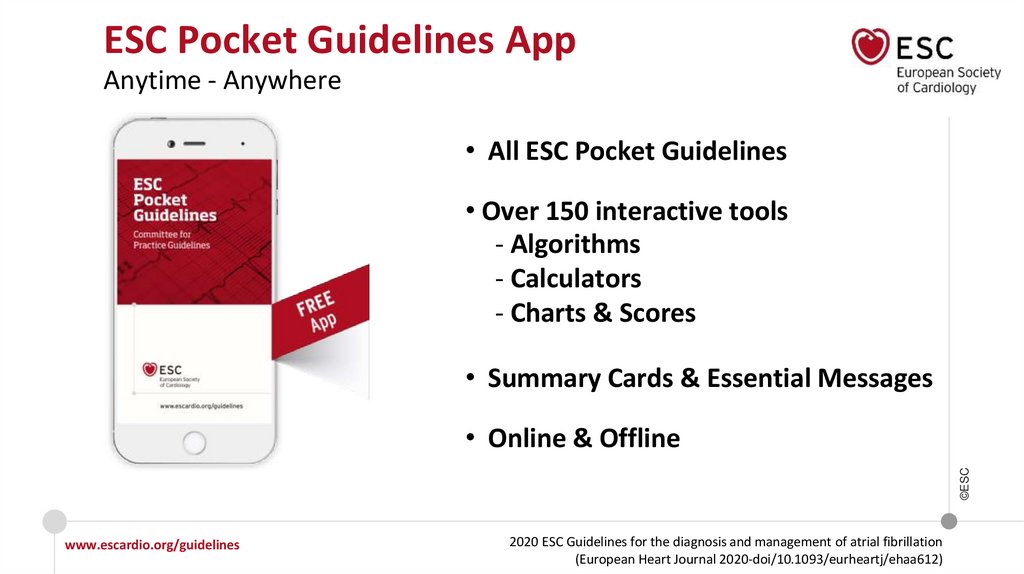
 medicine
medicine








